Wild Wyoming, Part 3: Yellowstone National Park
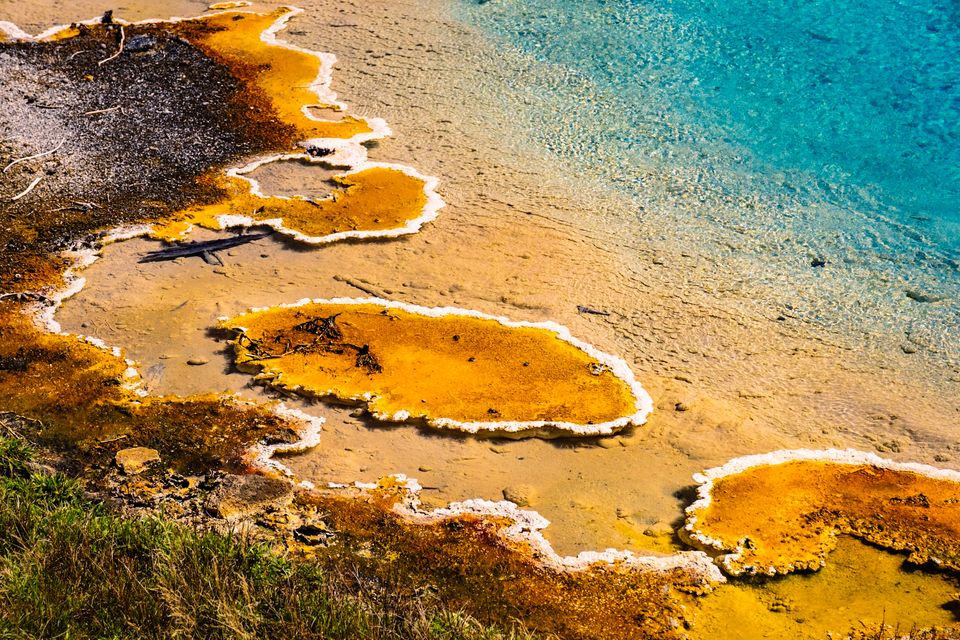
Because of its extreme popularity, I never had Yellowstone super high on my list. I didn't think fighting huge crowds of people and traffic (in a national park, where you want to be peaceful and one with nature) would be worth it.
I was wrong, of course. The first national park is iconic for a reason. It's like you're on a safari... in one of the prettiest and most wild places you can think of... and you're also on another planet. One that could explode at any moment.
So, I wouldn't skip Yellowstone. You definitely have to plan for the crowds and chaos at times, but it's not so bad if you expect it and roll with the punches. And you'll get to see some things that you can't see anywhere else. That's the main appeal of Yellowstone, I think – we saw parks that were more beautiful on our trip, but nowhere as unique.
Anyway, we spent one week here that was too short but jam-packed. Here it is!
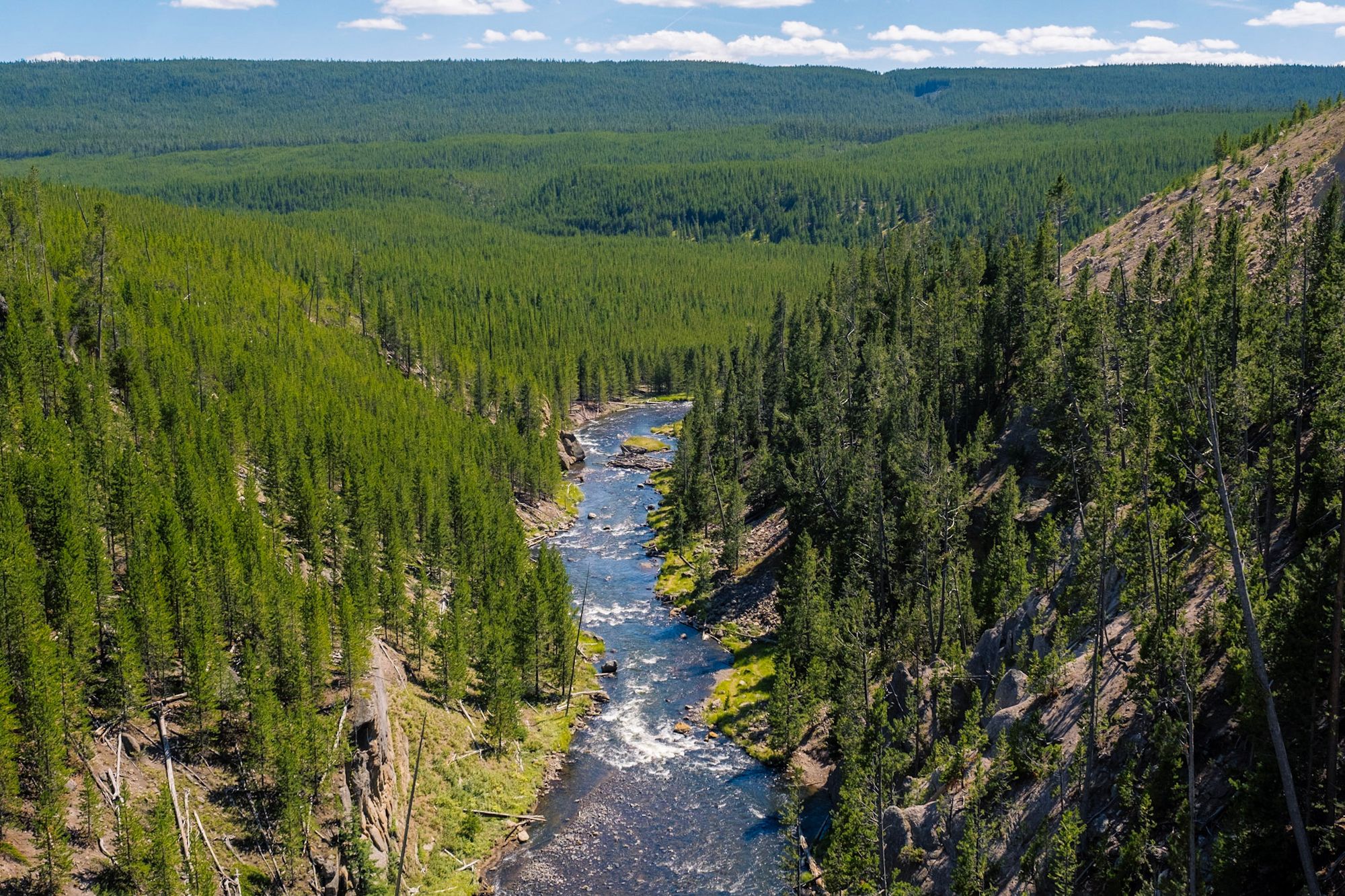
5 Things We Learned
1) Yellowstone is HUGE
Each side of the park is a solid 2-3 hours away from the opposite side. The main attractions in the park are spread far apart from each other. You have to plan more time than you think you need in Yellowstone, and you'll be driving a lot.
2) Expect traffic jams and bison jams
It's not just the distance contributing to the long travel times. There's traffic in the most popular areas due to people flocking there and fighting for parking (and waiting in line for ages to GET parking). There's also traffic due to construction – since they can't fix the roads during the harsh, snowy winters (that linger late into spring) they have to do it during peak tourism season. We learned how much this can disrupt things the hard way.
And finally, there's traffic due to good old bison jams (and other wildlife jams). If one person sees wildlife next to the road (sometimes even just a deer!) they will slow down to take pictures, or stop entirely. Then the next person does the same thing. By the time you get there, the wildlife might be gone. I’m not judging people here (except the deer photo people) since we also definitely stopped for wildlife pics. And sometimes the wildlife, especially bison herds, just get in the way and block the road for a while.

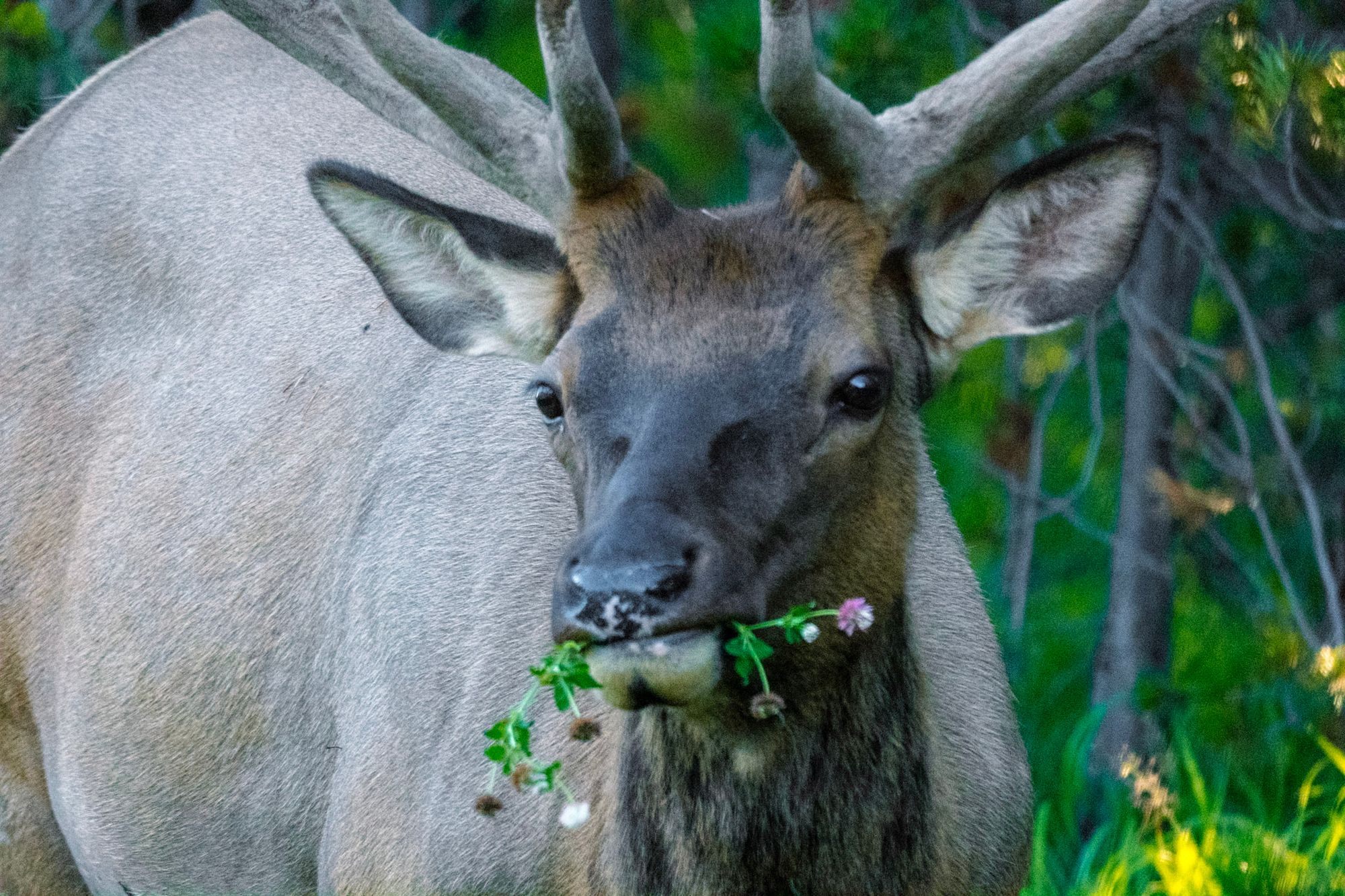
This adorable guy held up traffic for a while. He had cool antlers, so it's okay.
3) Dogs don't love wildlife...
We had Hollie with us, and once we got to our campsites, we mostly left her in the RV while we explored Yellowstone. It's not pet-friendly – dogs aren't allowed on any trails, just in the parking lots or in cars. We took her on drives sometimes, but we'd inevitably see wildlife and she'd freak out about the bison or whatever (understandable but annoying haha). So don't bring your pet, or plan on leaving them where you're staying most of the time!
4) Embrace being off-grid
We got used to this as we got further out west, but except for a few specific areas or the public Wi-Fi at visitor centers/hotels, you probably won't have internet or cell service at Yellowstone. And sometimes you won't have it even outside the park – the areas right outside the east entrance (from Cody, WY) and northeast entrance (Cooke City, MT) didn't have any internet either. When we stayed in tiny Cooke City, we relied on the one place with public Wi-Fi for work: the town visitor center. That side of the park is way more remote than the west side, so there weren't as many people around, but the ones staying in Cooke City would all flock to the visitor center to use the Wi-Fi to make calls, check their texts and emails, and (in our case) get some work done.
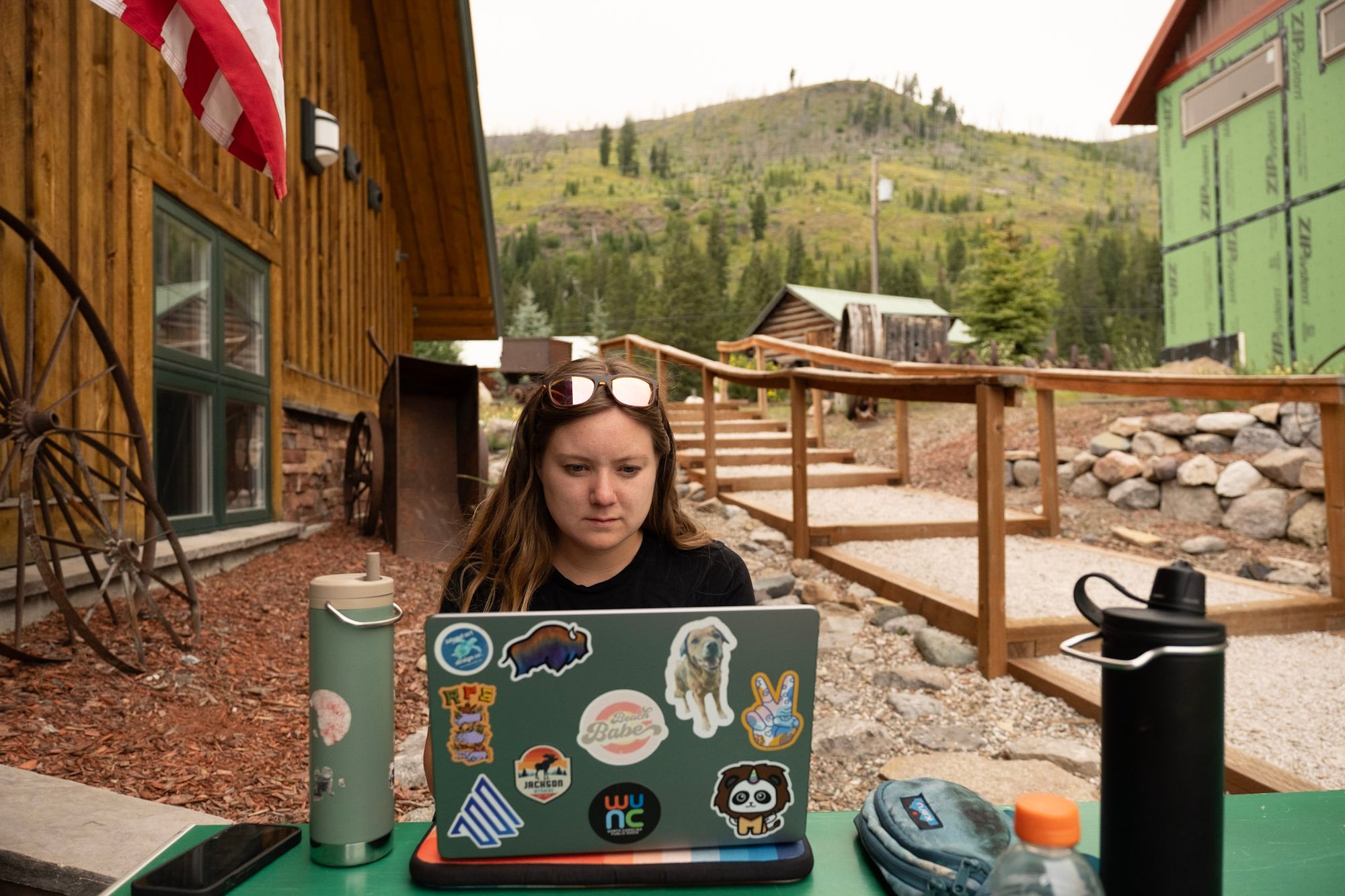
5) The Yellowstone Supervolcano
I definitely recommend reading more about this topic (or listening to the Exploring the National Parks podcast's Yellowstone Fun Facts episode, which is where we learned a bunch of crazy facts). To sum up, Yellowstone is a giant, still active volcano, and the evidence is all over the park in the form of geysers, hot springs, mud pots, and steam vents. Some of these have emerged or moved within the past 100 years! It's a "supervolcano" because it's massive – one of its past eruptions was 6,000 times the strength of Mt. St. Helens. The earth beneath Yellowstone is always changing, the magma is close beneath the surface, and someday (probably a long time from now, but who knows) it will erupt again. It's a little unsettling when you're there and see all the weird volcanic activity.

West Yellowstone
Camping
If you're going to spend a while in Yellowstone, it helps to stay in a couple different locations to more easily check out different areas of the park. We spent the first half of the week on the western side of the park, which is the most popular area.
We camped at Red Rock RV Park in Island Park, Idaho, which is about 30 minutes from the town of West Yellowstone and the west park entrance. It was a normal, but very nice, RV park with great mountain views all around, helpful staff, full hookups, and a dog park. Even though it was a little far outside Yellowstone, it was a good base for exploring, and it was nice to have hookups again after dry camping for a week in Grand Teton.
Nearby, there was a rough dirt road leading to a lake. We took the truck down it one night to see the sunset, and we saw a few campers – it was BLM land. We wouldn't be able to get there with the Airstream, but it looked like a great spot.
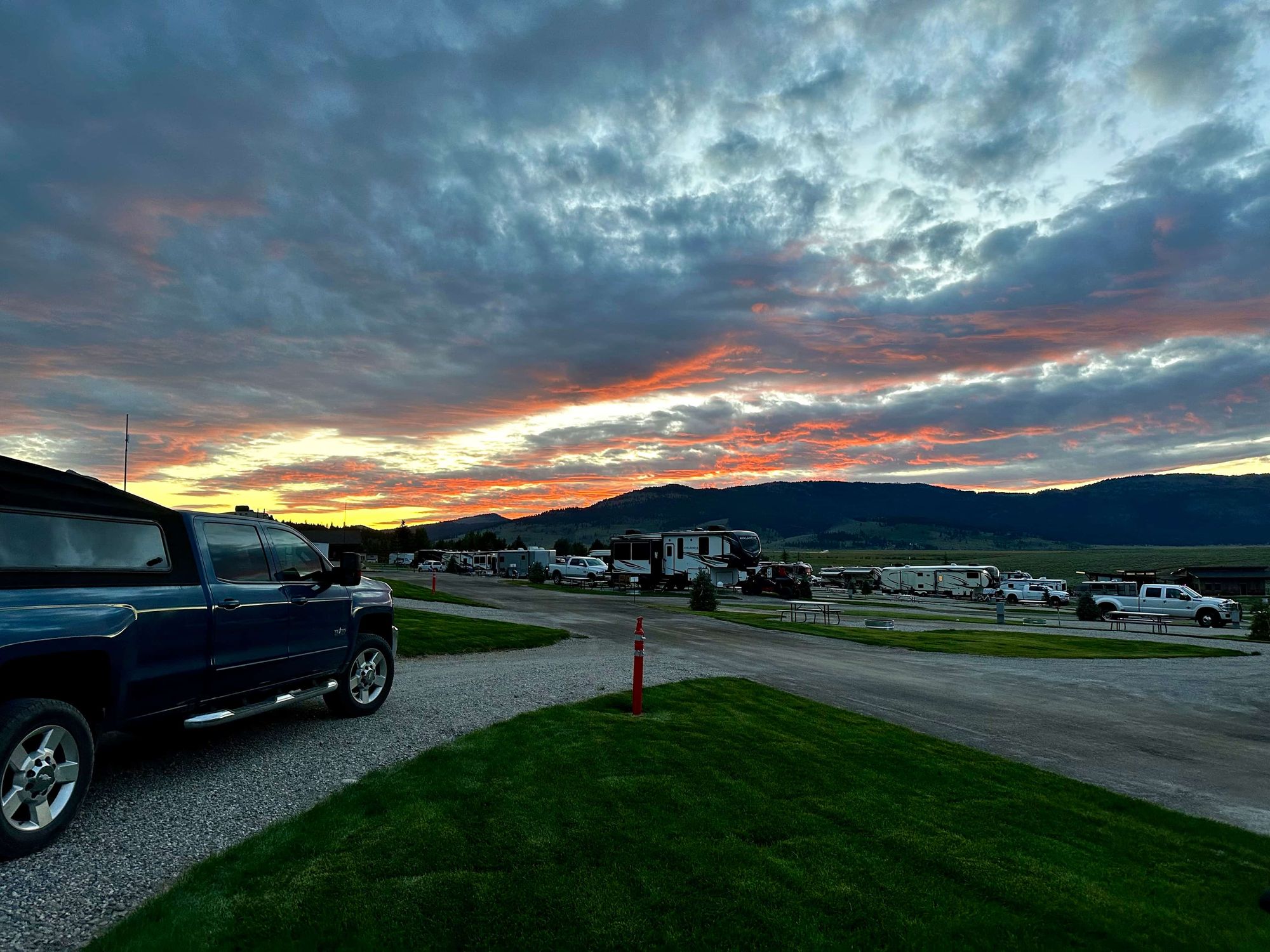

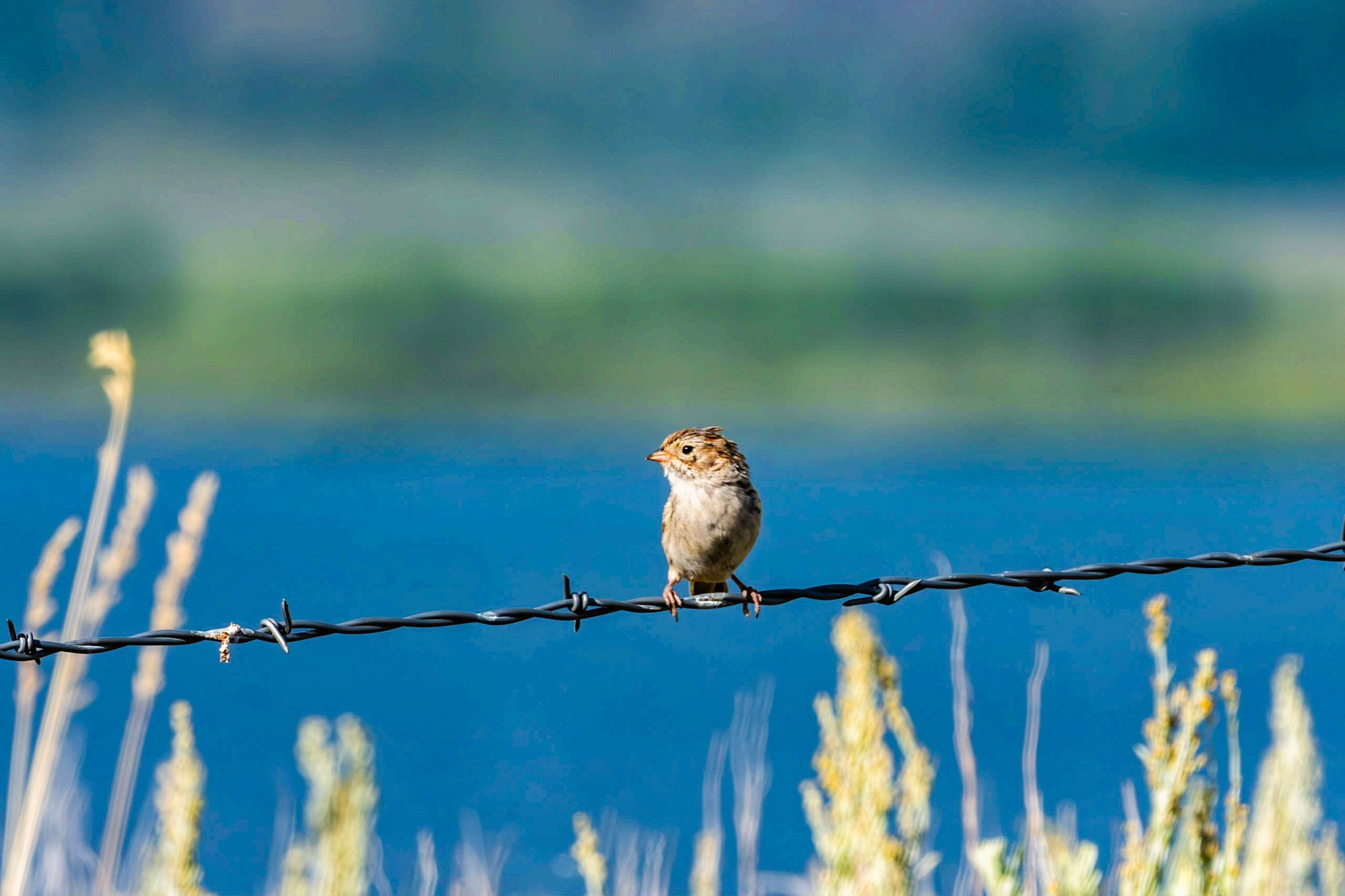
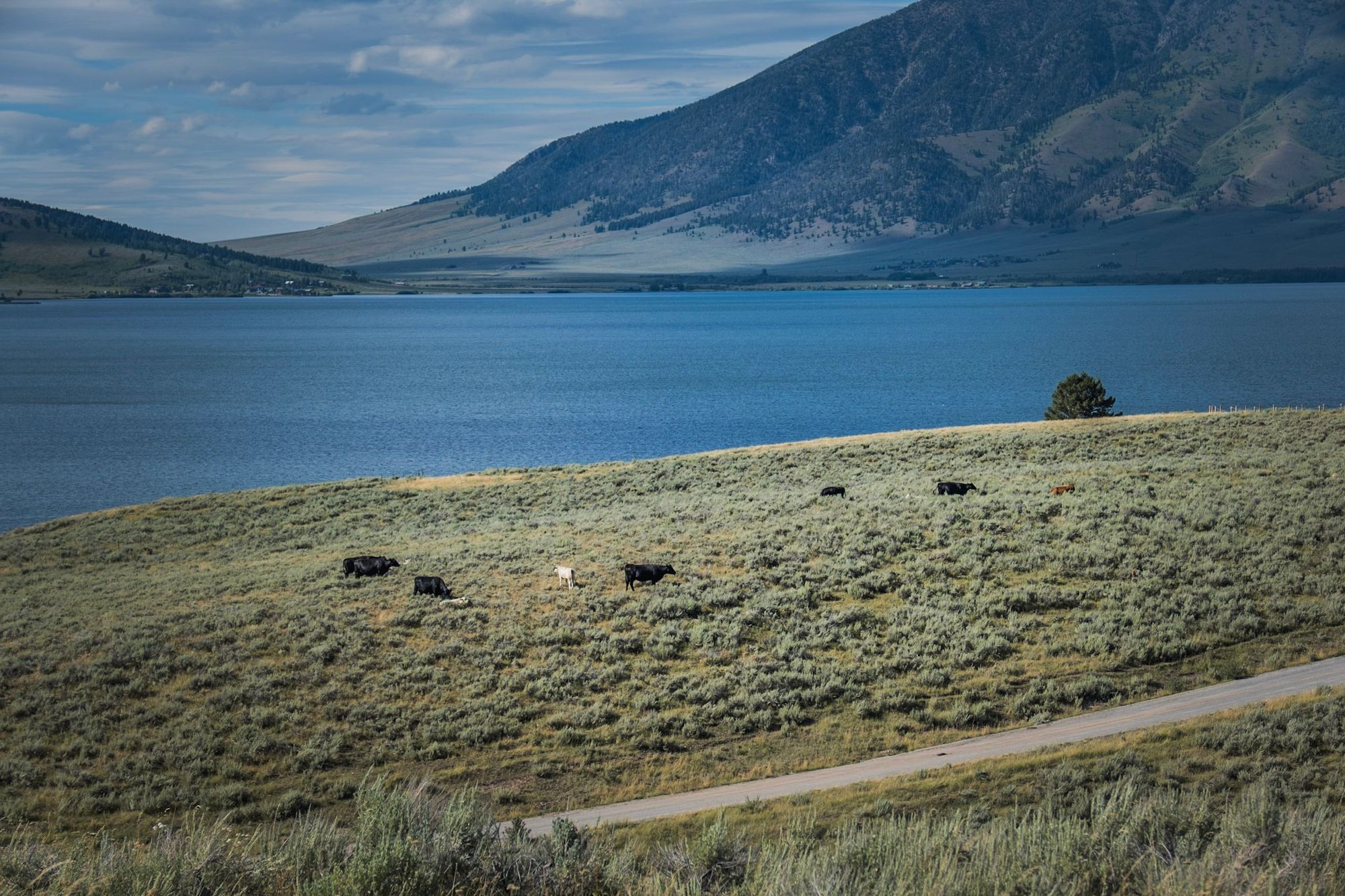
Red Rock RV Park & the lake nearby
Meteor Shower at Old Faithful
Our first night in Yellowstone was one of our favorite memories from this year. It was Saturday night, the Perseids meteor shower was happening, and we got to watch it at Old Faithful.
Around 9pm we picked up pizza and beer in West Yellowstone, drove into the park, and set up our chairs and camera on the boardwalk next to the geyser. We were worried about it feeling sketchy in the dark, but the area around Old Faithful is super developed (no huge surprise I guess) – big parking lot, sidewalks, visitor center, hotel. And there were several people who came and went throughout the night, watching the geyser and stars with us, so it was a great place to hang out. We were there until about 2 am, around the peak meteor shower time, and then left because we started to get pretty cold. It was like 40 degrees at night in August!
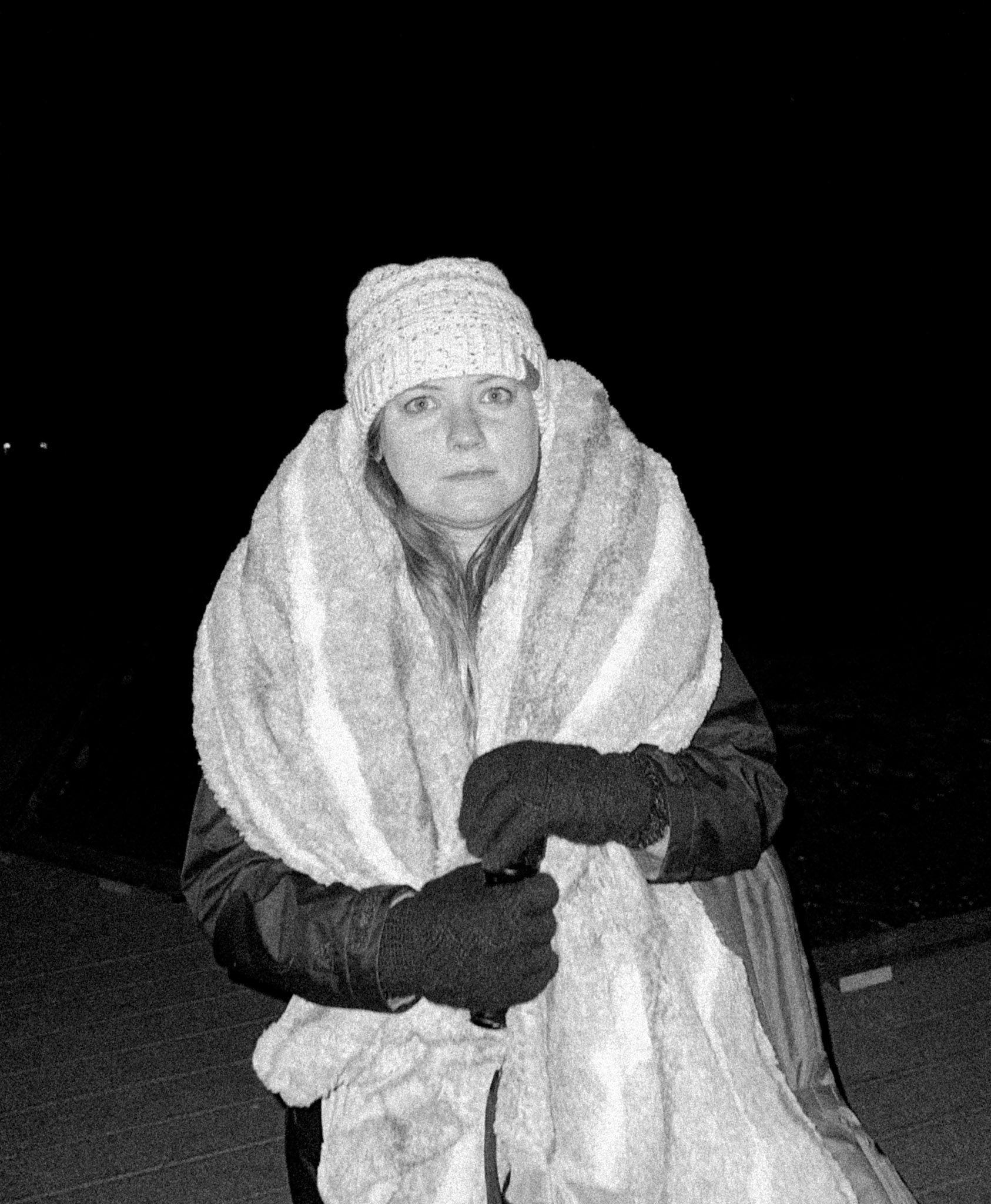
Old Faithful erupts every 90ish minutes, and the first time seeing it was amazing. Even at night, you could see it in the light from some of the surrounding buildings. It was loud and bigger than I expected – the anticipation leading up to it and then the eruption itself was a really, really cool moment. And the meteor shower and the thousands of stars above just made it even better.
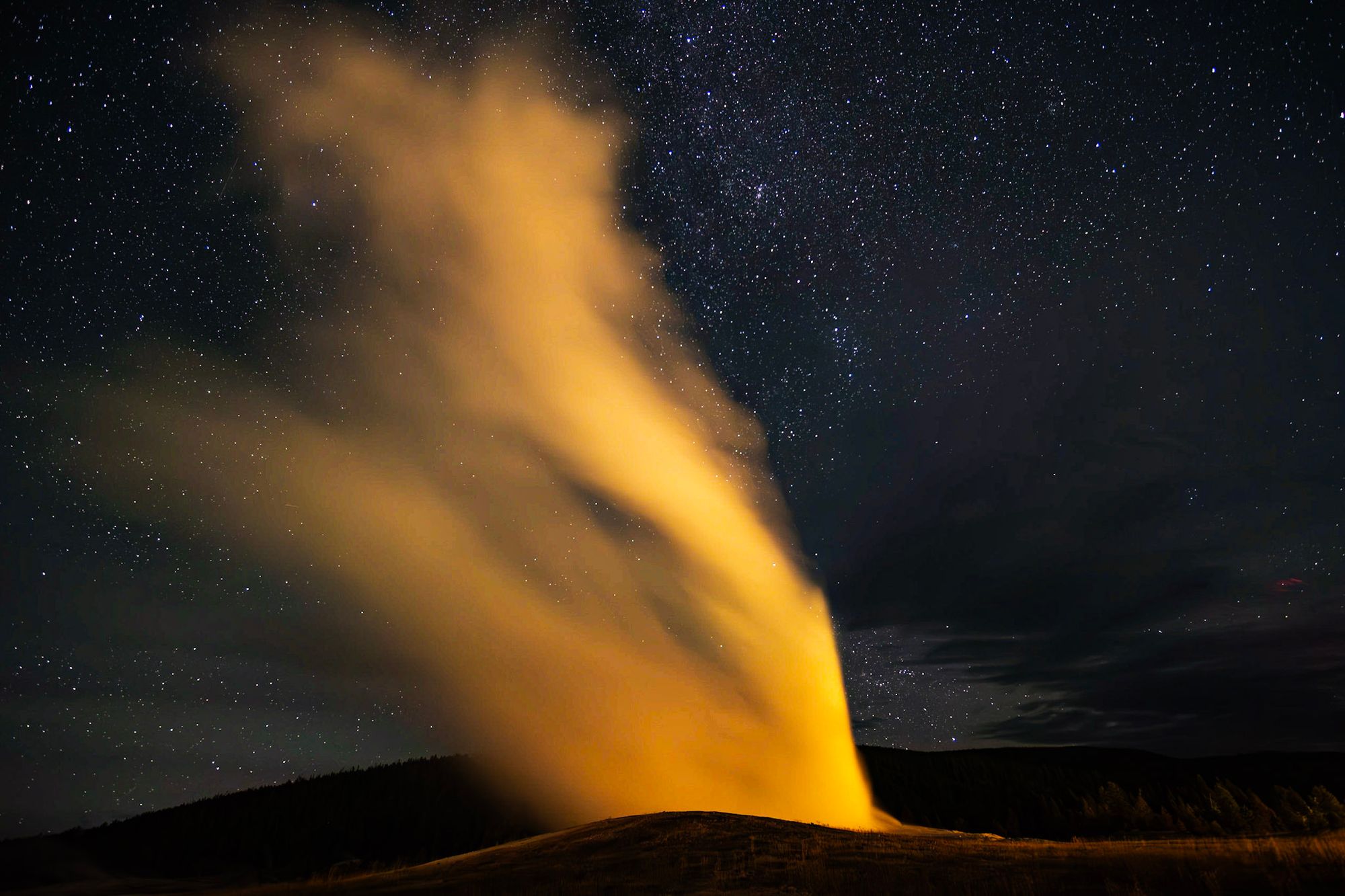
More Supervolcano Evidence
The western part of Yellowstone includes most of the volcanic activity that it's known for: the geyser basin, hot springs, mud pots, etc. This is the most otherworldly area of the park, where you sometimes feel like you're on another planet. You drive along and see geysers erupting in the distance, random bursts of steam coming out of the ground right next to the road, and unnaturally bright, colorful rocks with hot water running down them.
We went back to see Old Faithful in the daylight, but this time hiked up the Observation Point trail to watch it from above. It was a cool view (and much less crowded) but if you're only going to see it once, I'd recommend being closer.
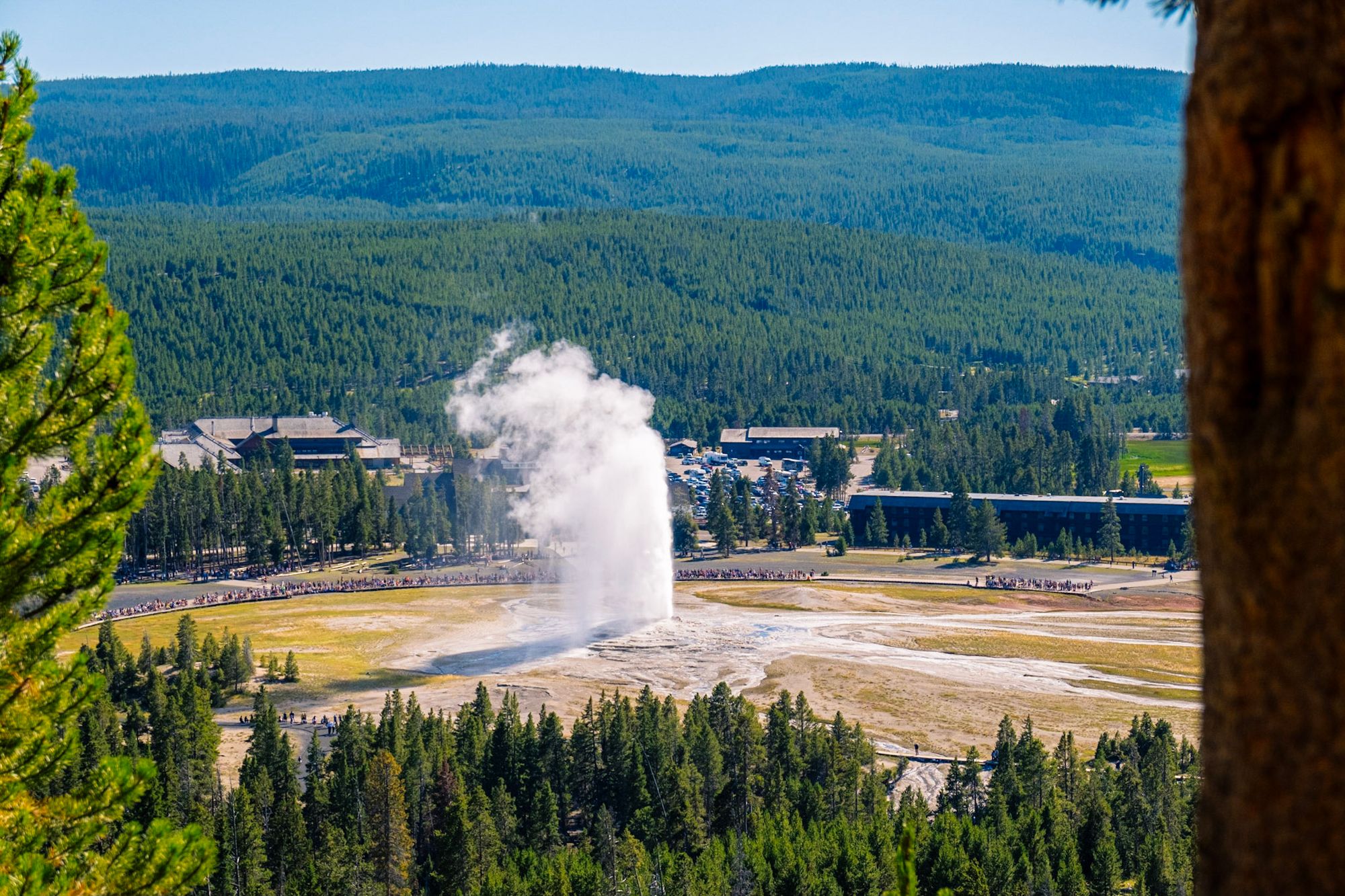
We walked around the Upper Geyser Basin, a boardwalk trail that weaves through several other geysers and hydrothermal features nearby. There are over 500 geysers in Yellowstone (!) some of them small and some of them much bigger than Old Faithful. The larger ones tend to be more rare and unpredictable, so we sadly didn't get to see those erupt. But it was really cool seeing some of the others, and all the weird features in general.
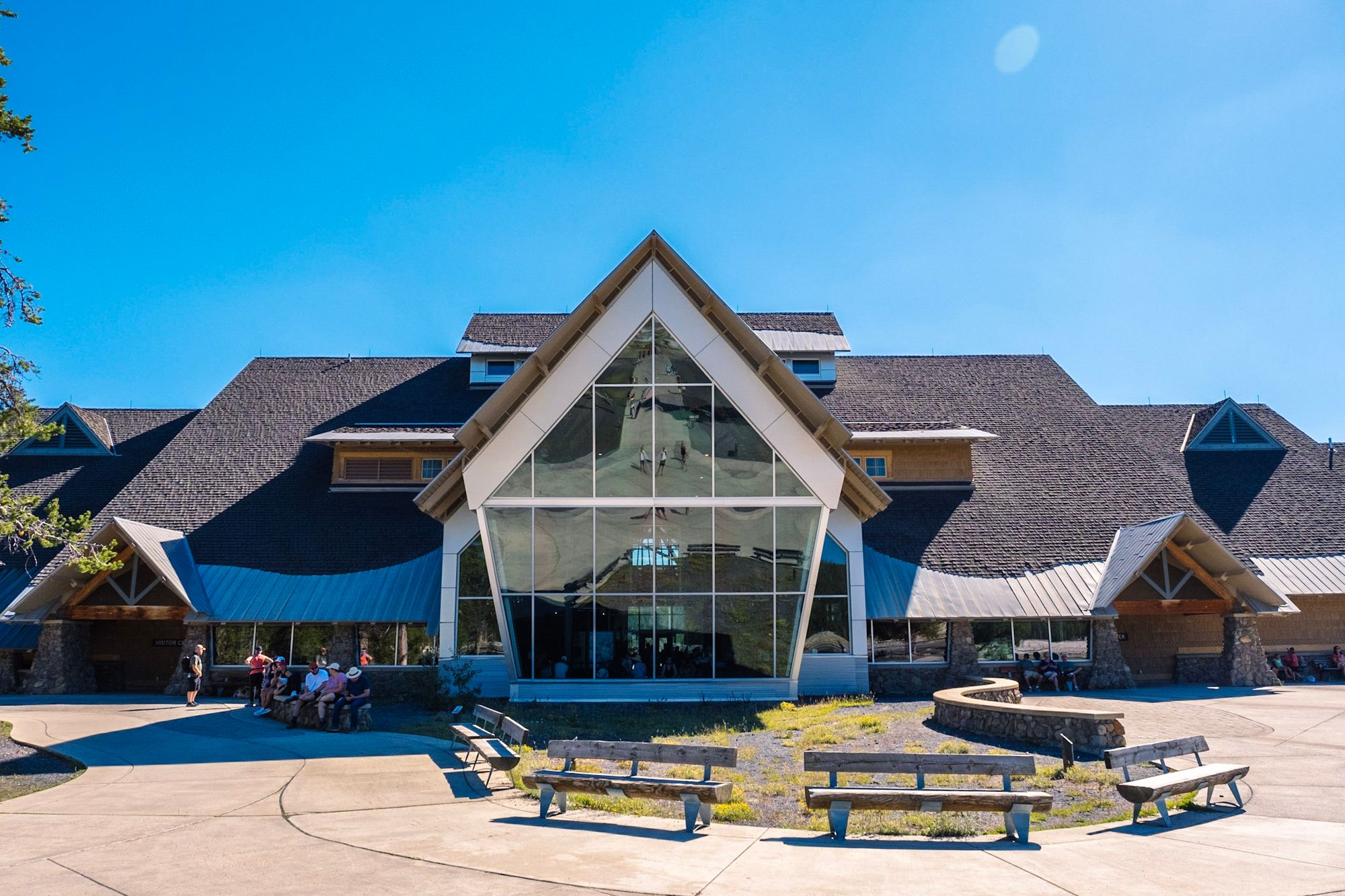
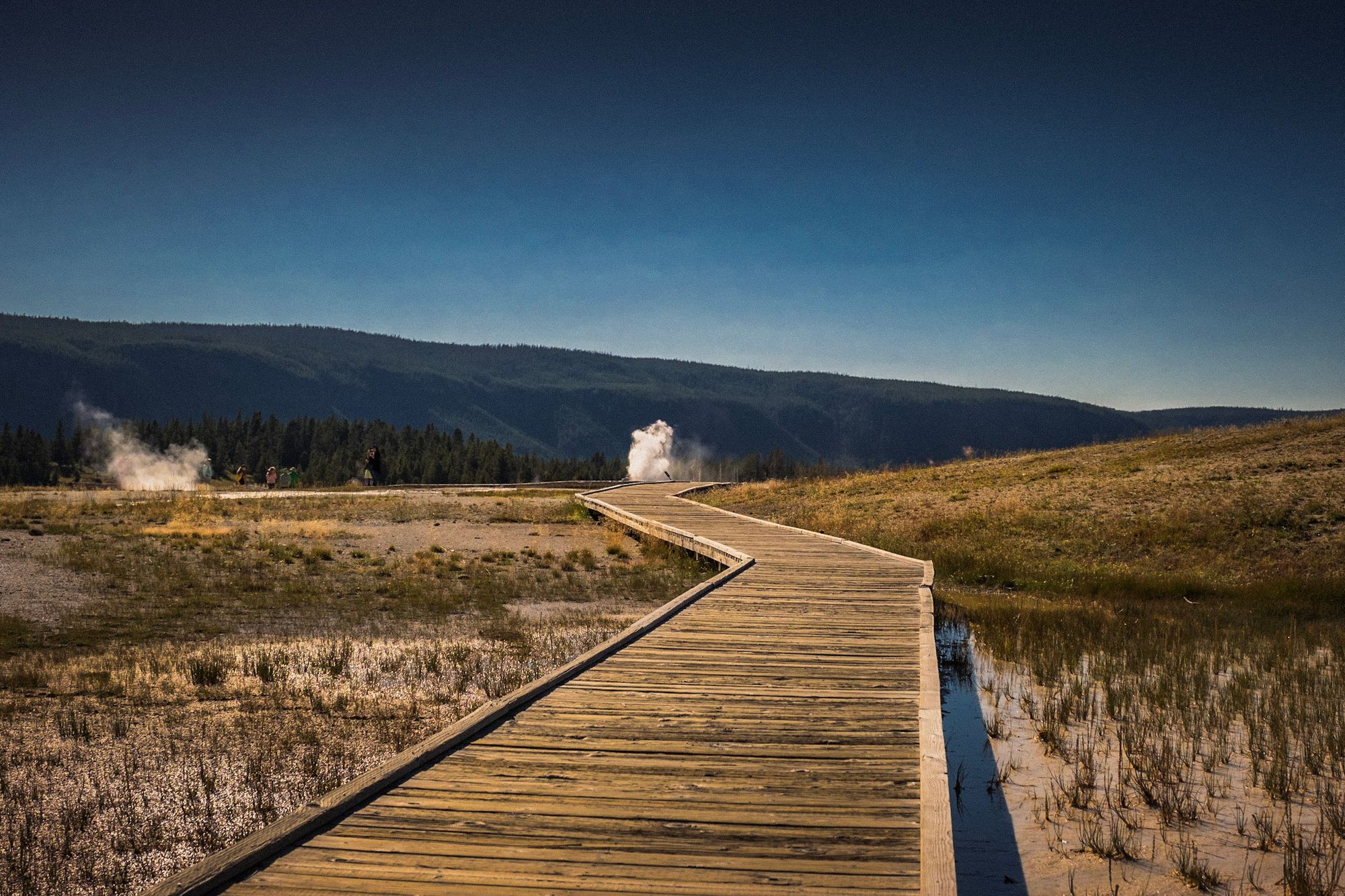
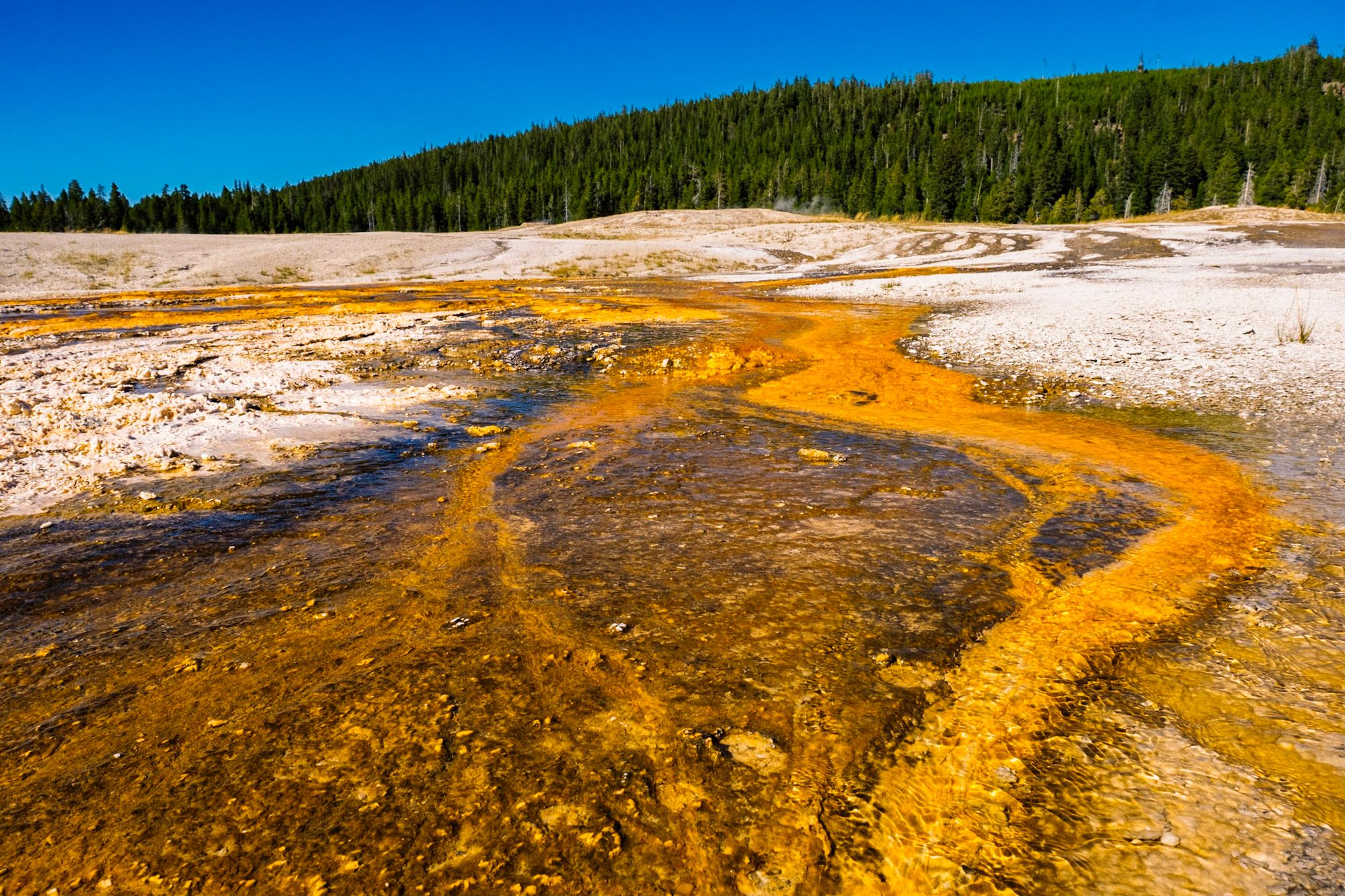
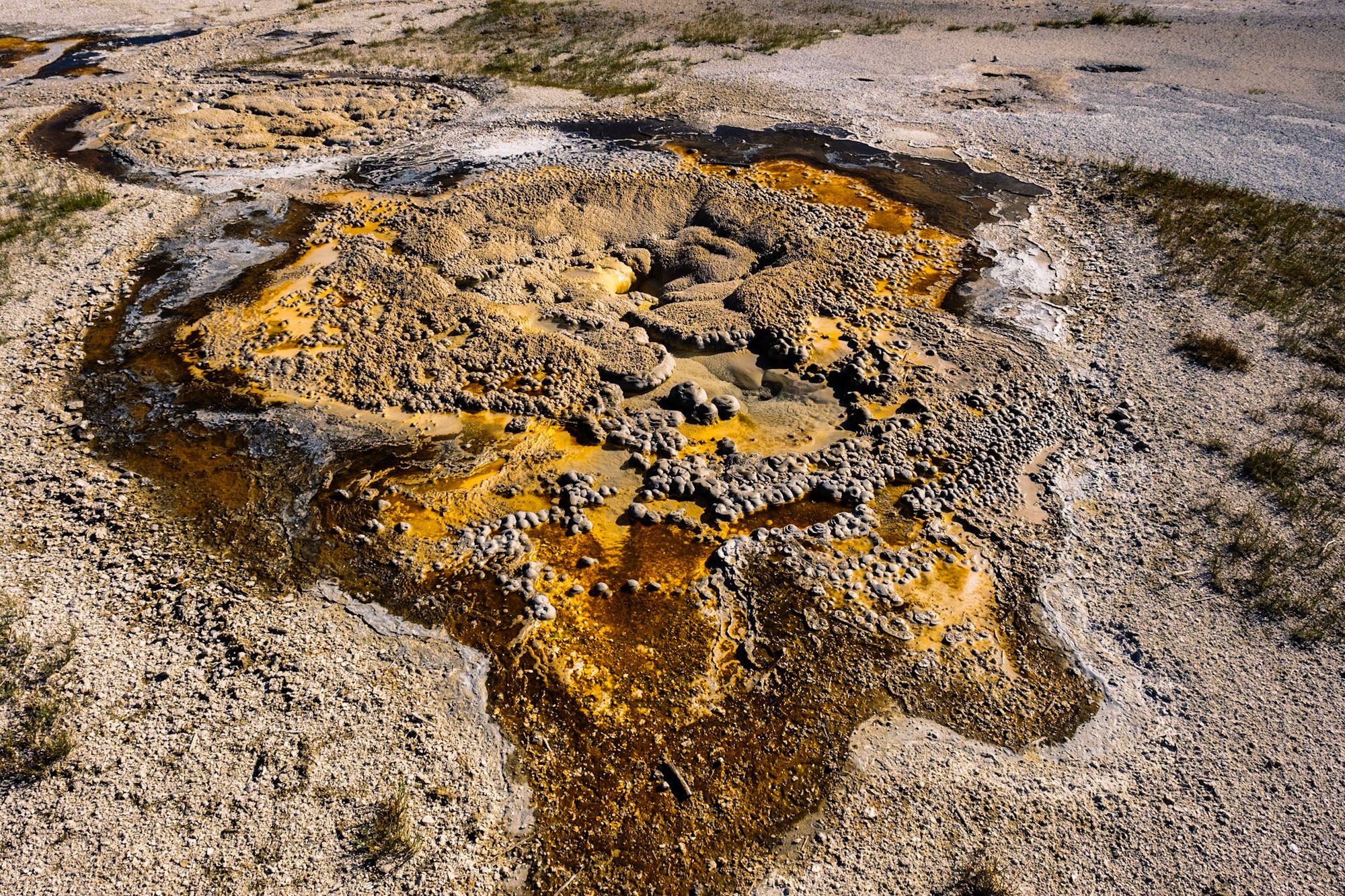
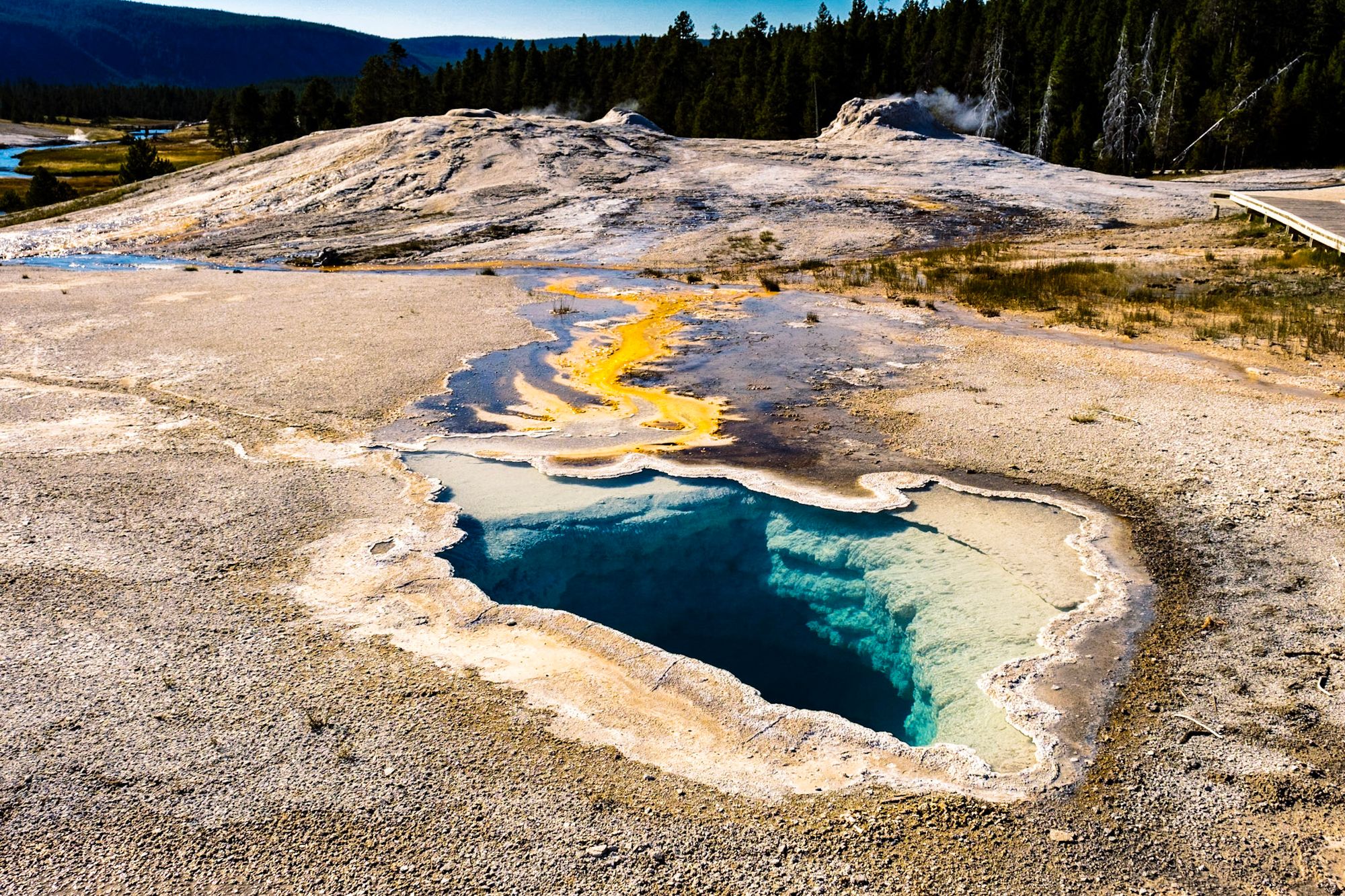
The Old Faithful Visitor Center, and some of the hydrothermal features nearby
Down the road were some other geyser basins and volcano-y areas to explore. The Fountain Paint Pot Trail had more geysers, crystal-clear blue springs, and fun, bubbling pools. A bit further away, the Mud Volcano area had boiling hot mud bursting up from the ground and smelled extremely sulfur-y.
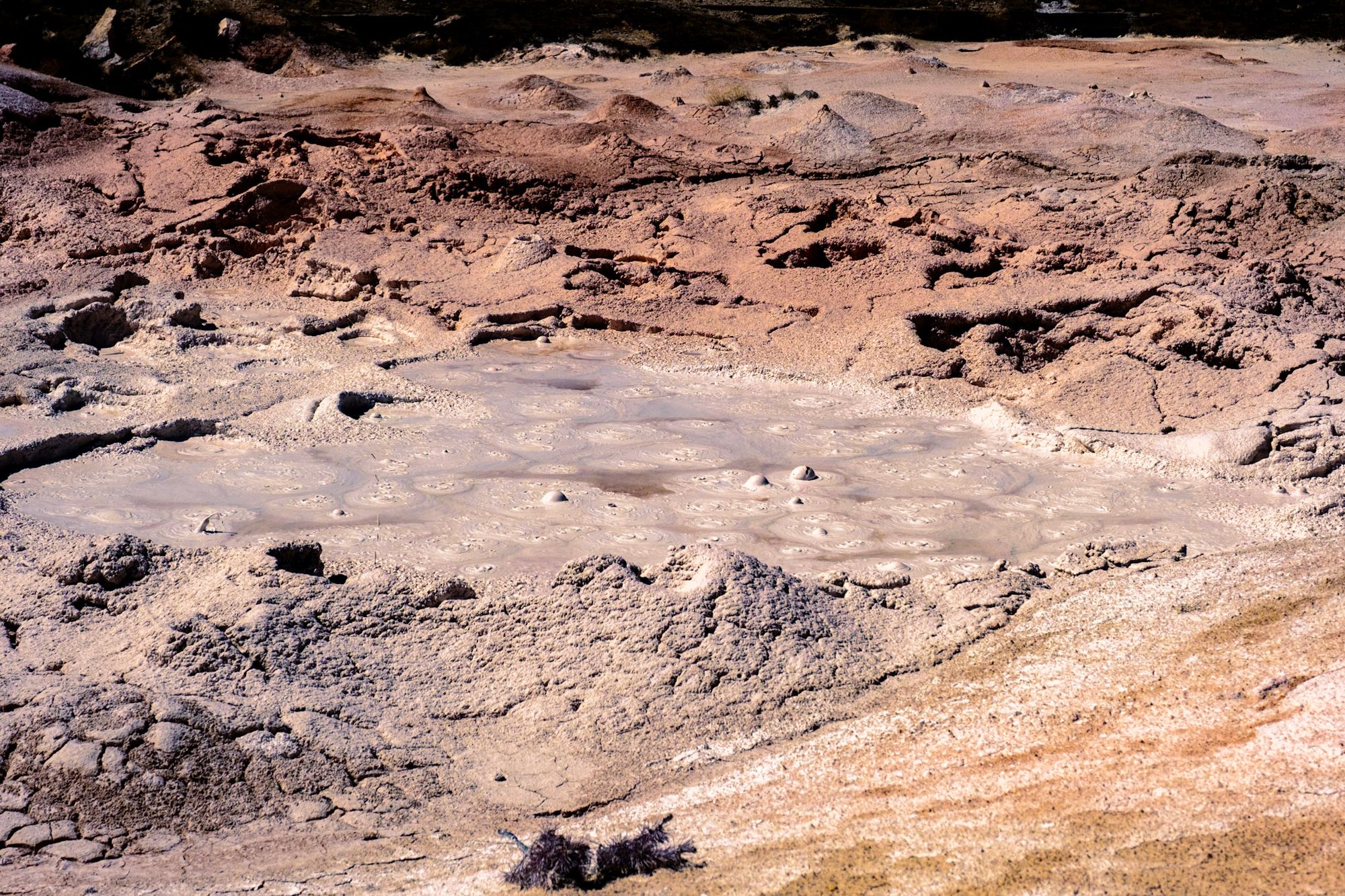
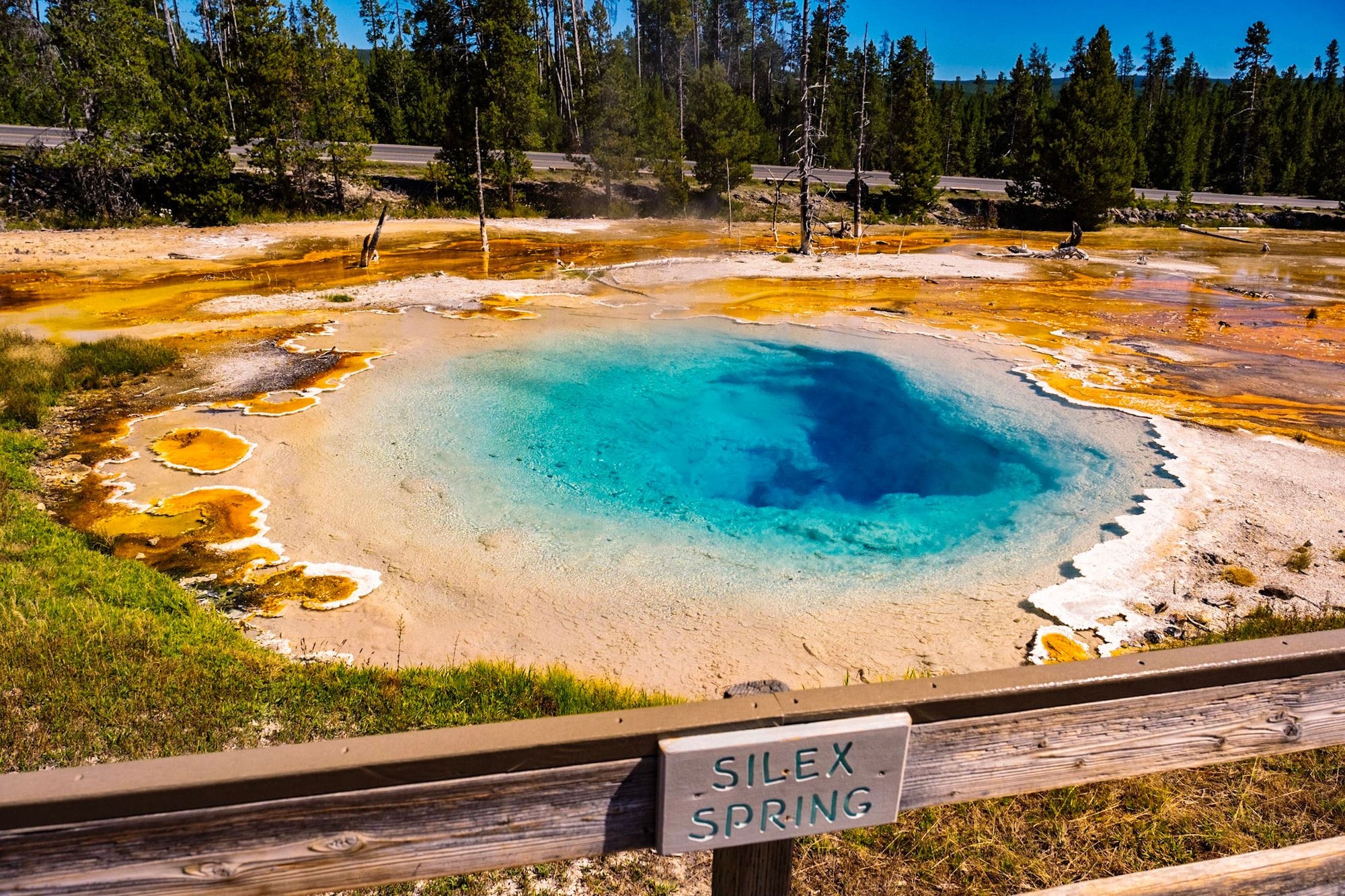
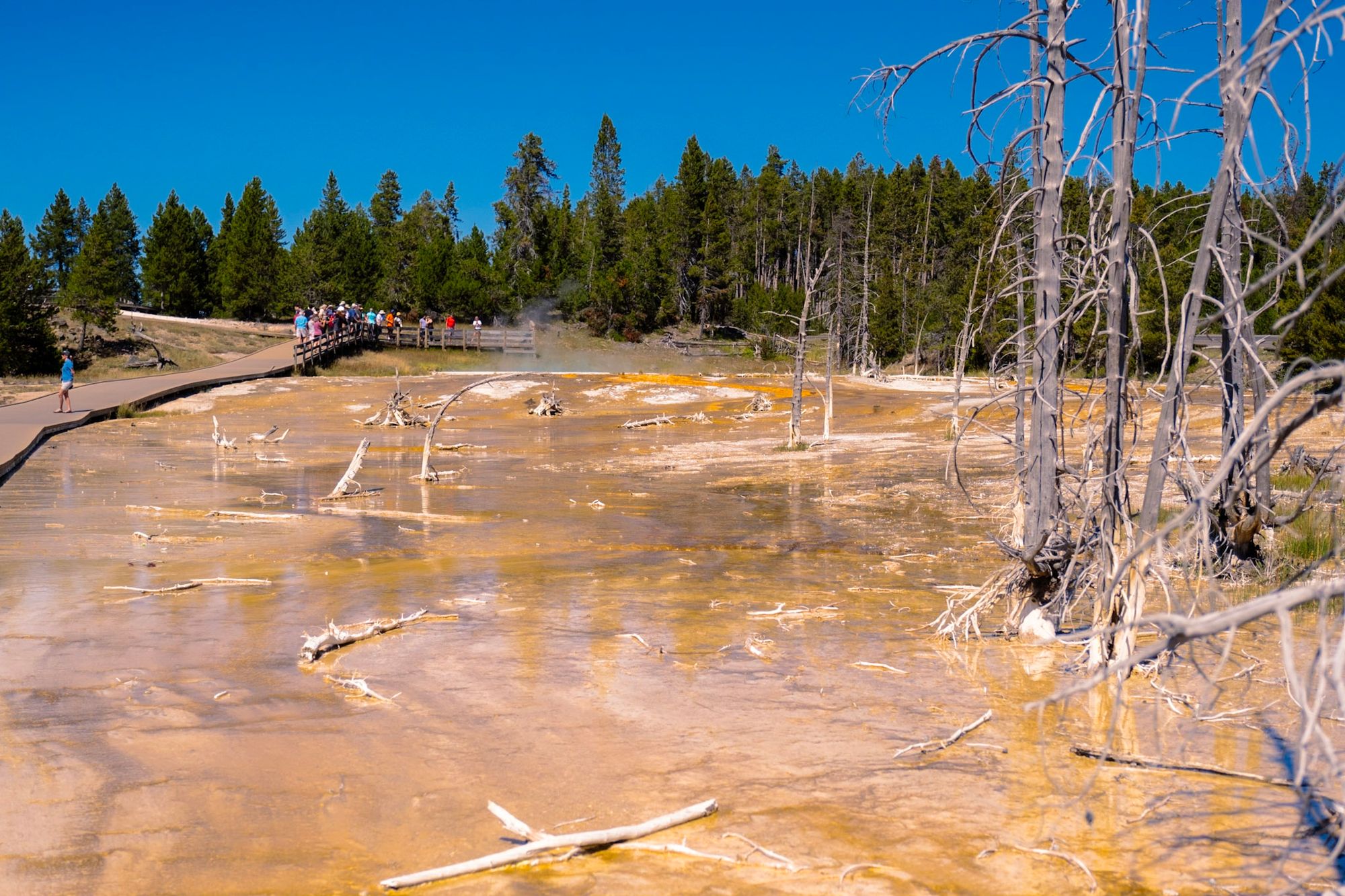
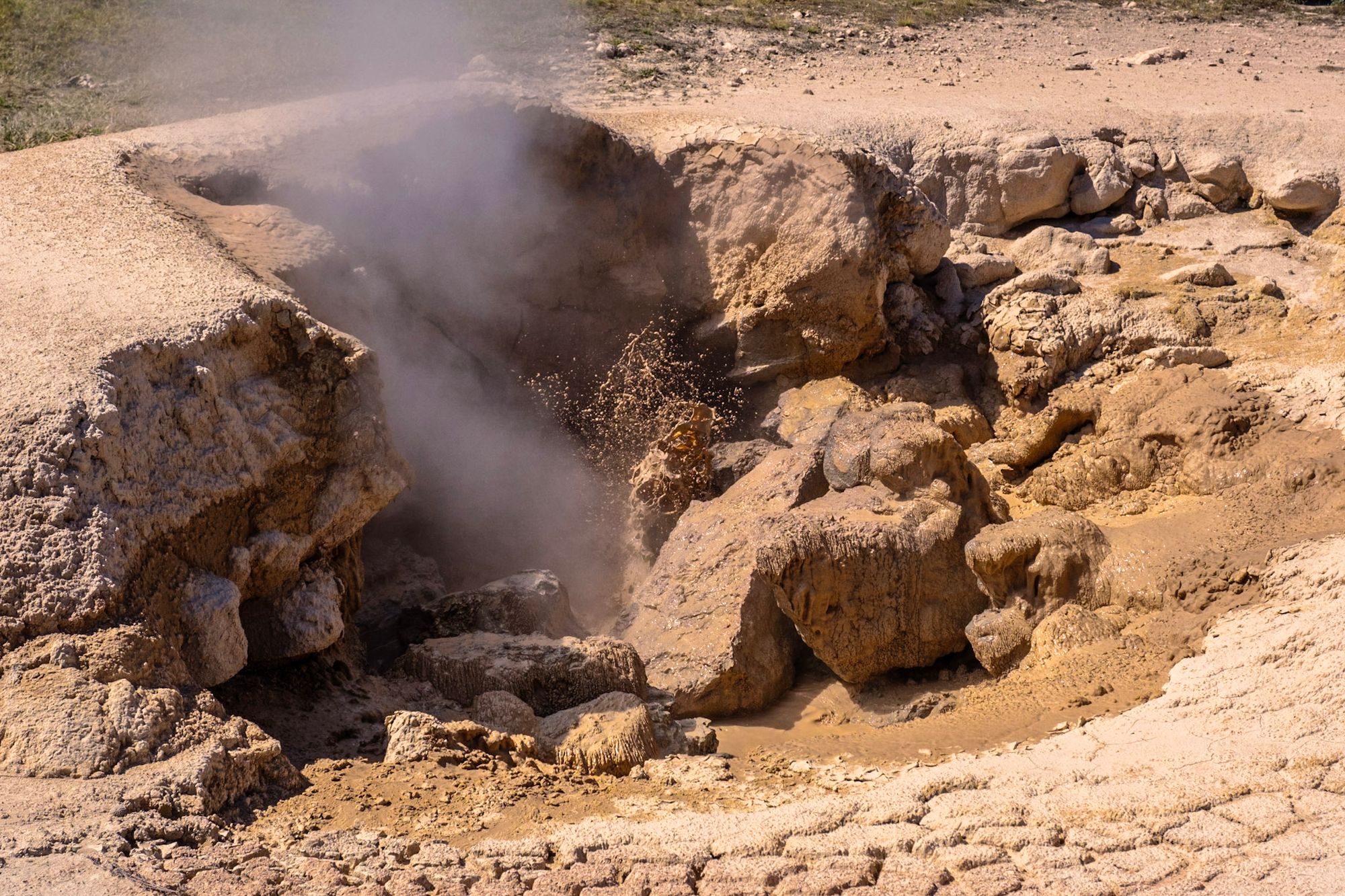
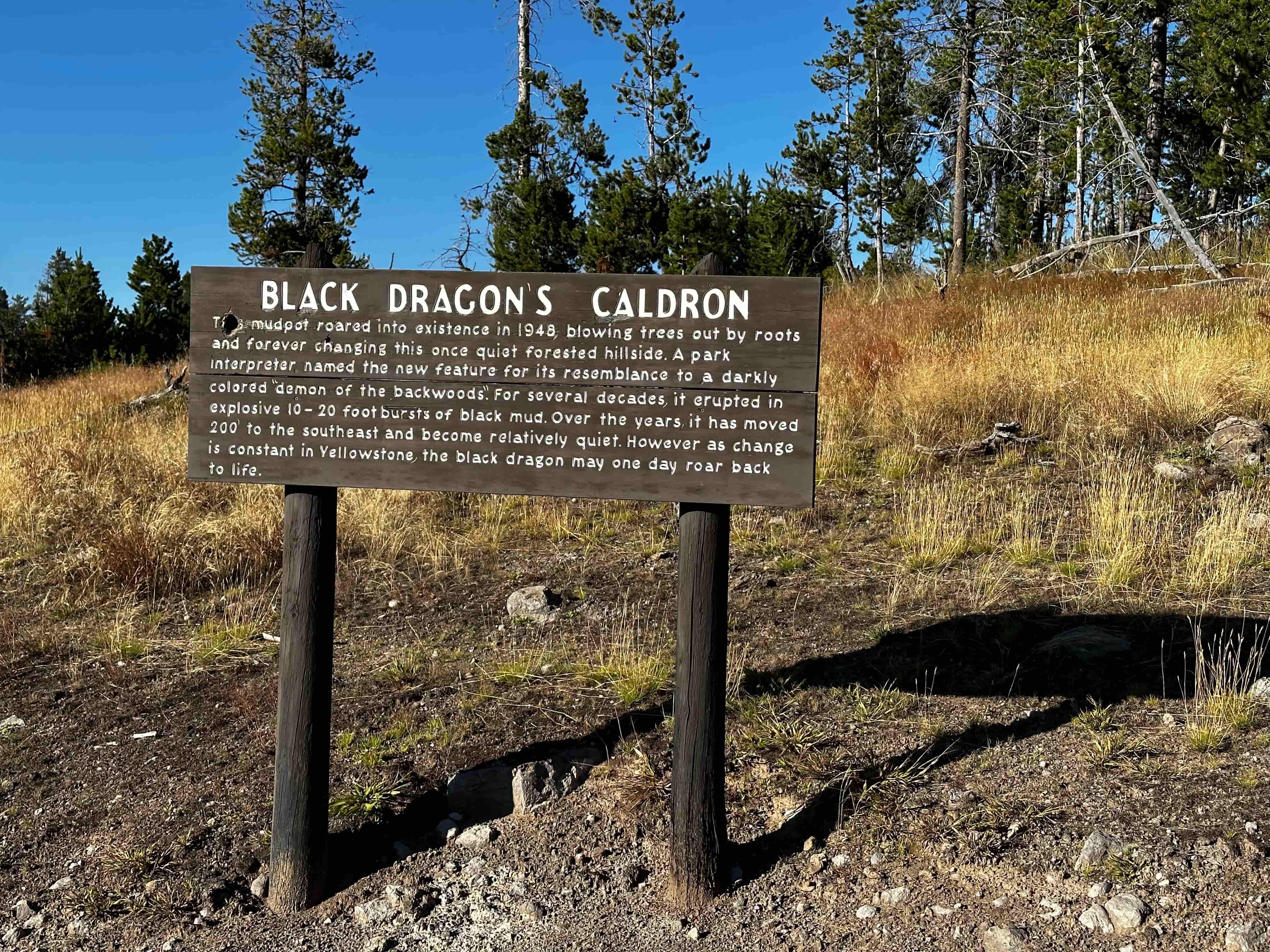
Finally, we visited Grand Prismatic Spring. On the way, you cross the Firehole River, which has streams of water from the hot springs running down its banks.
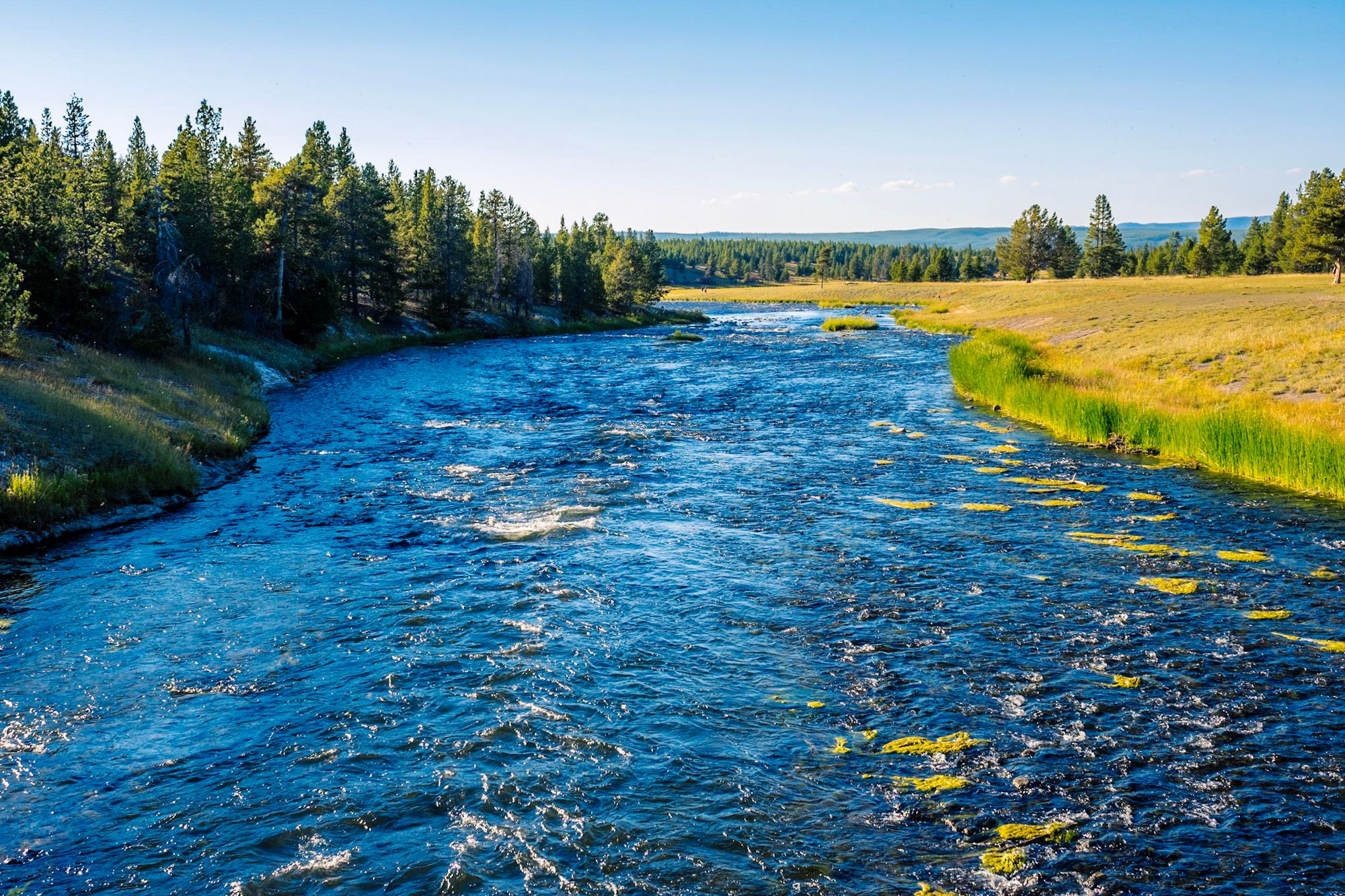
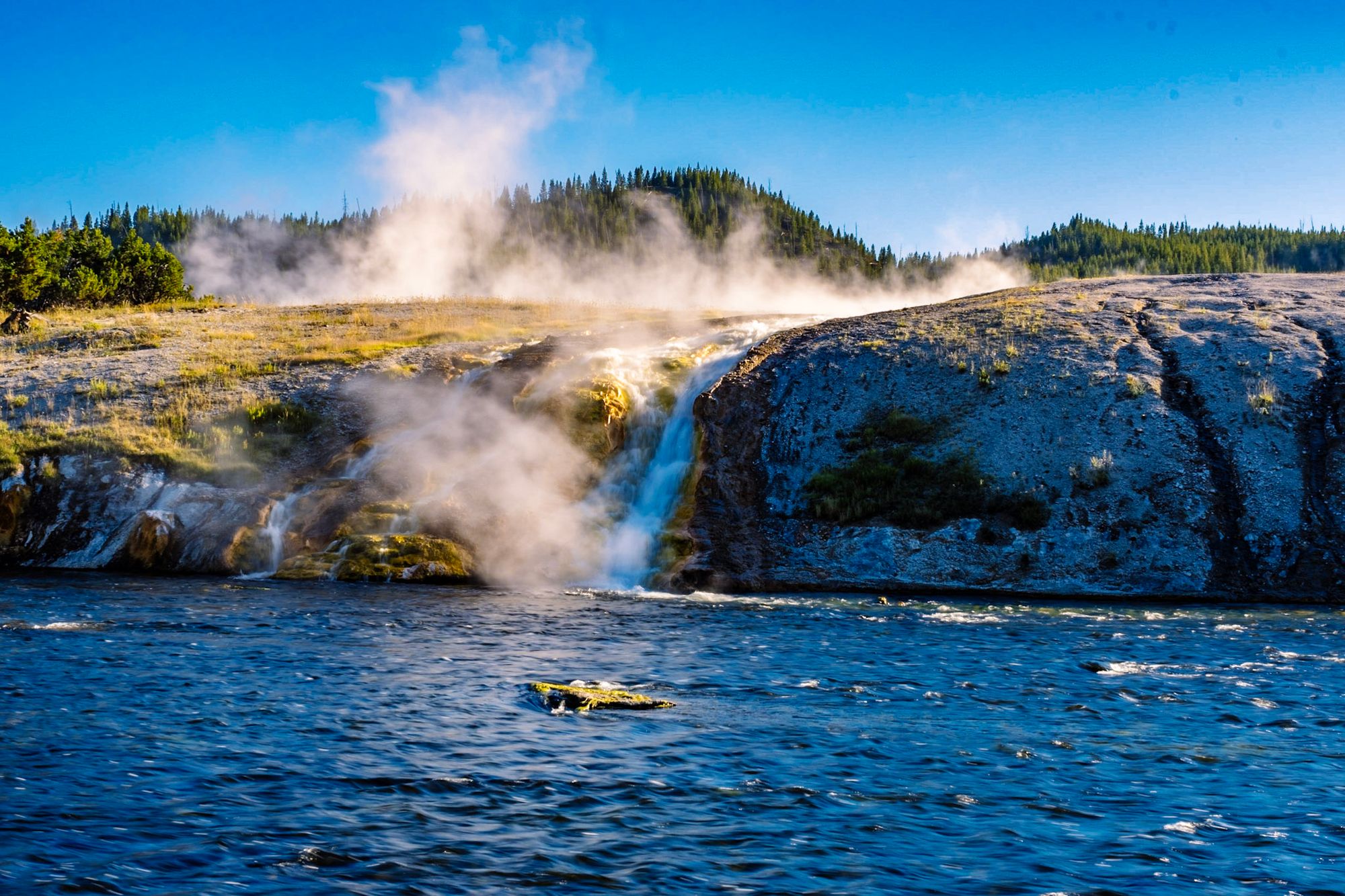
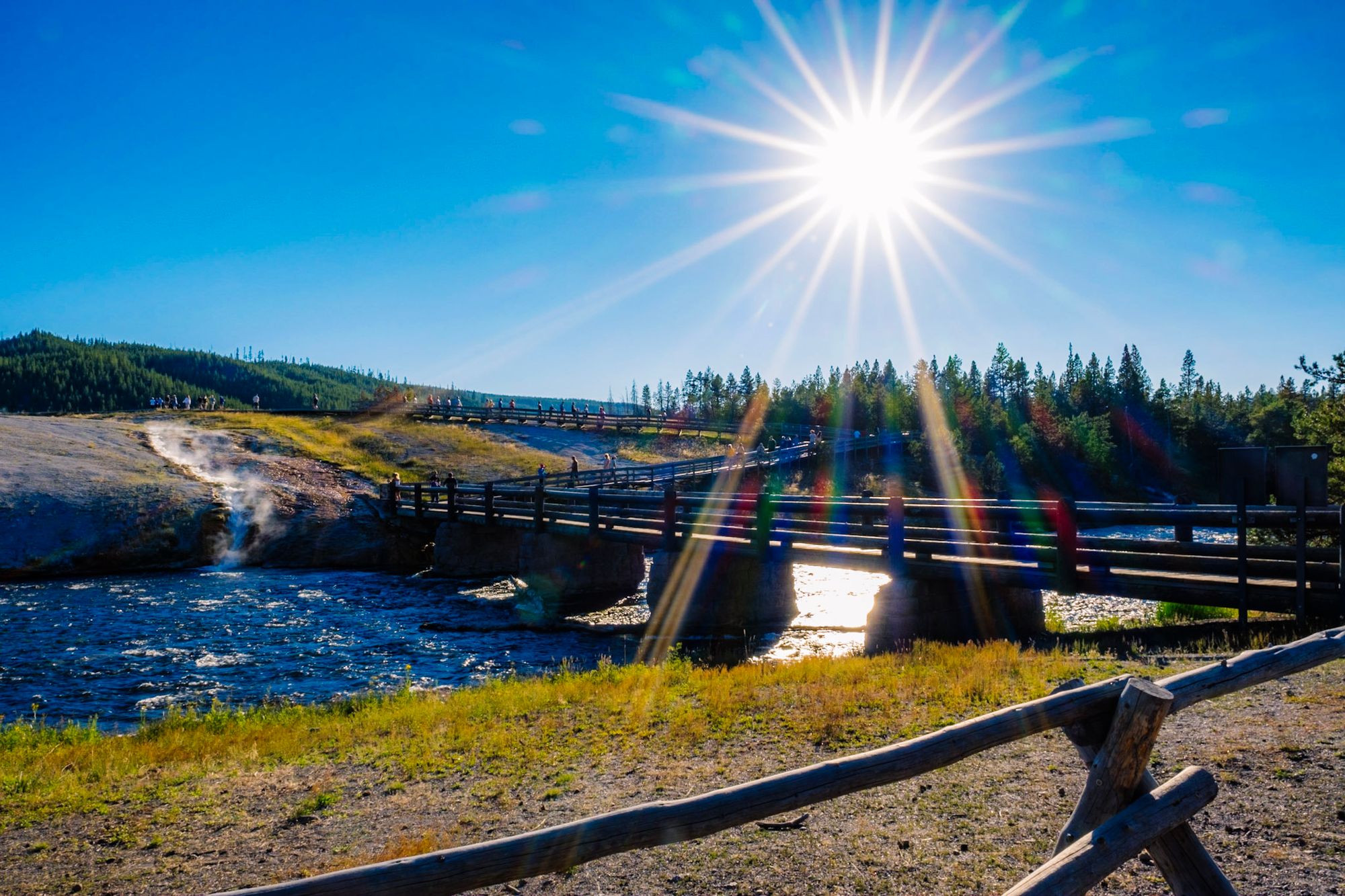
Then you pass by Excelsior Geyser Crater, a beautiful, clear, bright blue hot spring.
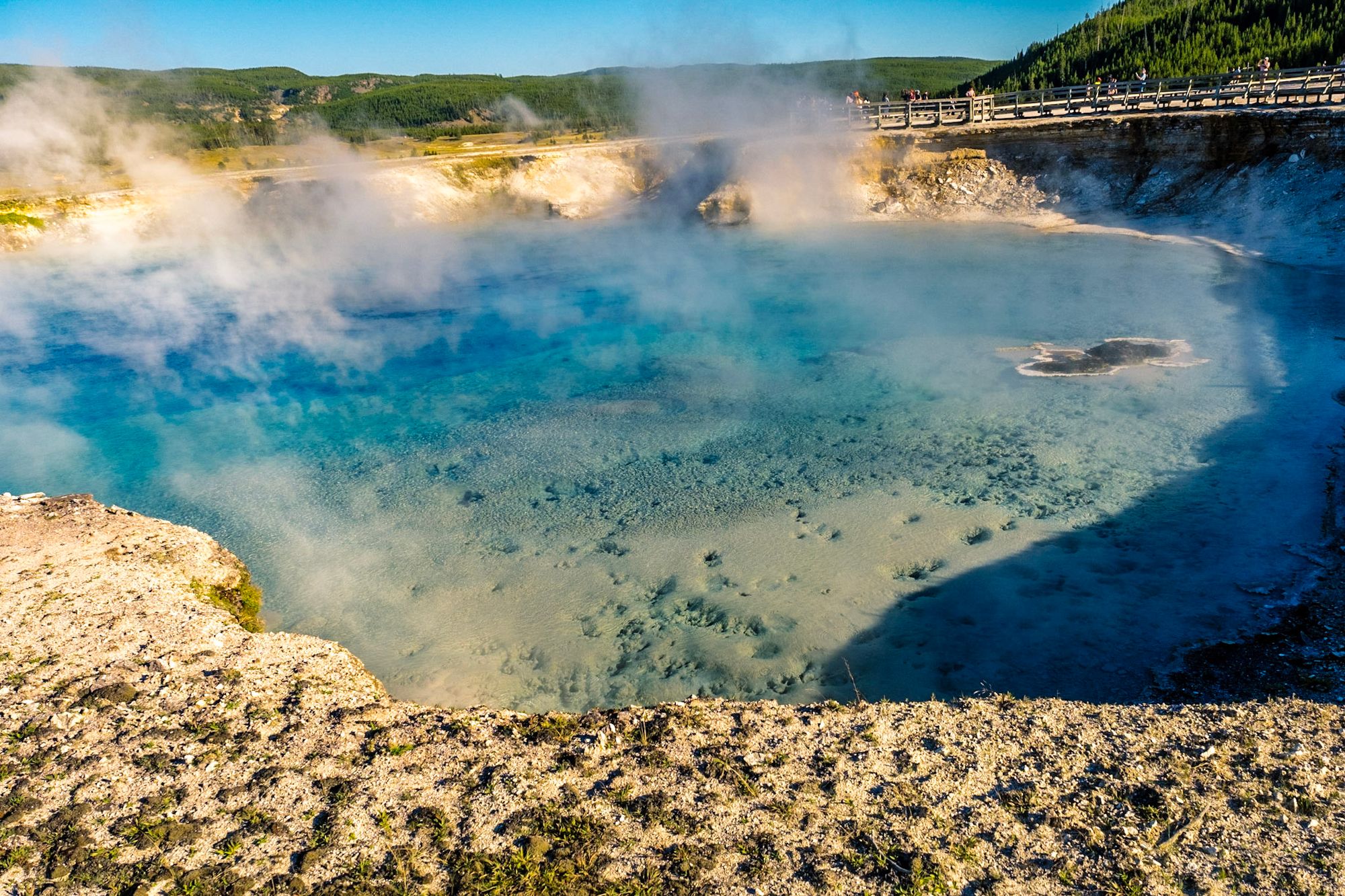
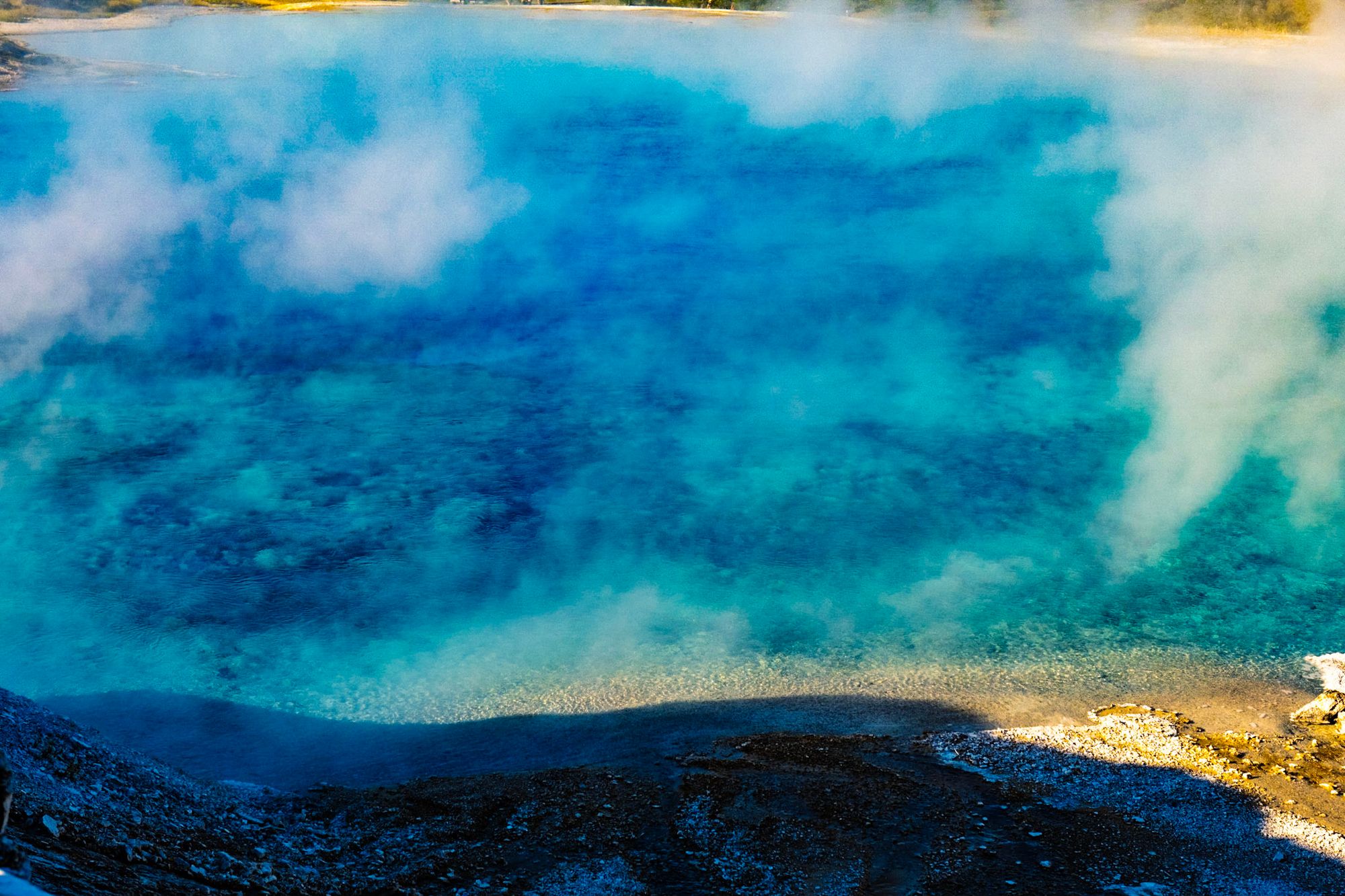
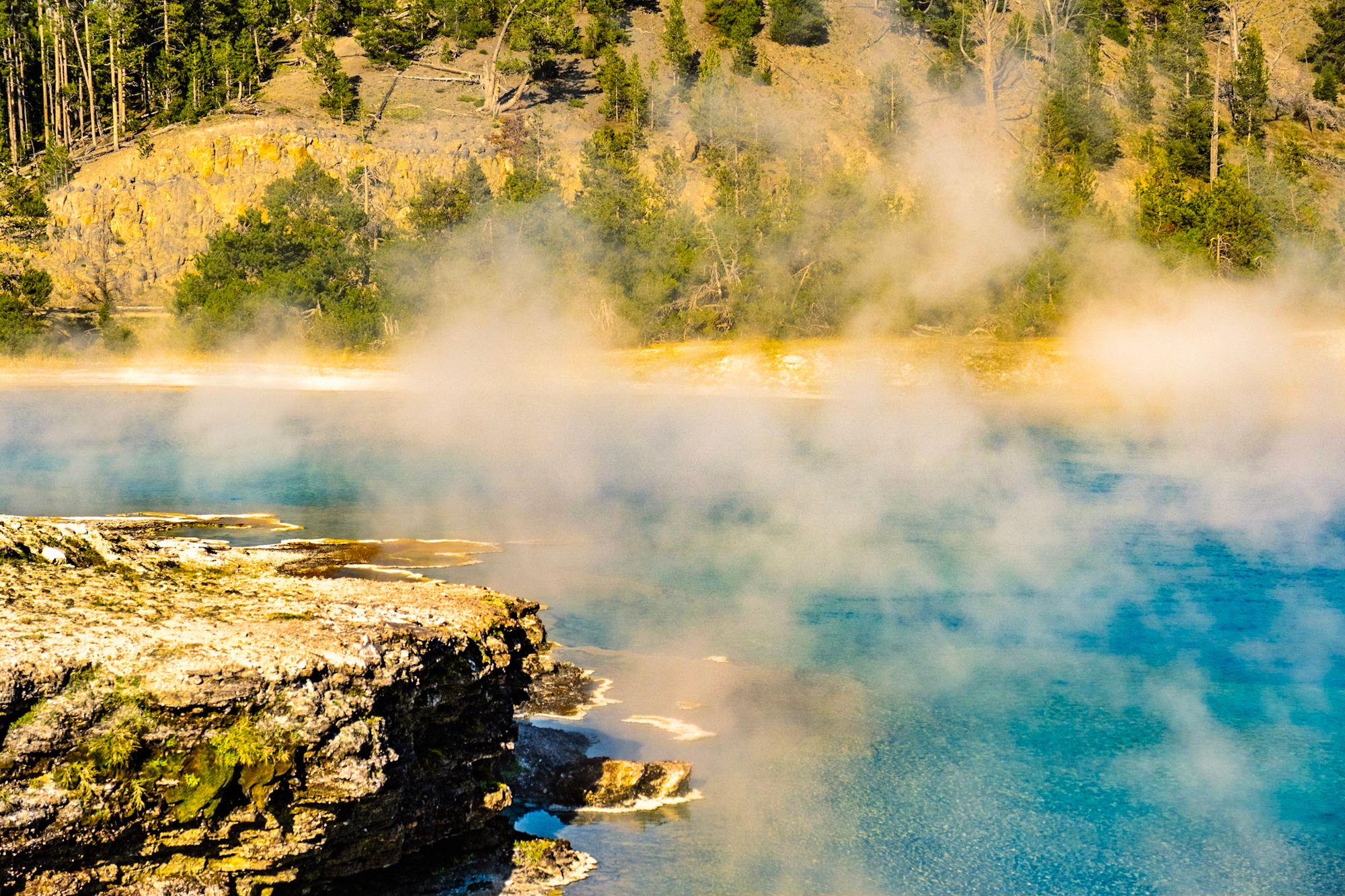
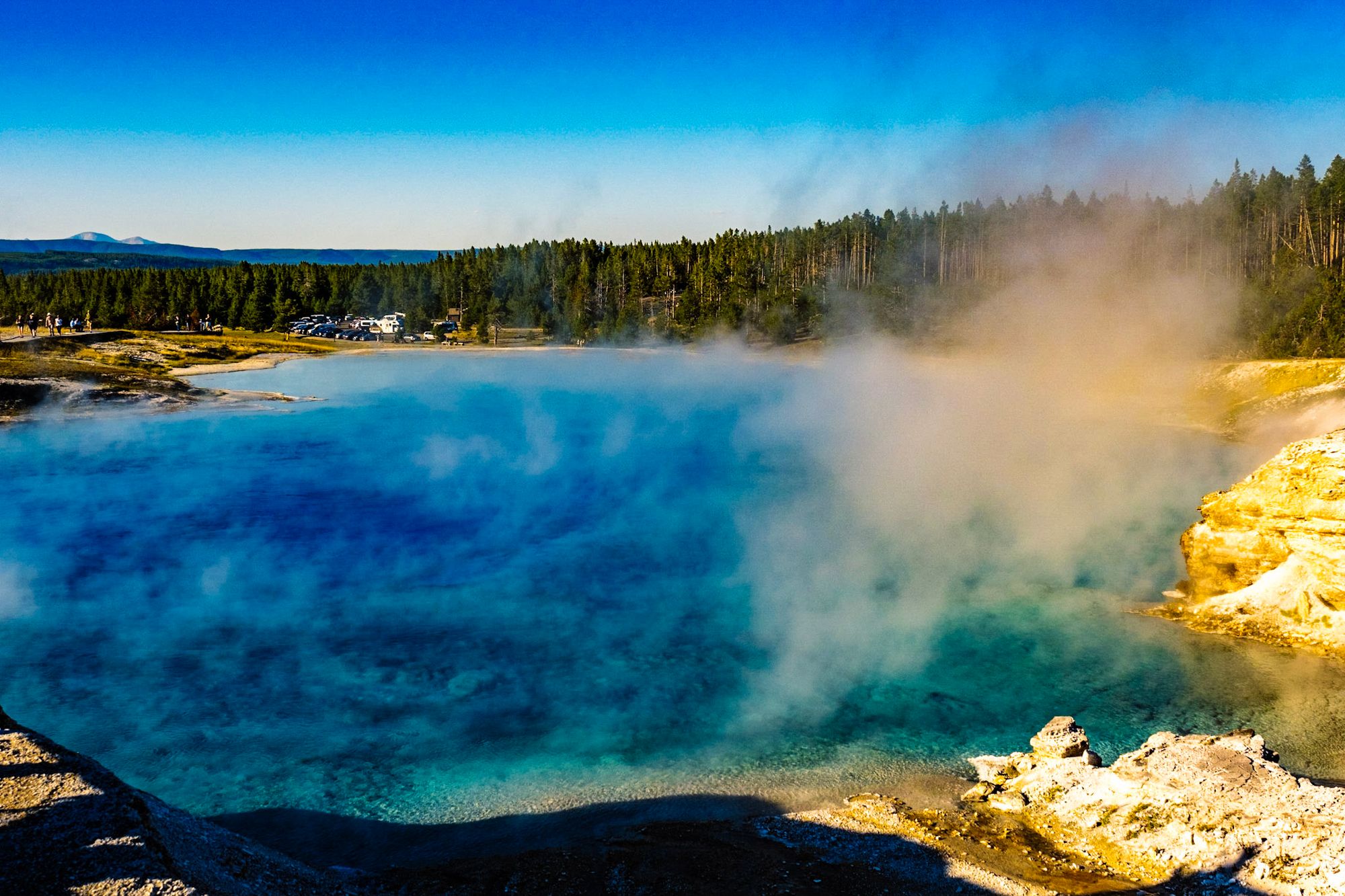
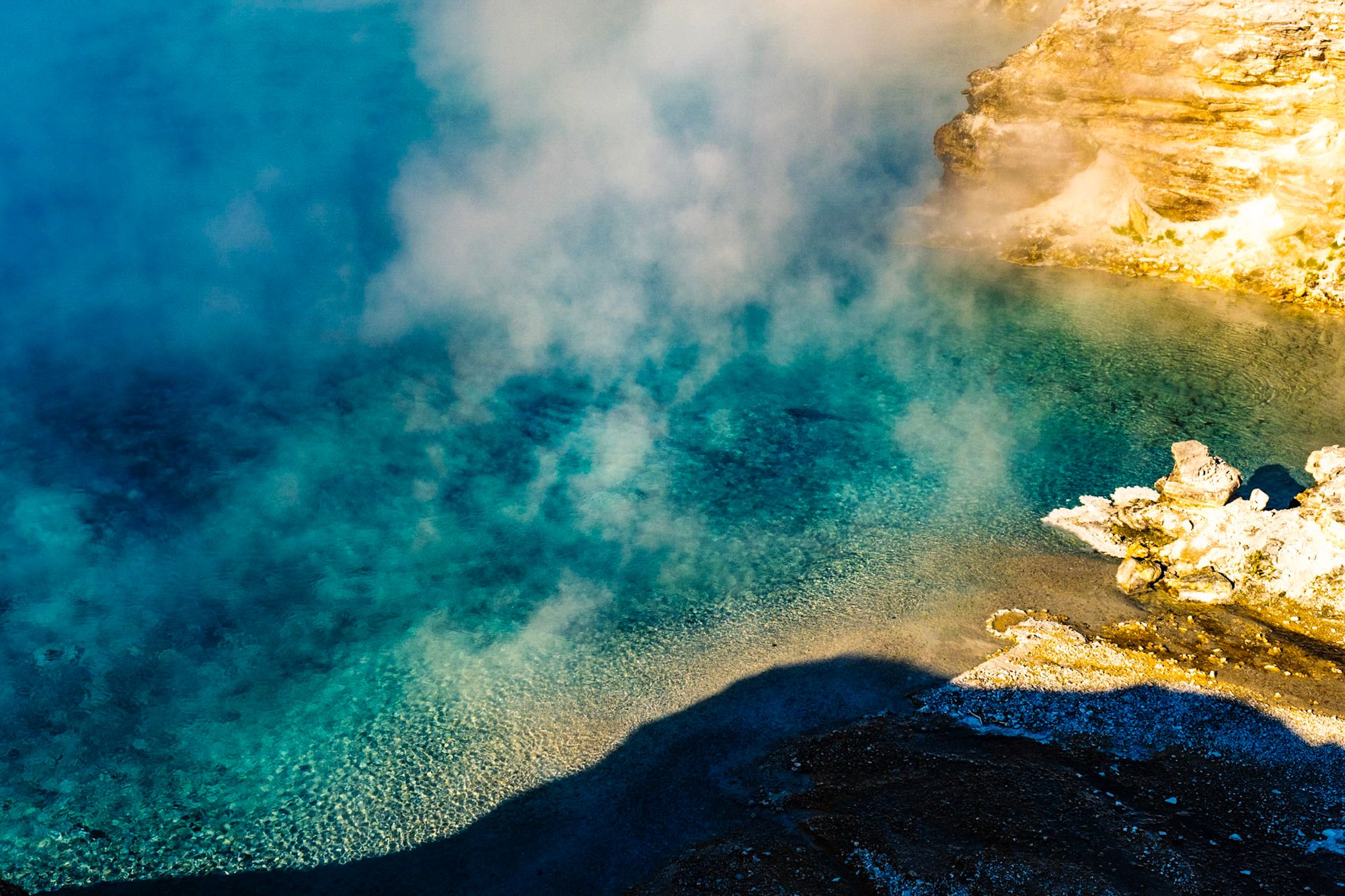
Excelsior Geyser Crater
Finally, we got to the rainbow Grand Prismatic Spring. The more iconic view is from above, but we were really hot and tired that day, and we didn't hike the overlook trail. Something to do the next time we visit. Even though the view from the main boardwalk (where you're basically level with the spring) isn't quite as good, it's still stunningly colorful. In pictures it looks fake and oversaturated – but it's pretty much like that in real life.
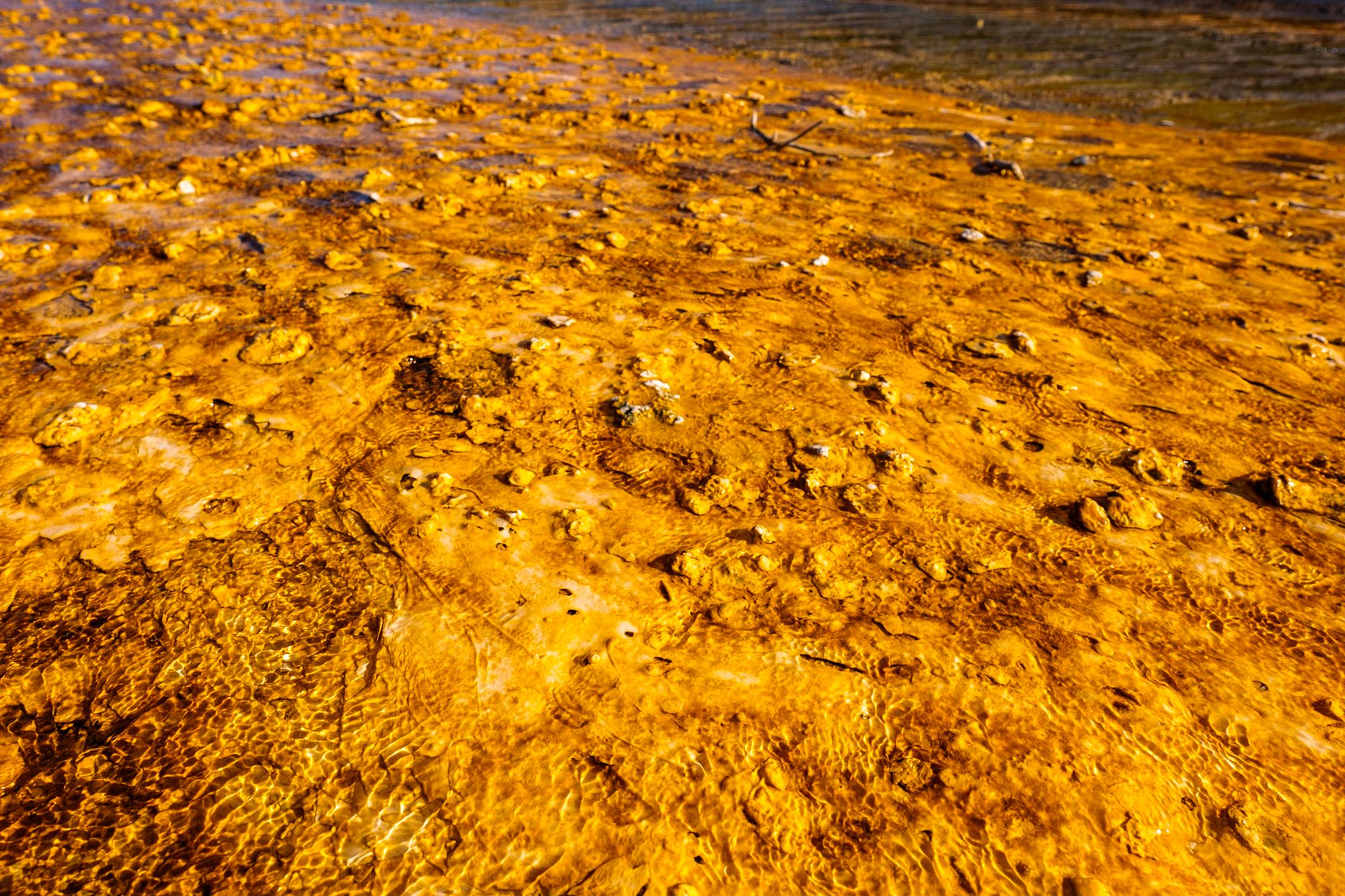
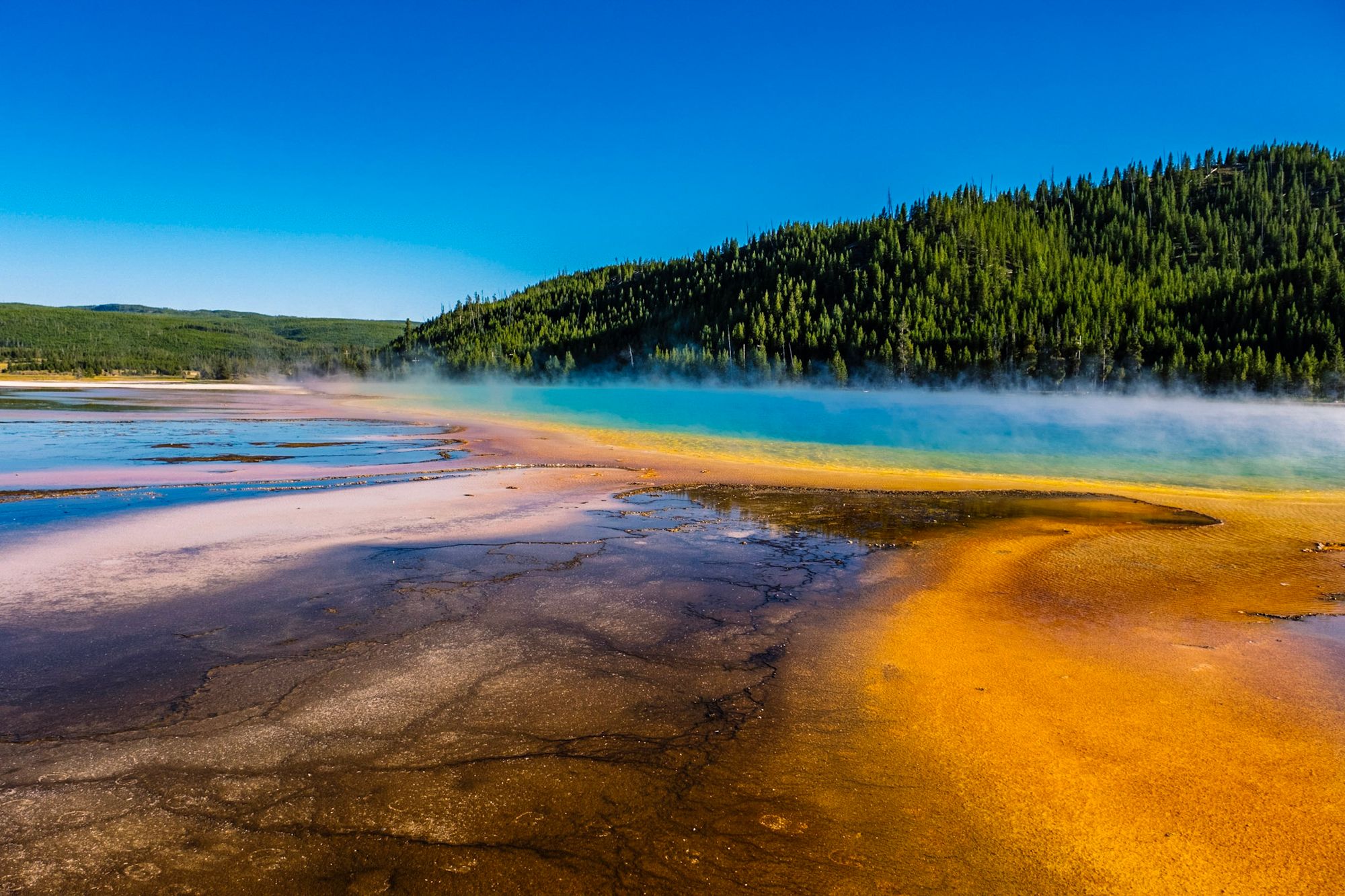
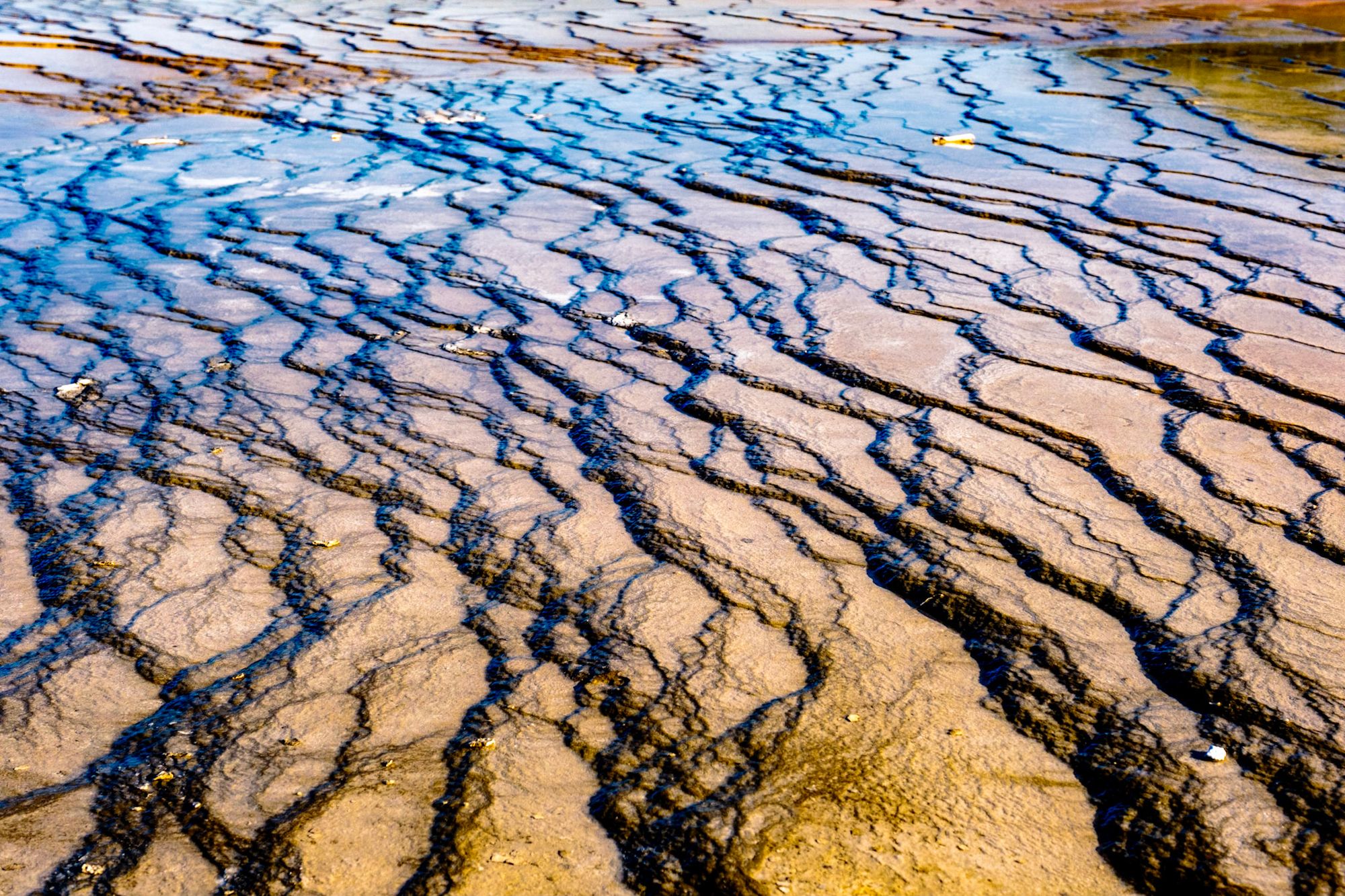
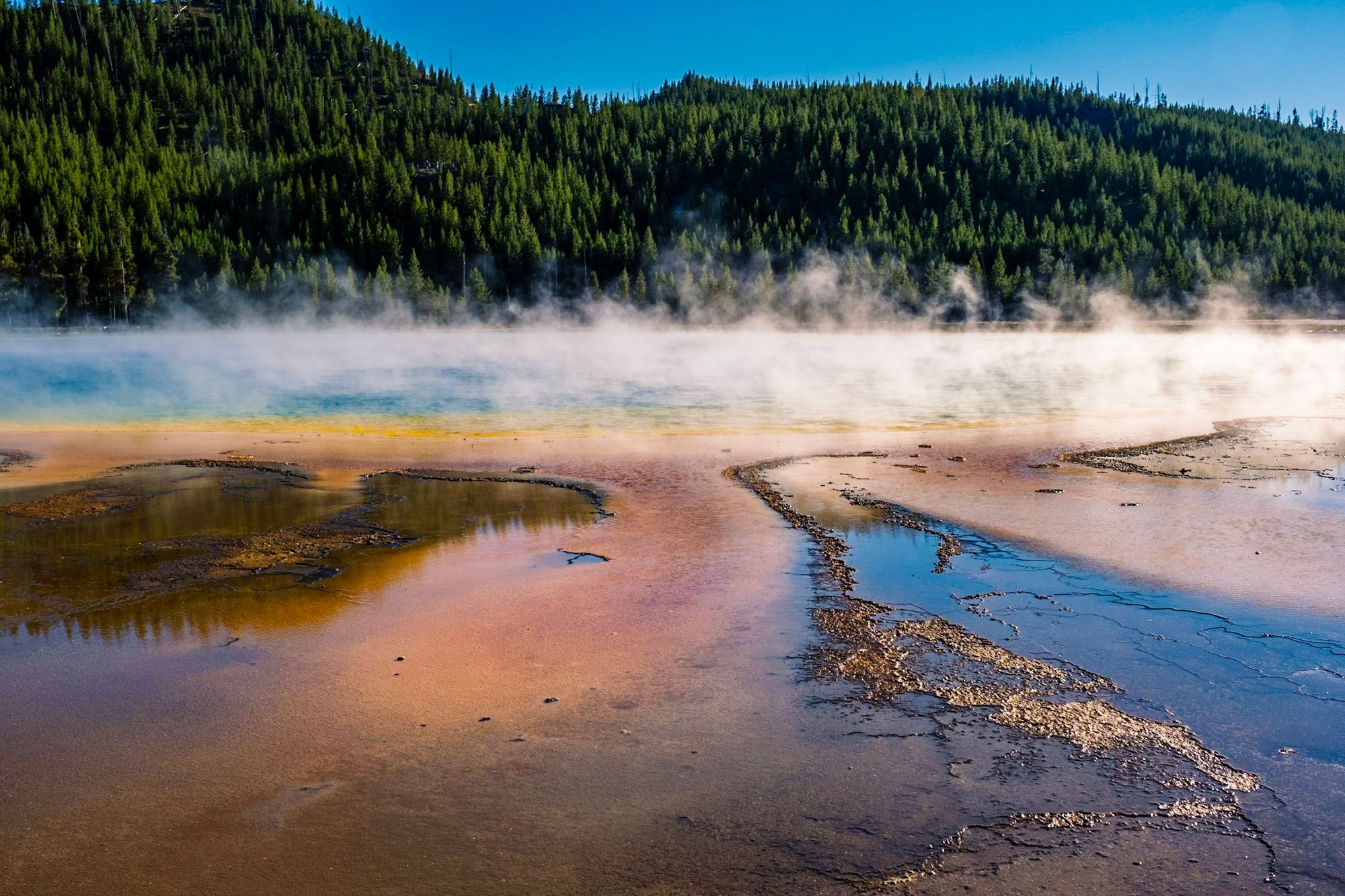
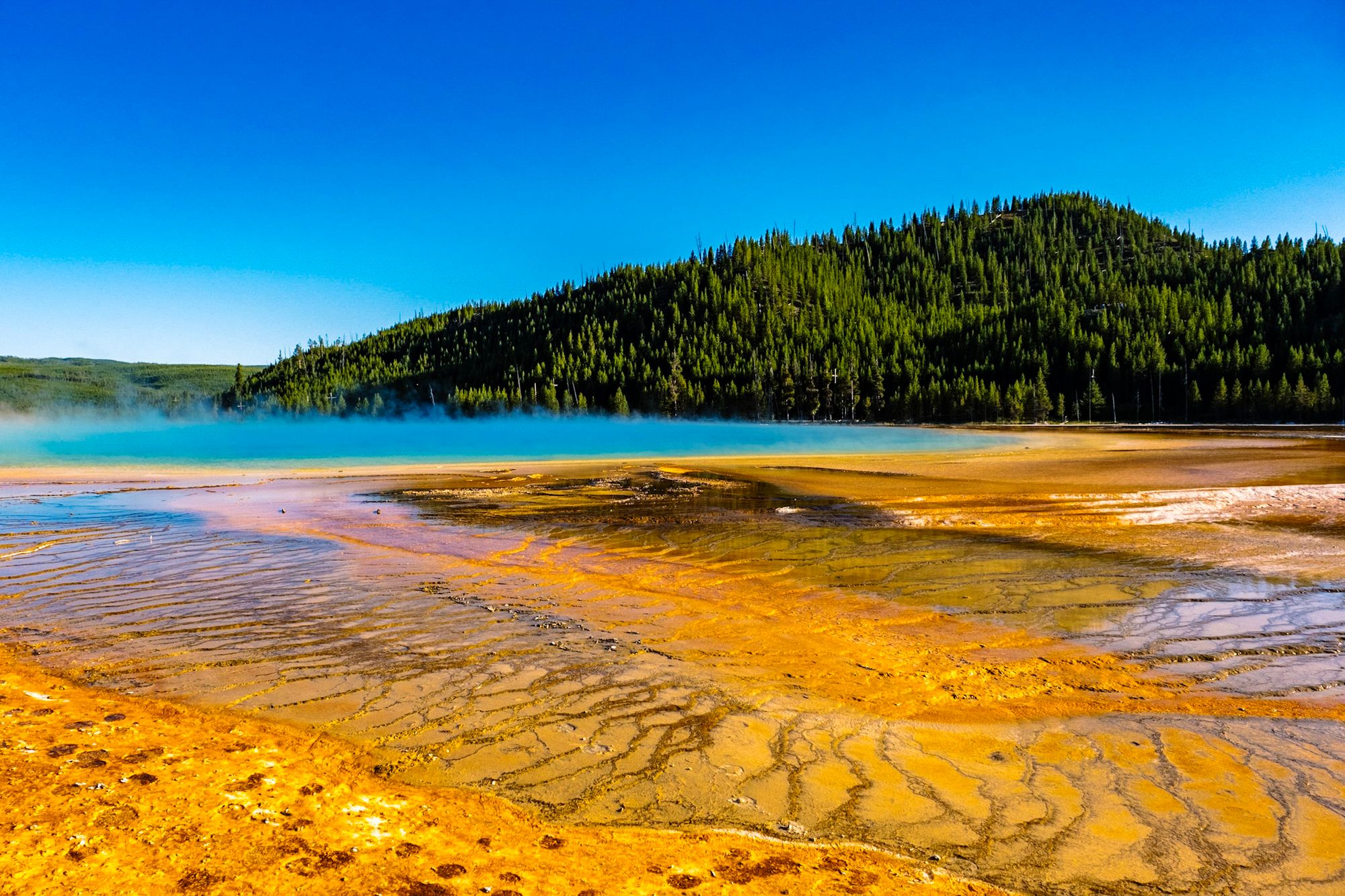
Grand Canyon of the Yellowstone
The Grand Canyon of the Yellowstone, toward the center of the park, is where Yellowstone got its name. Cutting through the dense pine forests is a massive canyon, carved by the Yellowstone River, with bright yellow rock walls. This is where the famous Lower Falls is, and it's a really beautiful place.
This is probably the second busiest area after Old Faithful / the geyser basins. We parked at the North Rim lot and hiked down to the Brink of the Lower Falls, which is a steep trail with lots of switchbacks that takes you to a platform right above the waterfall. The Lower Falls is over 300 feet tall and it's dizzying looking down. We had to fight the crowds, but this was one of my favorite views in the whole park.
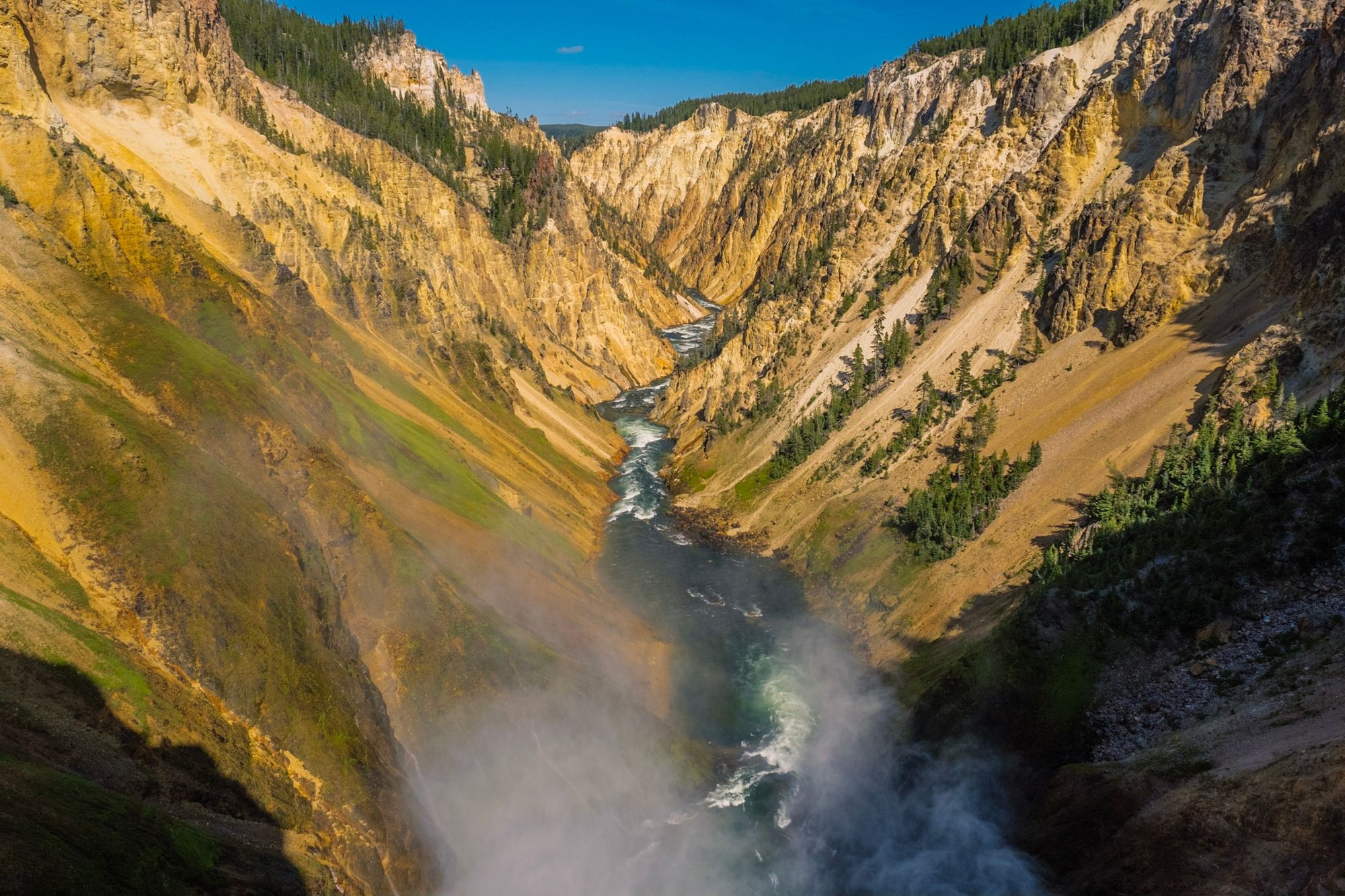
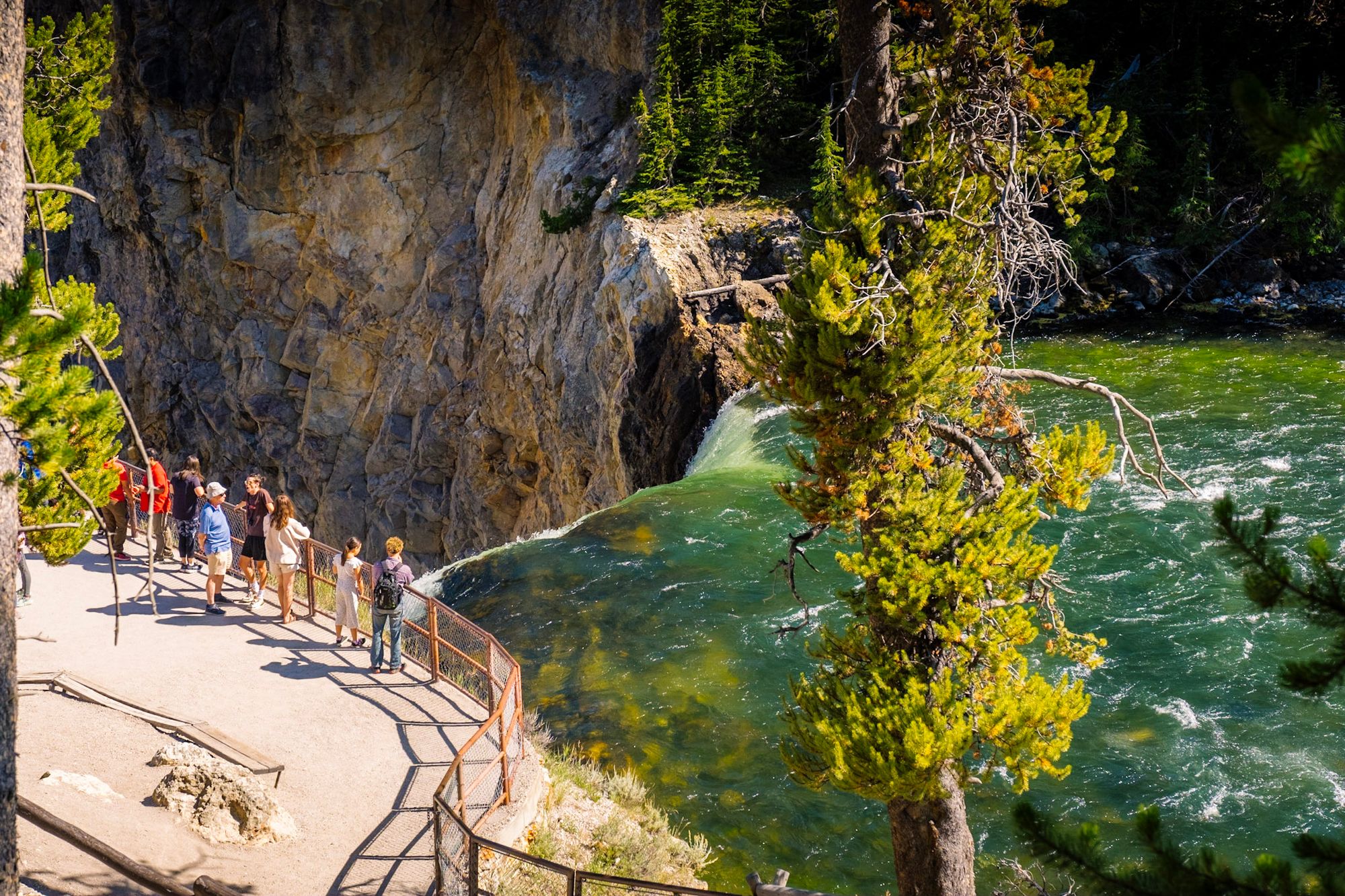
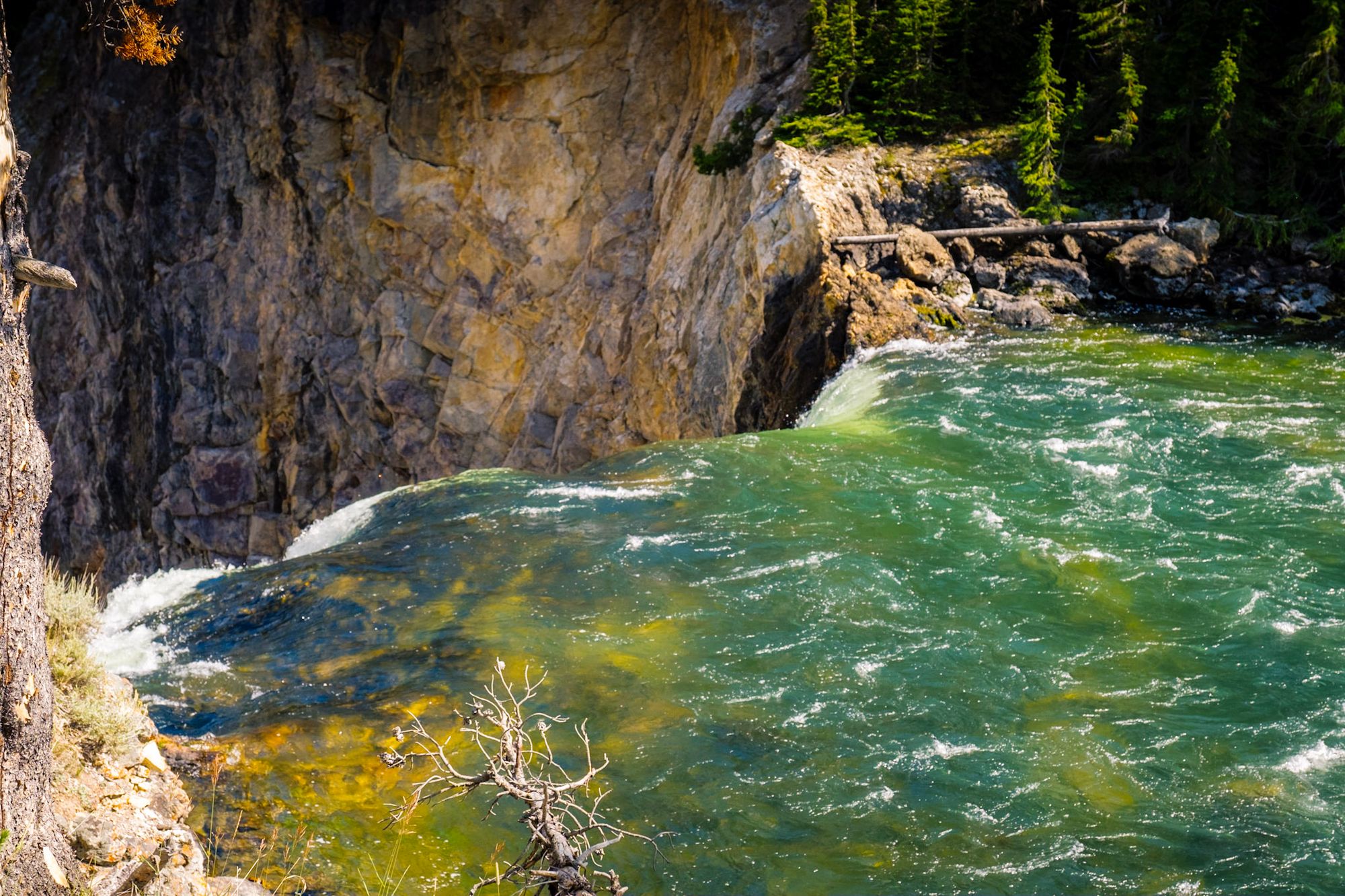
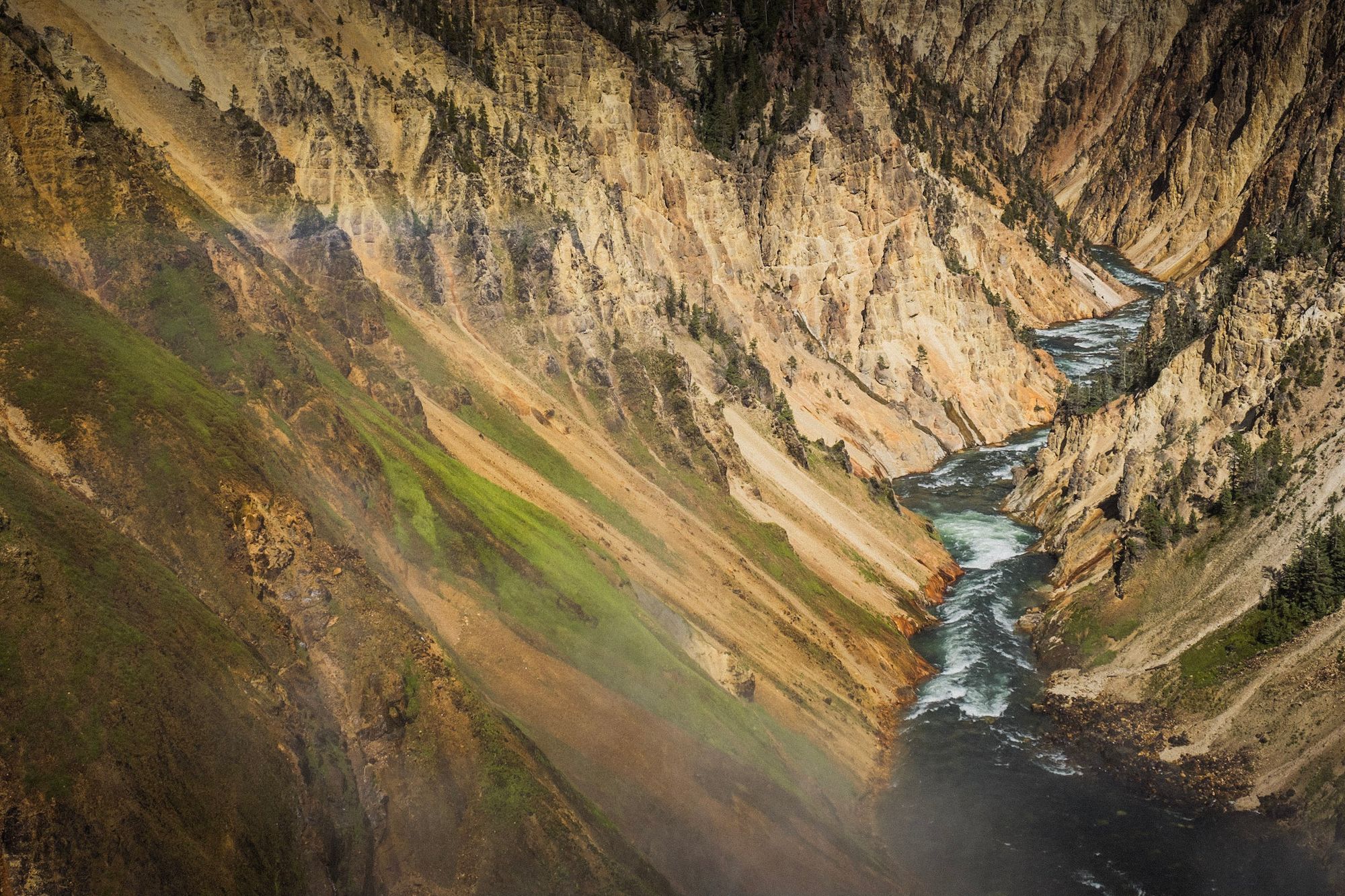
We also went to the Upper Falls just up the river, and to Artist Point, which is a famous view of Lower Falls from a distance.
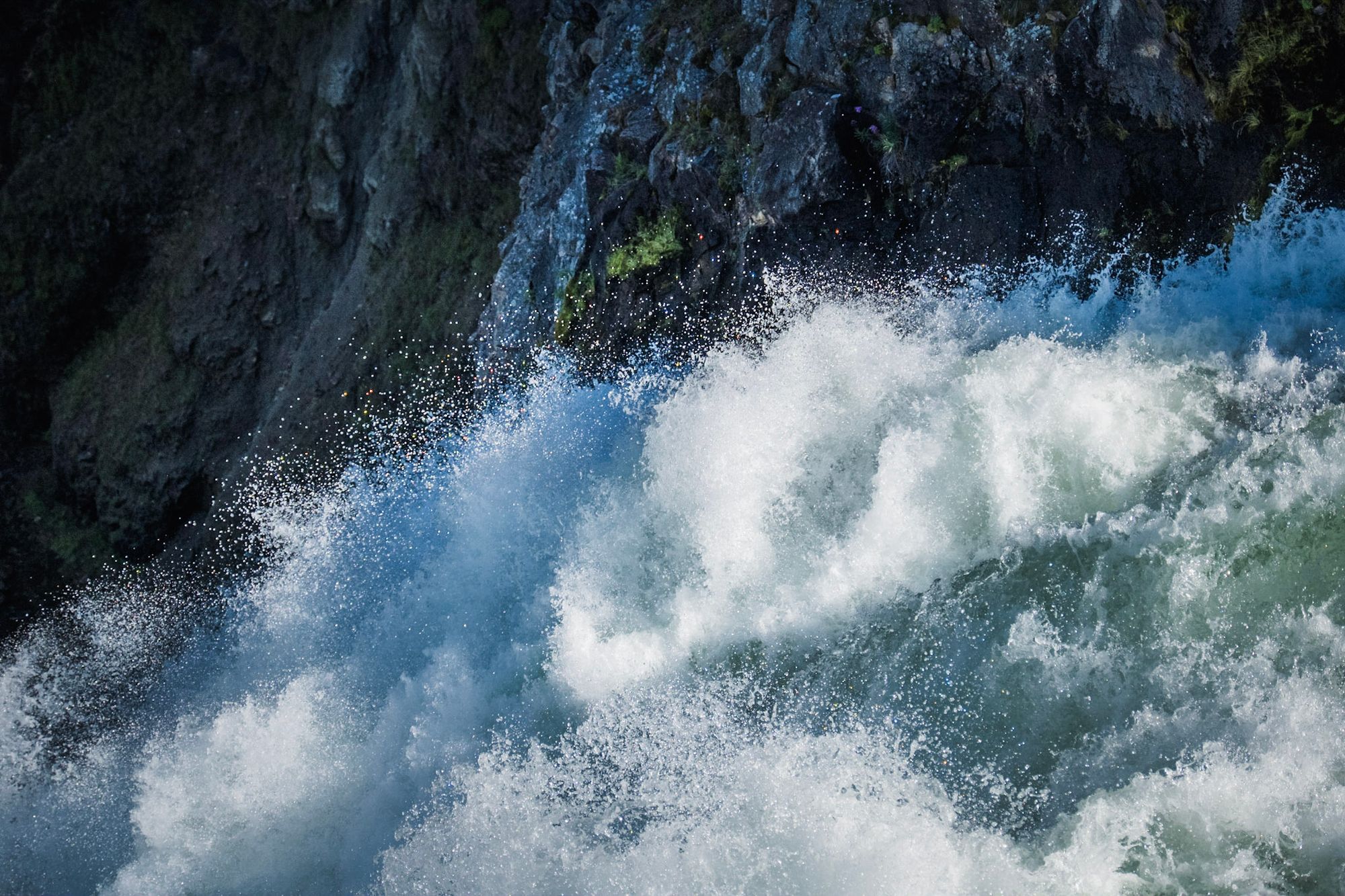
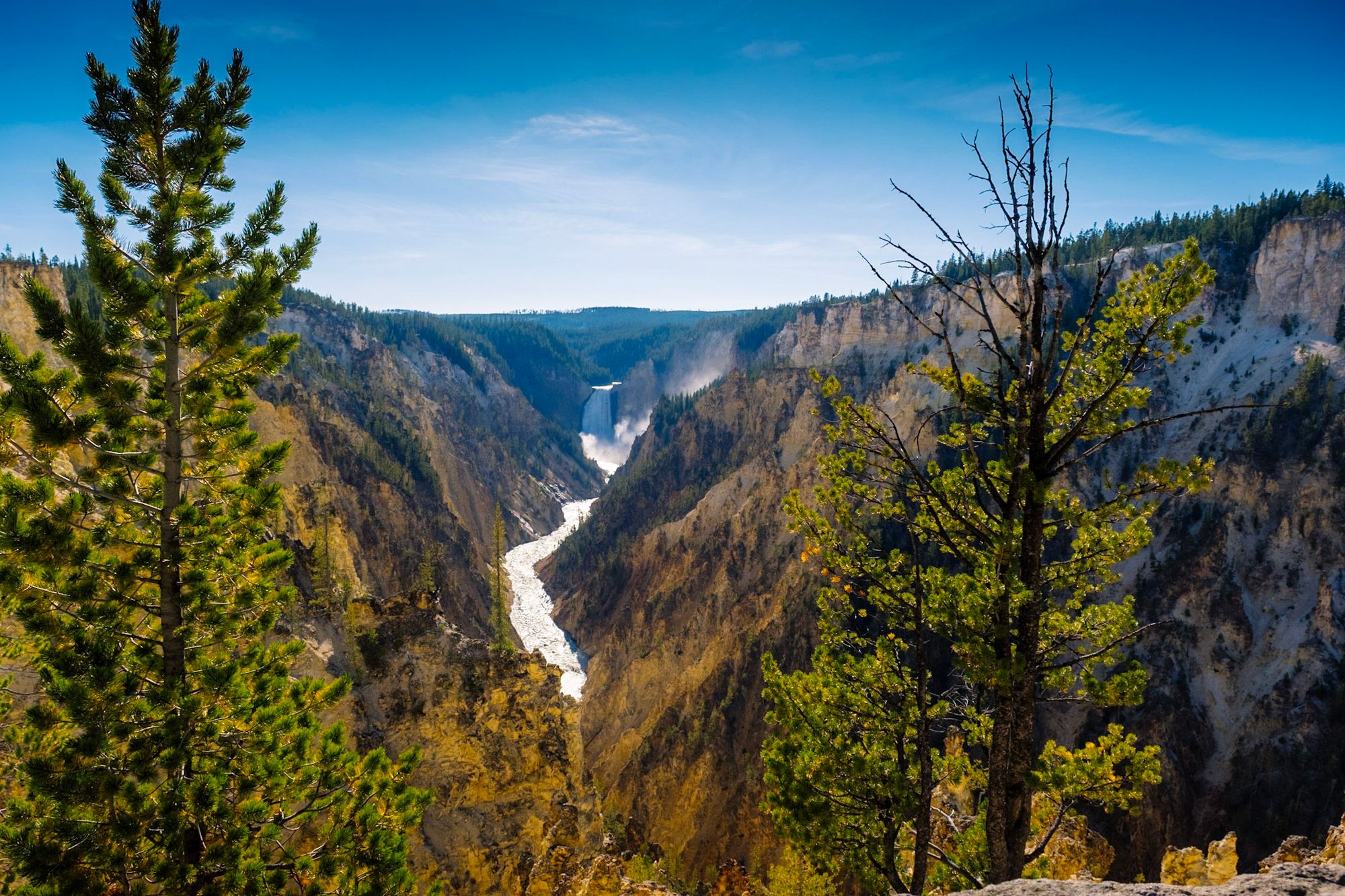
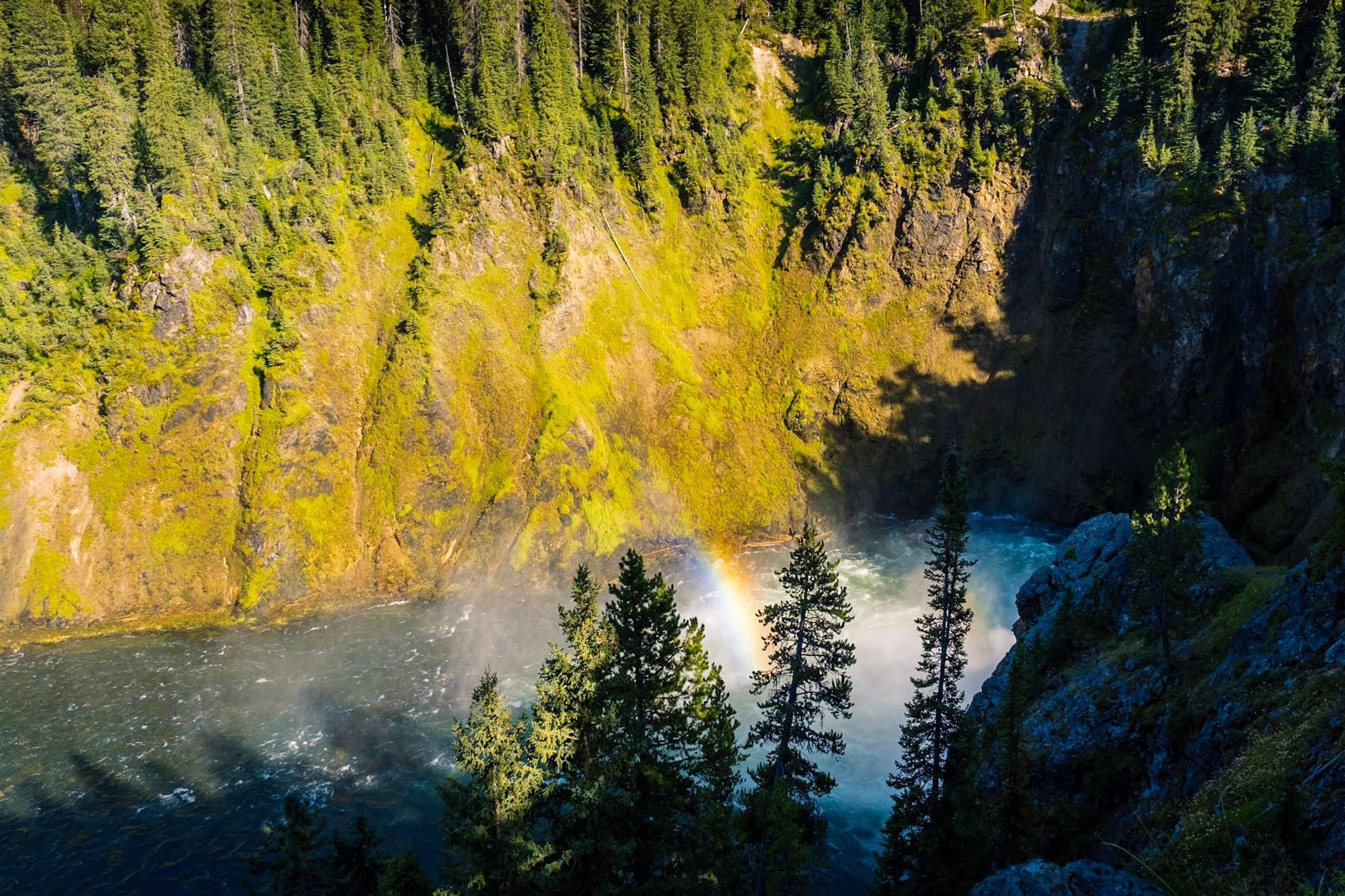

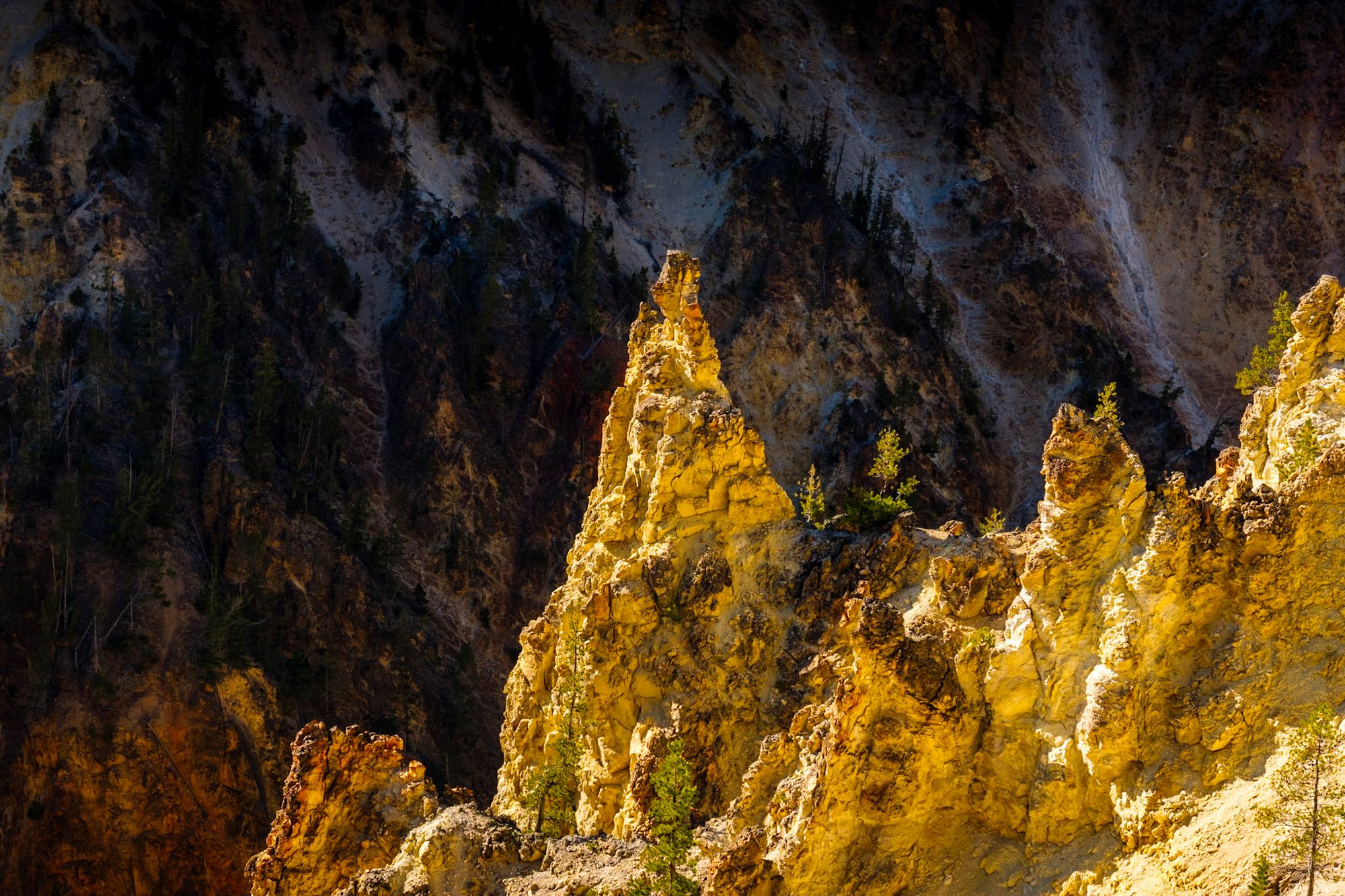
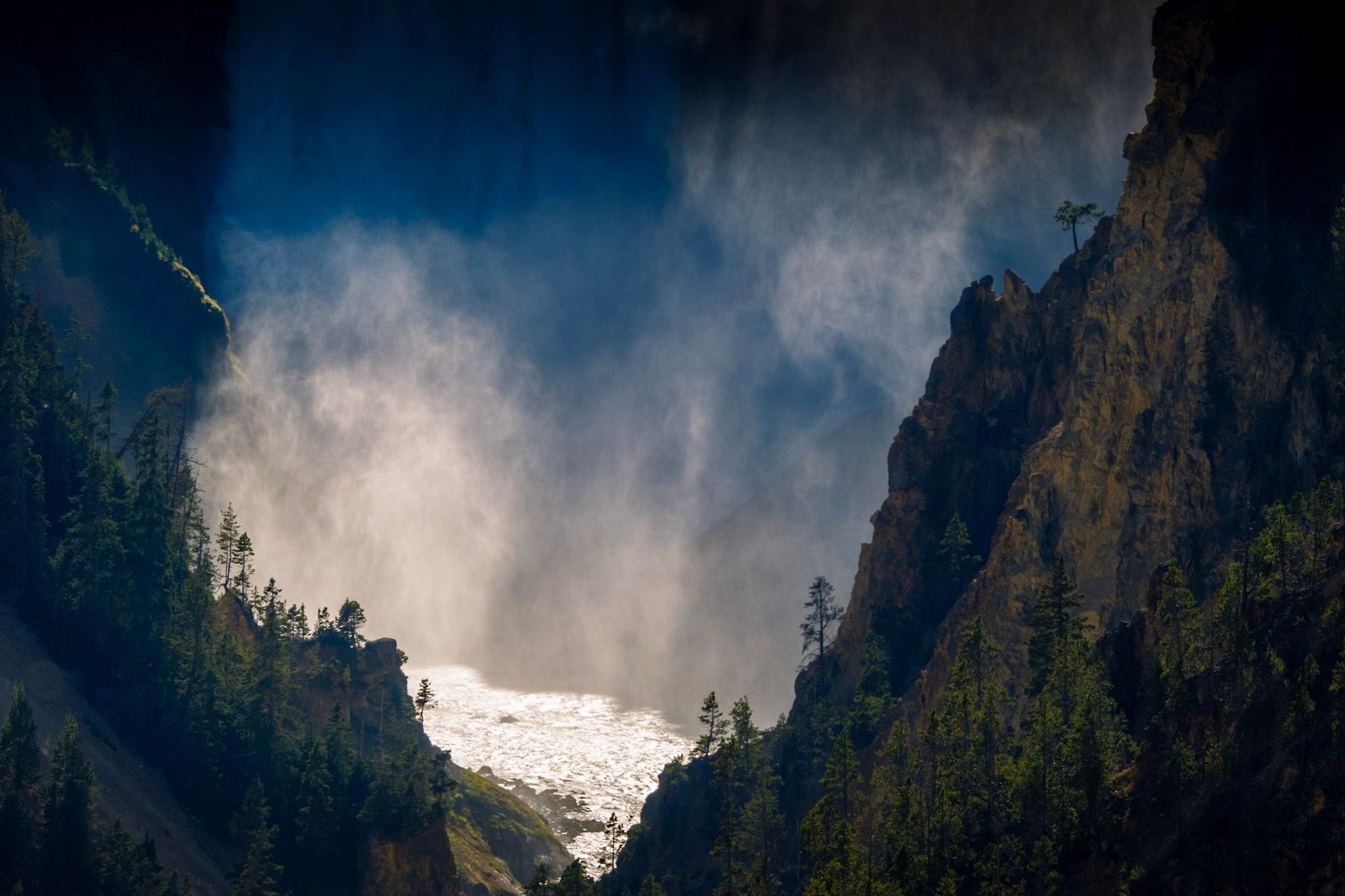
4 hours in traffic
Our biggest traffic encounter in Yellowstone was after a long afternoon exploring this side of the park. We were on our way out of the park at about 6 or 7 pm, driving along Yellowstone Lake, when suddenly traffic halted. We waited at a complete stop for at least an hour, figuring there must have been a bad accident ahead. We didn't turn around to go another way because the only other viable option would have taken us at least an hour longer than the way we were already going... so we just sat hoping it would clear up soon.
Finally, our lane started moving! But then just up the road, we stopped again and stayed put for another hour or two. Multiple people started getting out of their cars and walking up ahead to see what was happening. A couple ambulances went by, and someone said they saw a guy lying on the ground. Then two kids walking by told us it was construction. We didn't believe them, but turns out, it was mostly construction's fault. We think a worker must have collapsed on the job or something, hence the ambulances and the reason we didn't move for a long time – but it was also just a lot of construction blocking the road at a busy 3-way intersection. We didn't get home til after 11pm, and were starving (and Hollie was pretty mad at us lol).
Now we know to plan for things like that in Yellowstone, especially since it takes so long to get everywhere already, and there aren't many different routes you can take. Since then, we also make sure to always keep snacks in the truck. :)
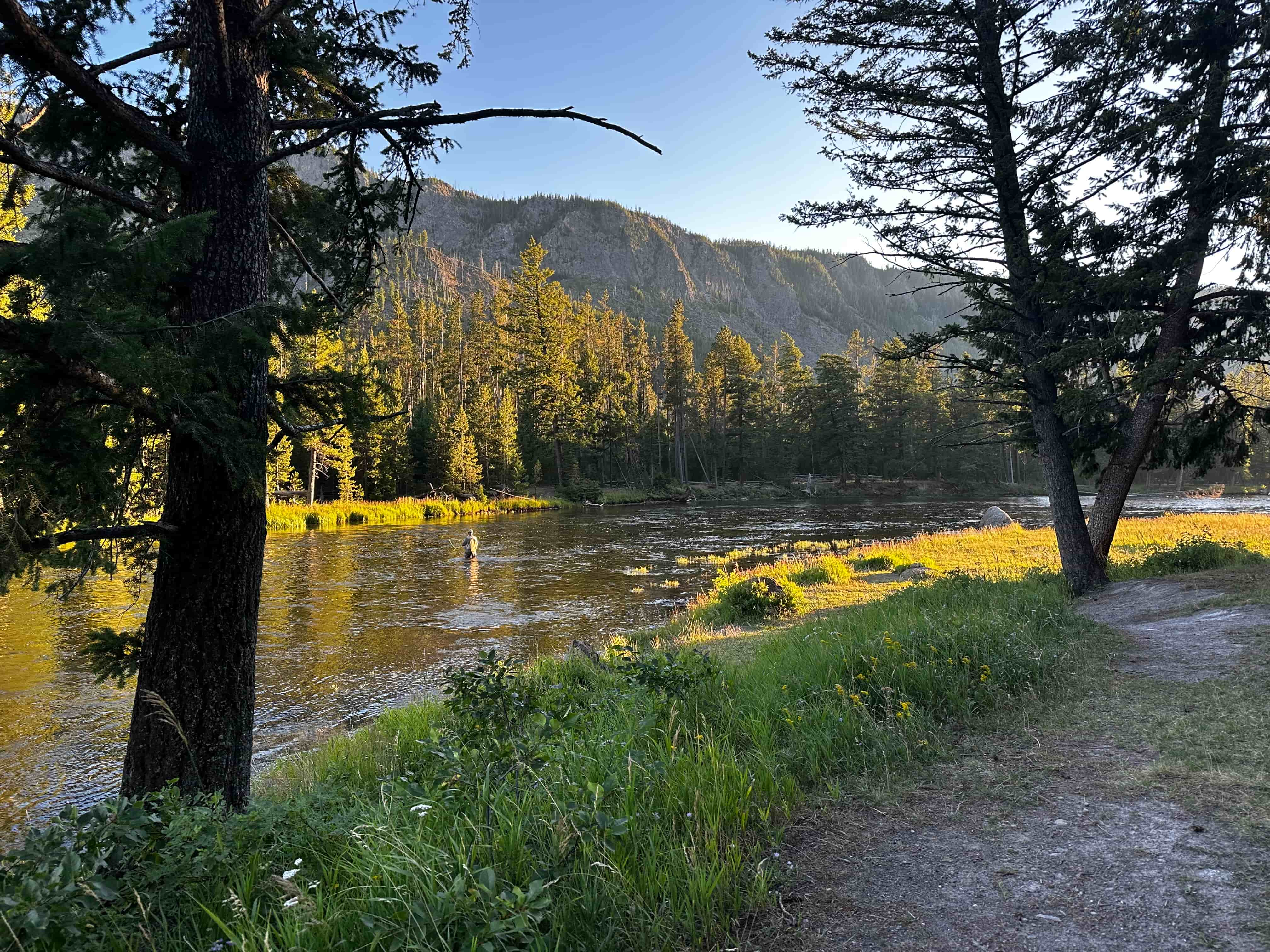
North Yellowstone
Camping
Mid-week, we moved to the northeastern side of the park near the Lamar Valley, which is the best area to see wildlife. There's not nearly as much infrastructure or as many camping options on this side of the park. I scoped out a couple first-come, first-serve campgrounds online near Cooke City and hoped we would get a spot.
We didn't have anything to worry about; it was pretty dead on that side of the park. Traffic sometimes got held up in the Lamar Valley due to bison jams and wildlife encounters, but otherwise, it was very quiet compared to West Yellowstone.
We got to the first campground option and started talking to a couple who were filling their water containers. They told us they were camping just up the road at a different National Forest campground – and it had electric hookups! It was the same price, so we followed them there.

(Side note – they also told us a story about a girl who was tent camping at the first campground a few years back in the spring. A grizzly bear who had just woken up from hibernation ate her from her tent. It's hard to imagine something scarier).
So we got to camp at Fox Creek Campground in Shoshone National Forest, 10 minutes down the road from Cooke City and the northeast park entrance, and right at the beginning of the scenic Beartooth Highway. Our site was awesome, like all the national forest campsites we've been to so far, and having not having to worry about our batteries was a nice bonus.
The downside was that we had absolutely no cell signal at the campground, but the location was great, and it was close to the weekend anyway. We worked where / when we could – using the town visitor center's public Wi-Fi, or a random spot inside the park that had good signal and a nice view of the river.
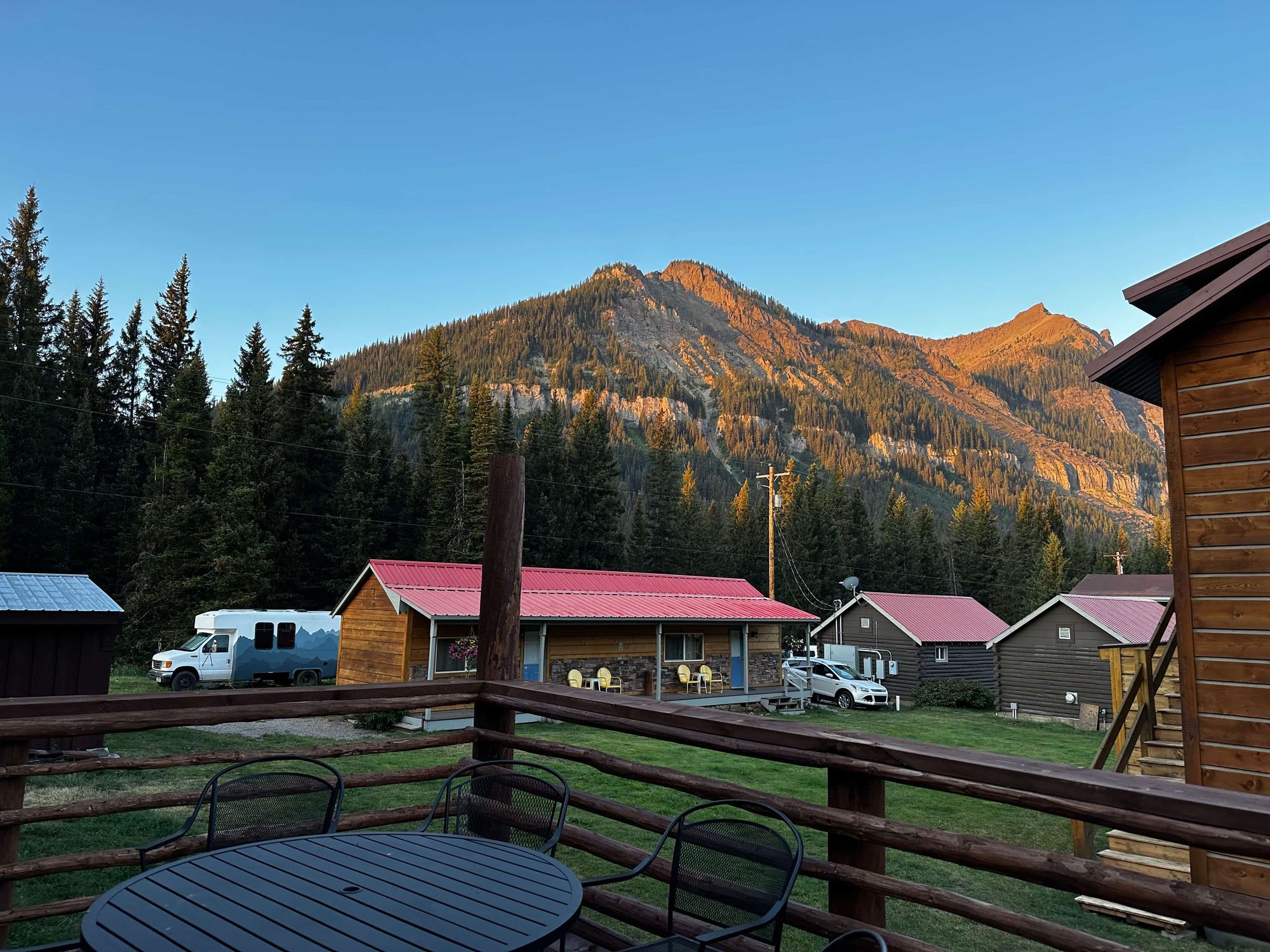
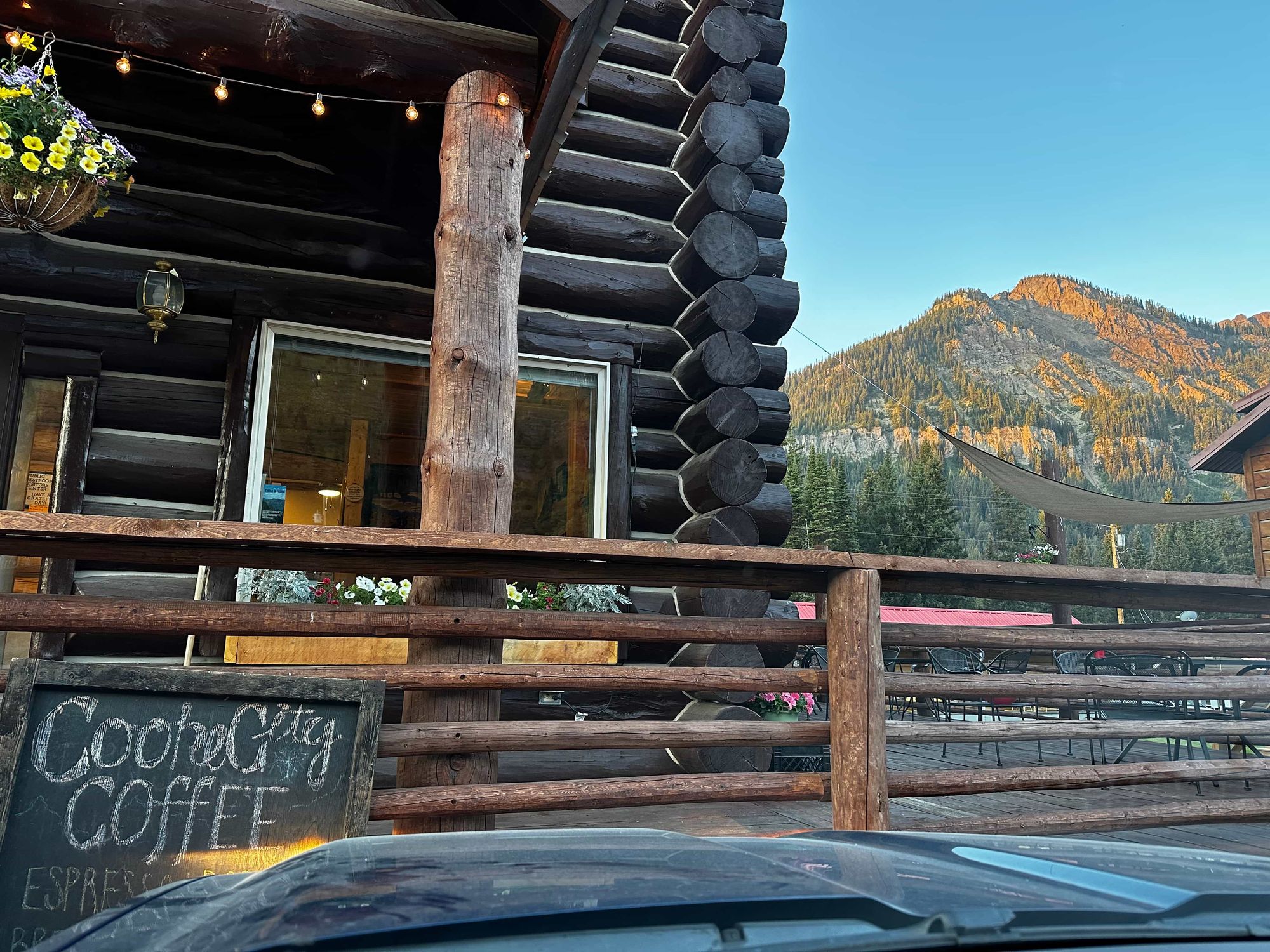
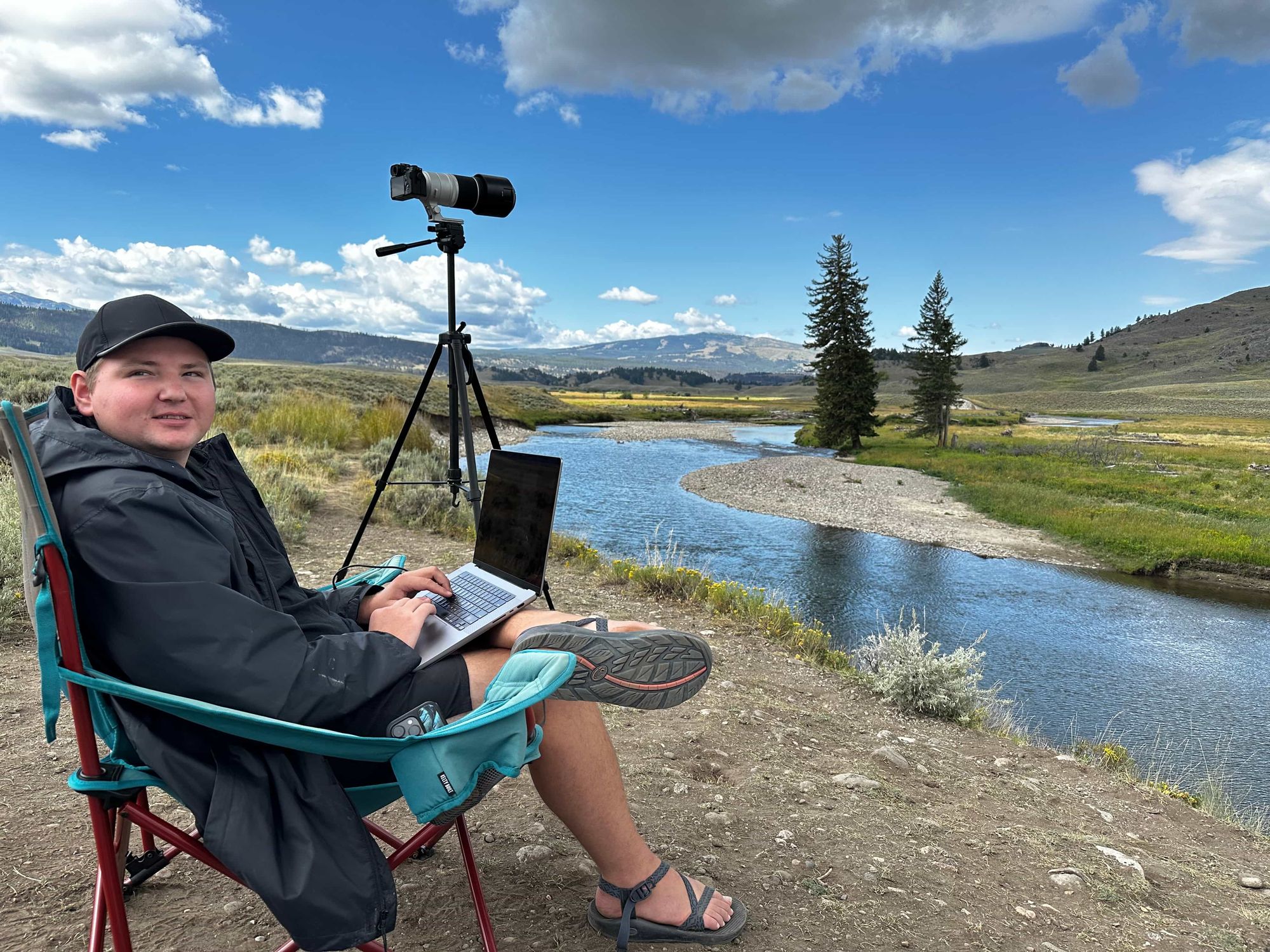
Views in Cooke City, and working at a random spot inside the park that had good cell signal – one of the most scenic places we've worked!
Lamar Valley
The Lamar Valley is where Yellowstone feels like a safari. It's wide open and beautiful, with the surrounding hills and the Lamar River running through it. All the wildlife enthusiasts are out at the crack of dawn with their scopes and telephoto lenses, trying to get a glimpse of wolves or grizzly bears. (They don't care at all about bison. Bison are for beginners).
Joey still had the telephoto lens he rented, so we went out early in the morning and in the evening most days, the best times to see wildlife. Wolf-watching vans and wildlife tours would also come through every day, stopping at the overlooks. Bison herds would get close to the road (and often cross the road) which we had fun watching – but bears and wolves usually stay far away, on the edge of the trees. Even when we looked in people's scopes at a bear they found, it would be a tiny speck in the distance. And sadly, we didn't see wolves – but I want to go back and try harder to see some next time.
One day, there was a bison carcass out on the meadow that everyone was keeping an eye on to see what would come eat it. We only saw birds, but someone said they saw a grizzly earlier in the morning on top of it.
We also saw red foxes, which were super cute – on our way out of Yellowstone the last day, a group of them held up traffic for a long time by running along and crossing the road, playing with each other.
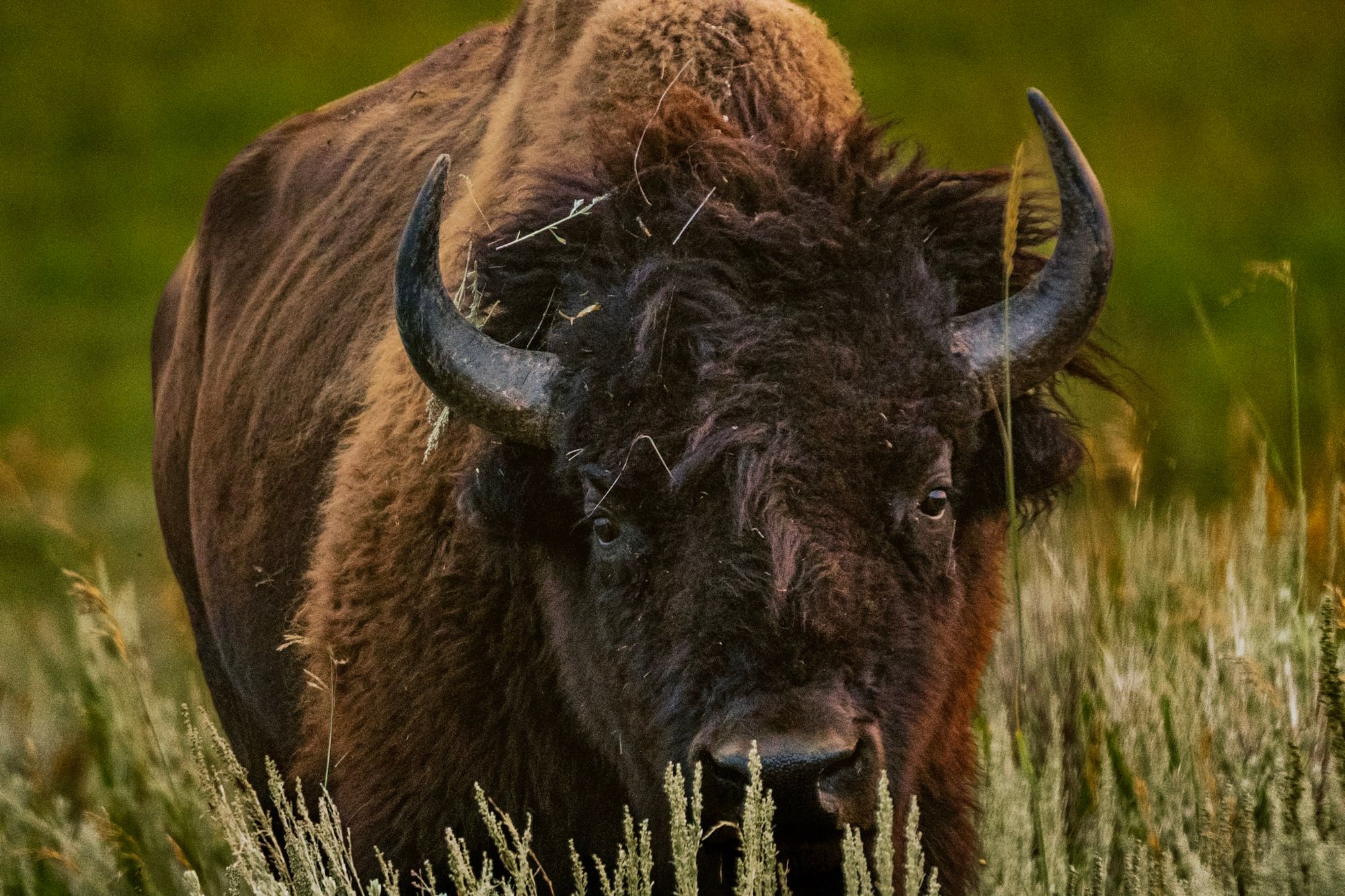
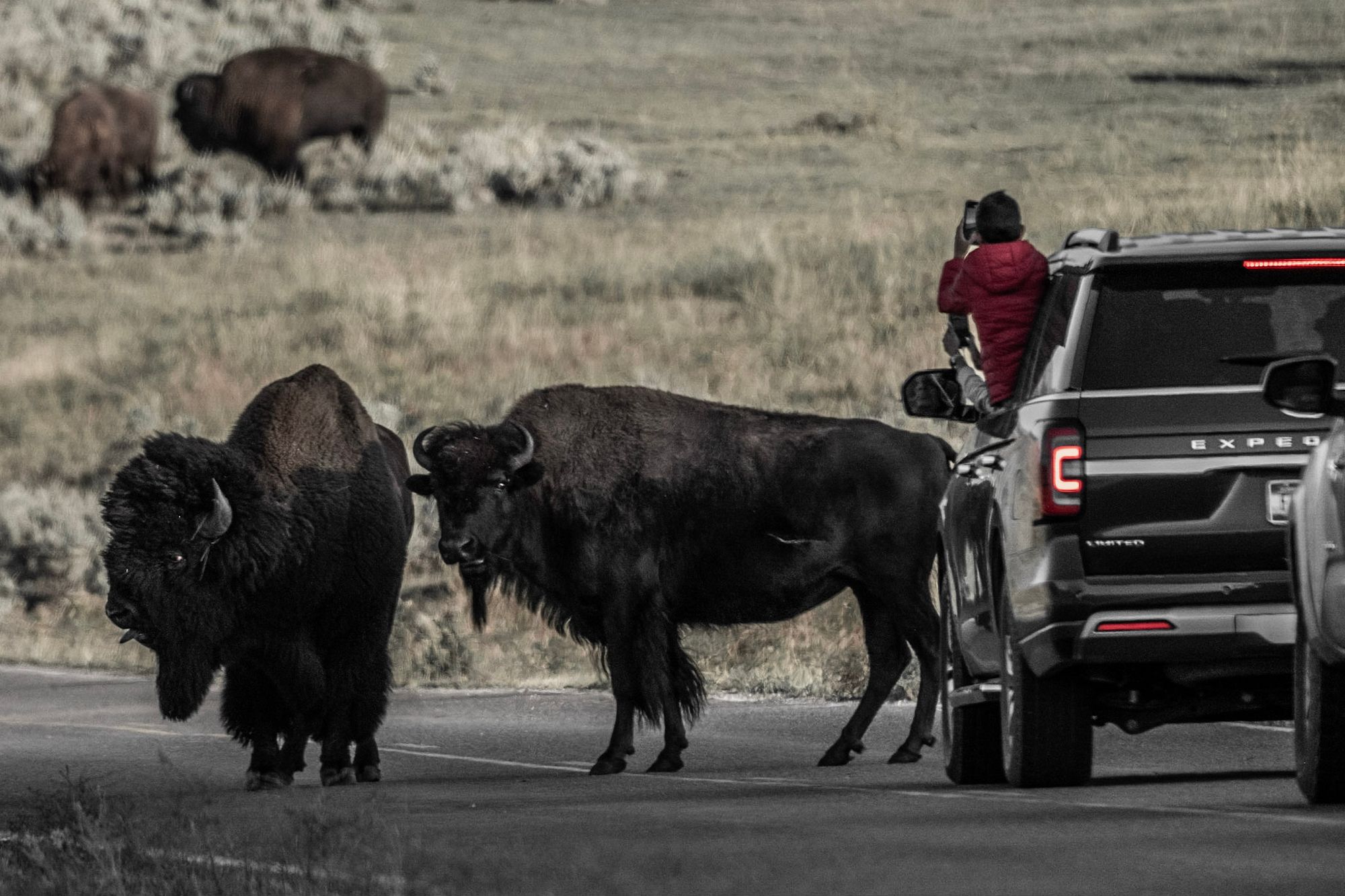
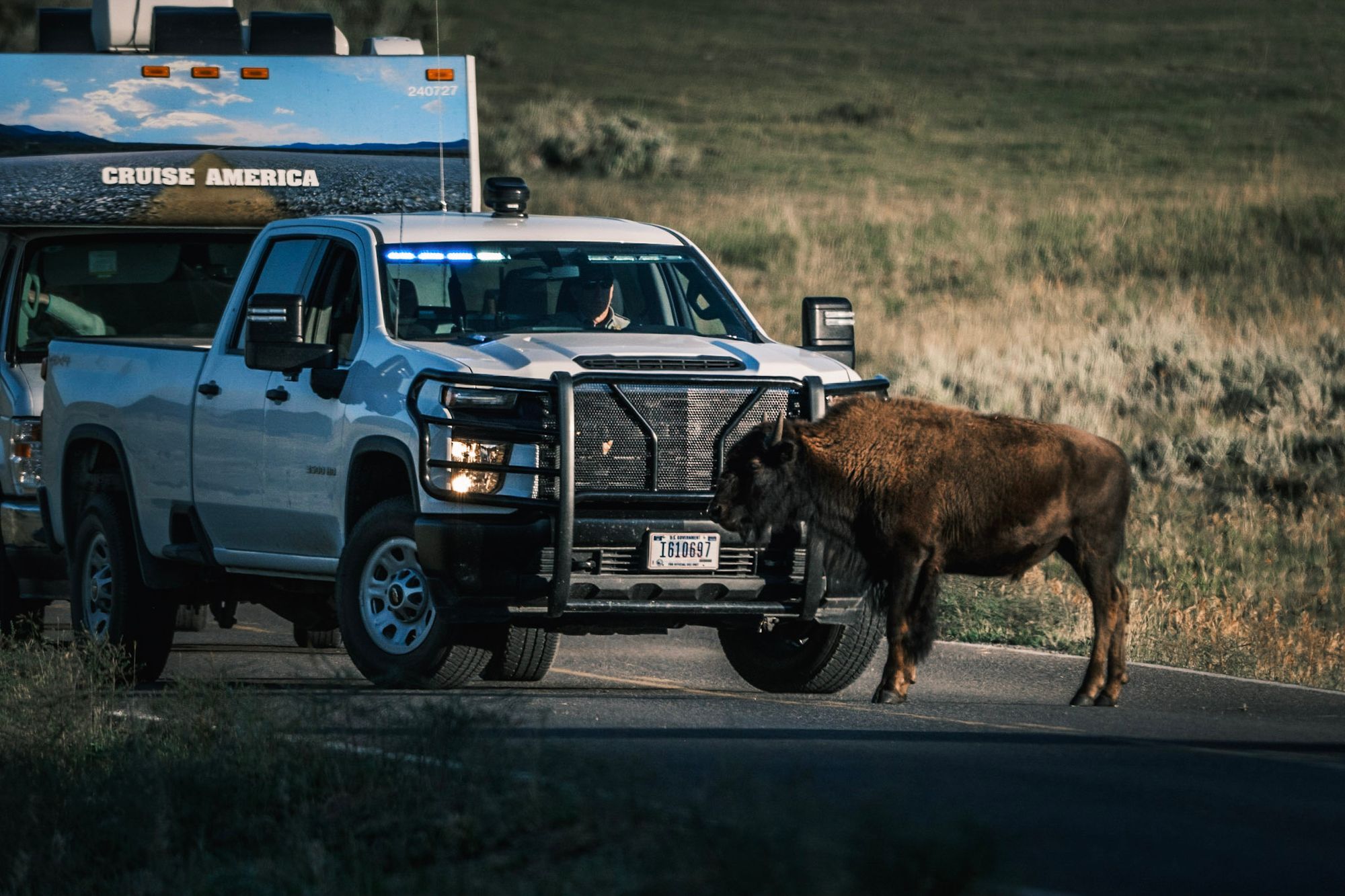
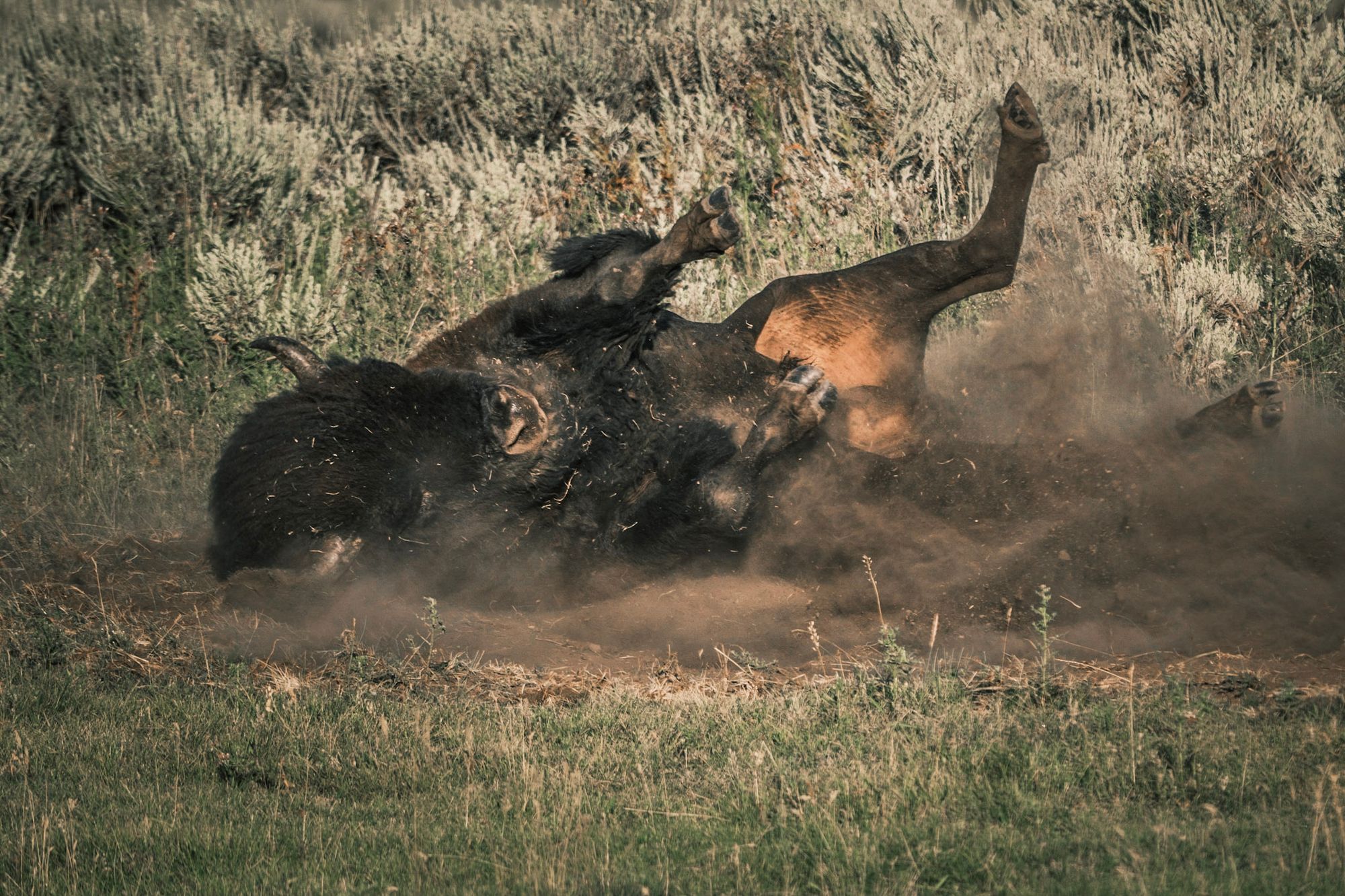
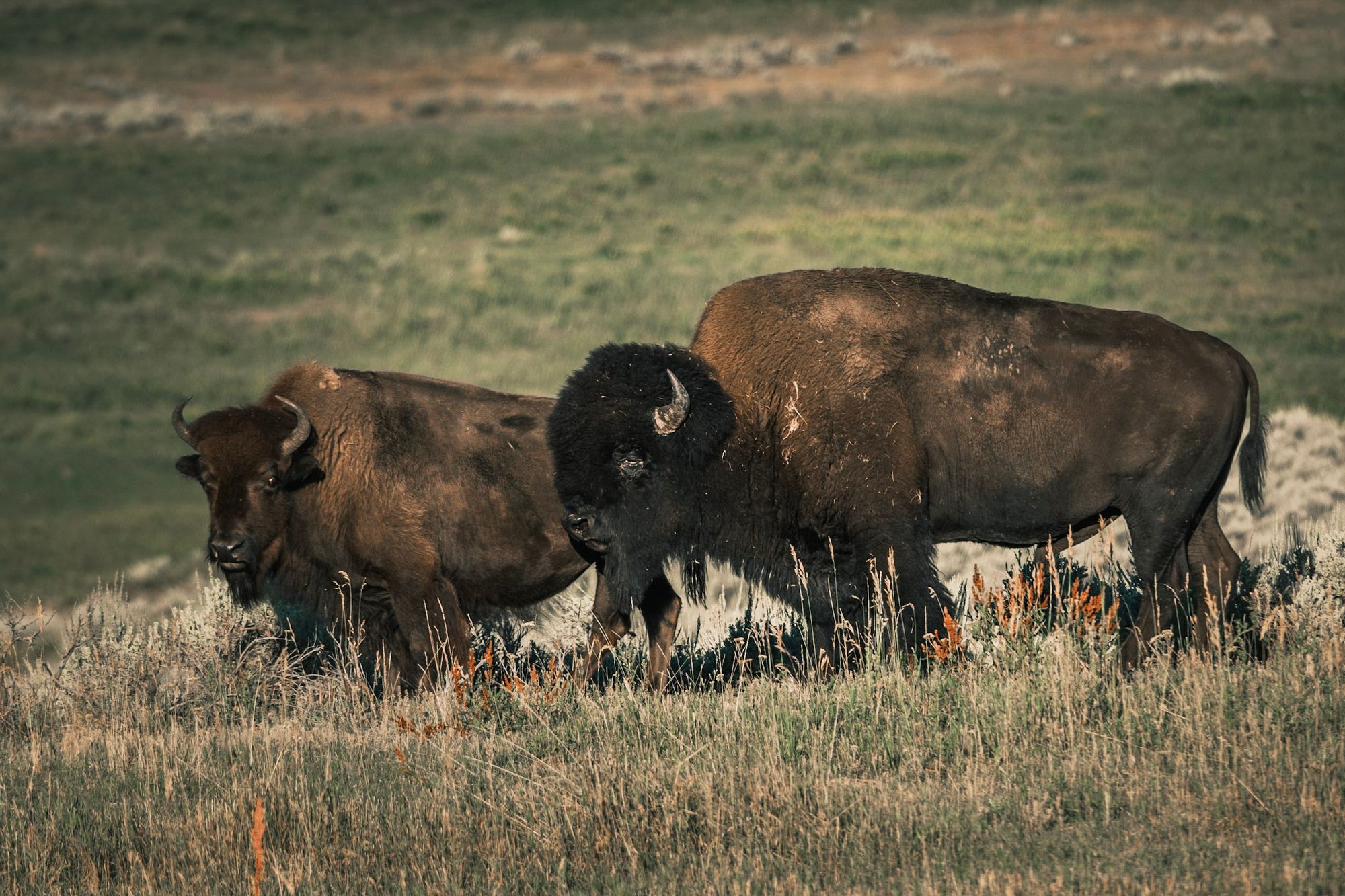
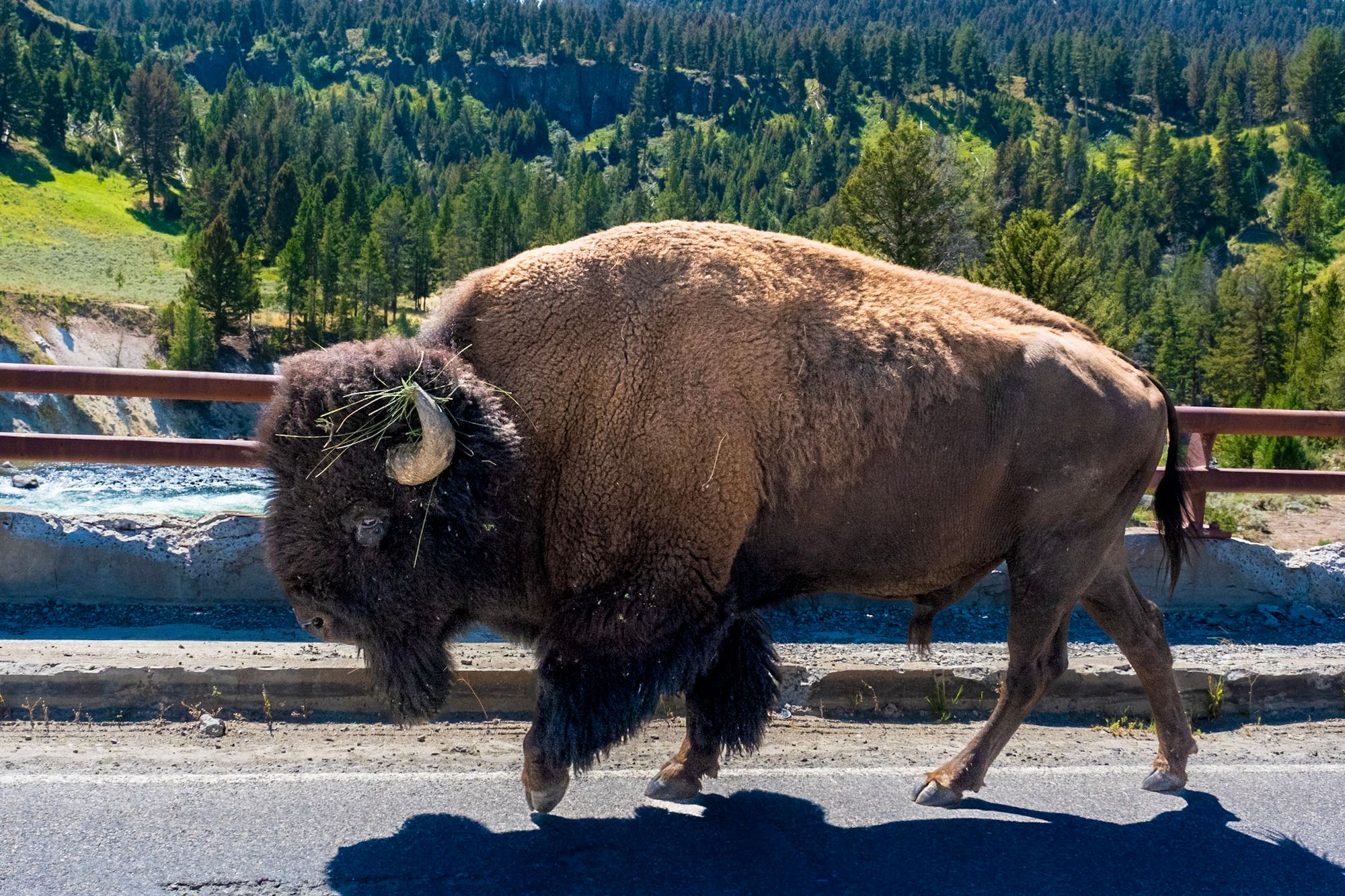
One day over lunch, we visited Tower Fall nearby – it's an easy walk to the waterfall from the visitor center. (And we ate huckleberry ice cream there, which was delicious. The parks out west are full of all things huckleberry).
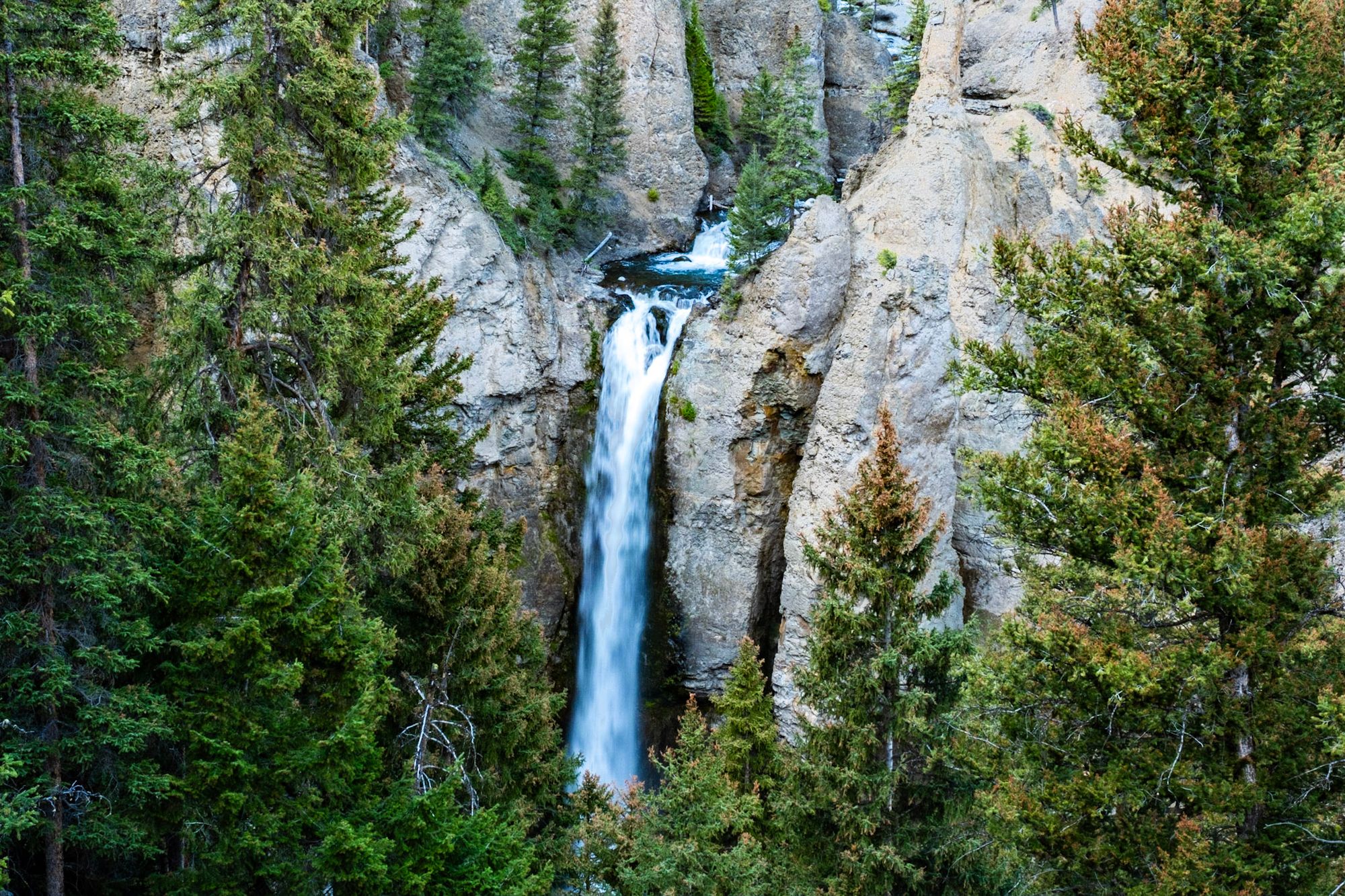
Beartooth Highway
The Beartooth Highway is a scenic road in northern Wyoming / southeast Montana – starting in Cooke City, where we were camping, and traveling almost 70 miles up to the town of Red Lodge, Montana. The drive is absolutely gorgeous the whole way, climbing up to almost 11,000 feet elevation and then winding back down the mountains through sharp switchbacks.
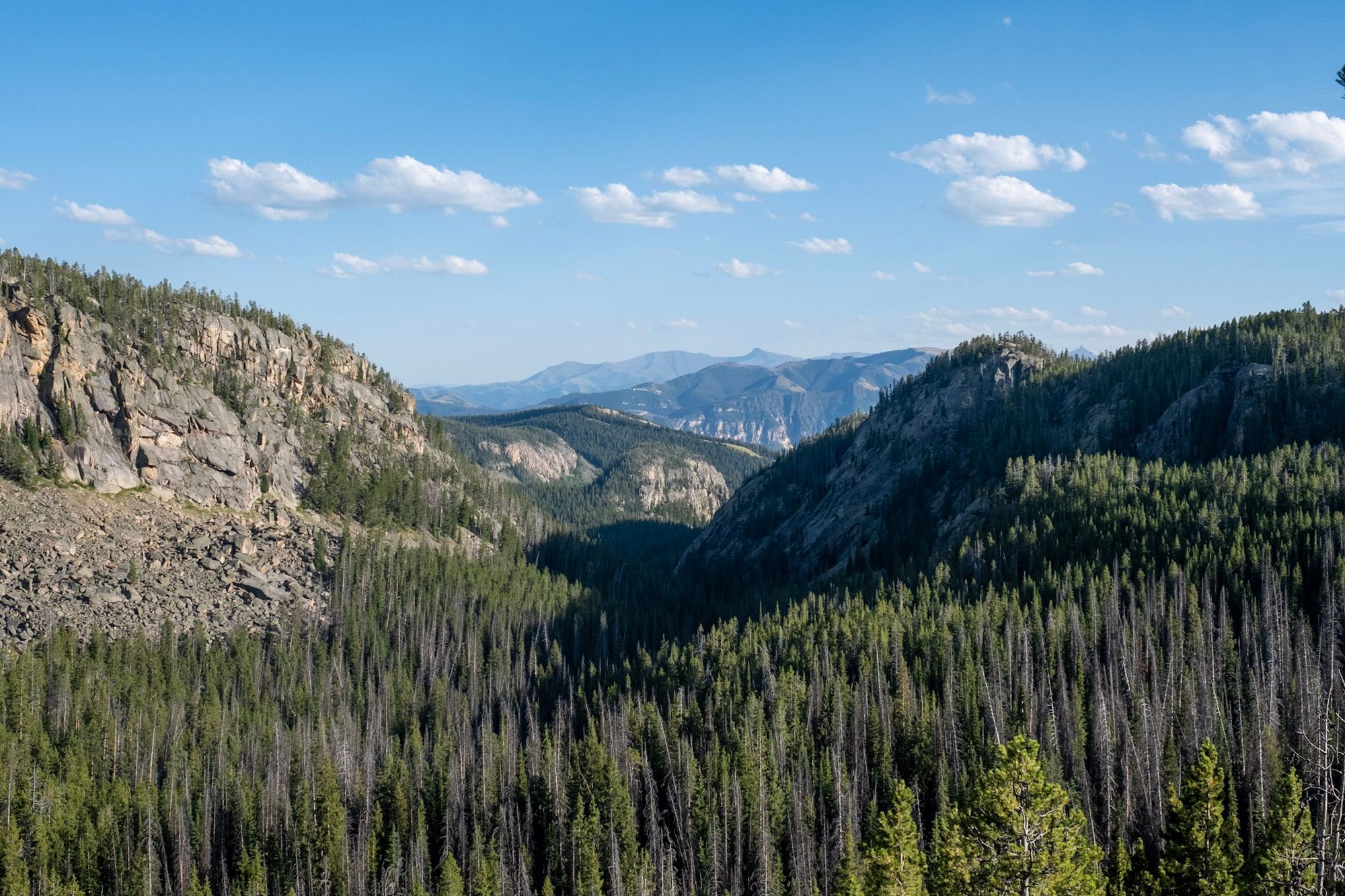
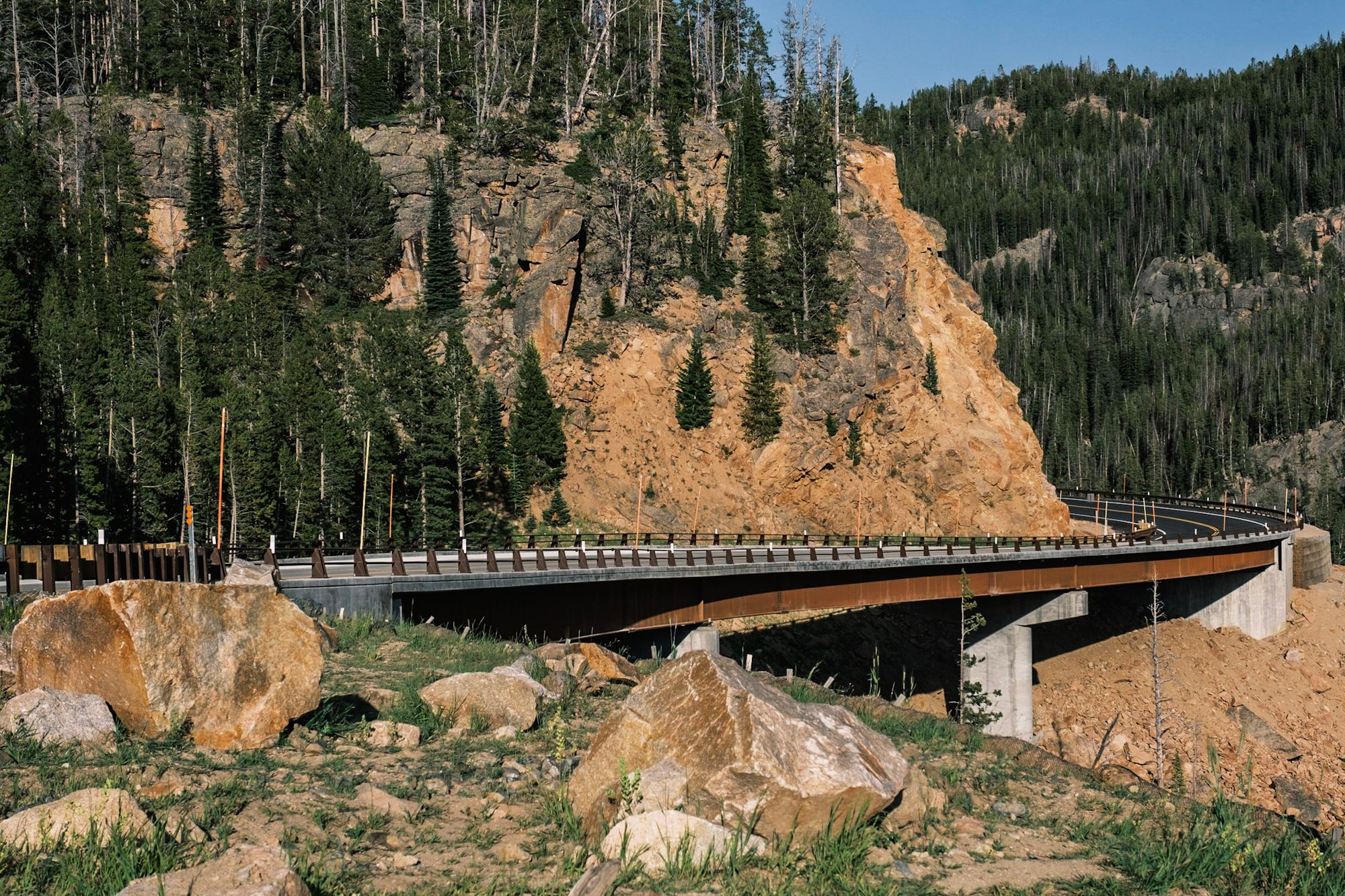
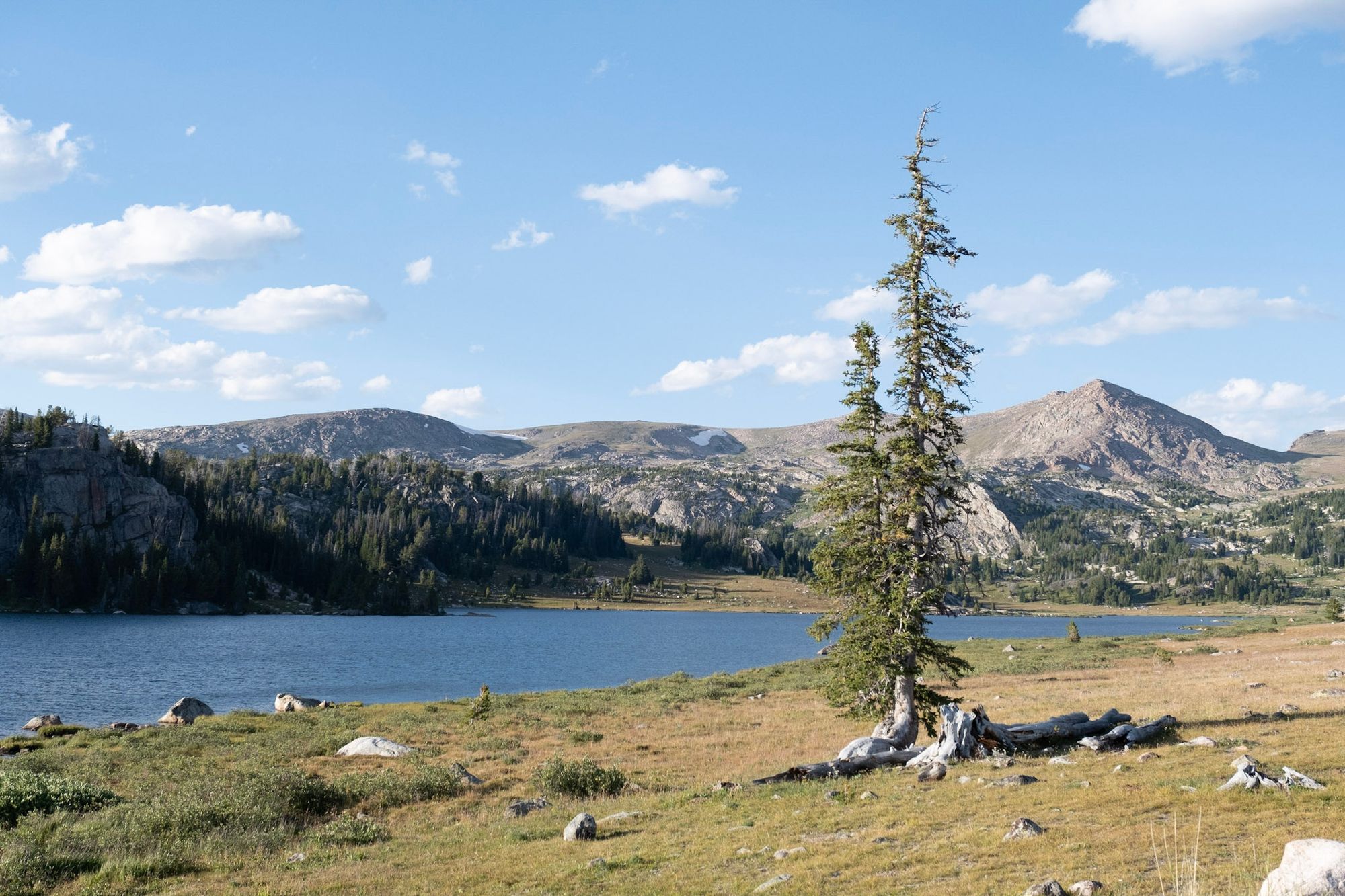
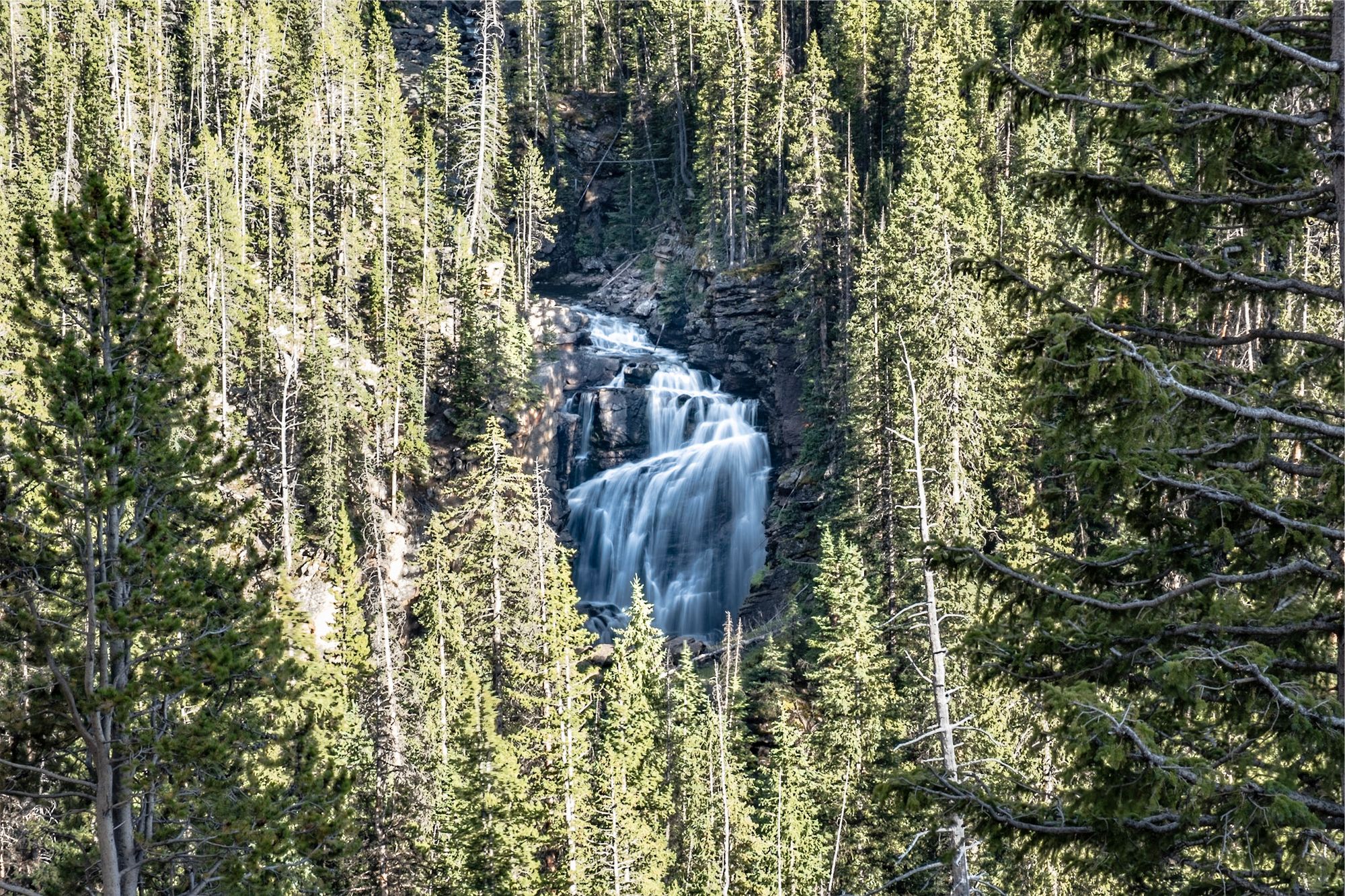
Beautiful views on the Beartooth Highway
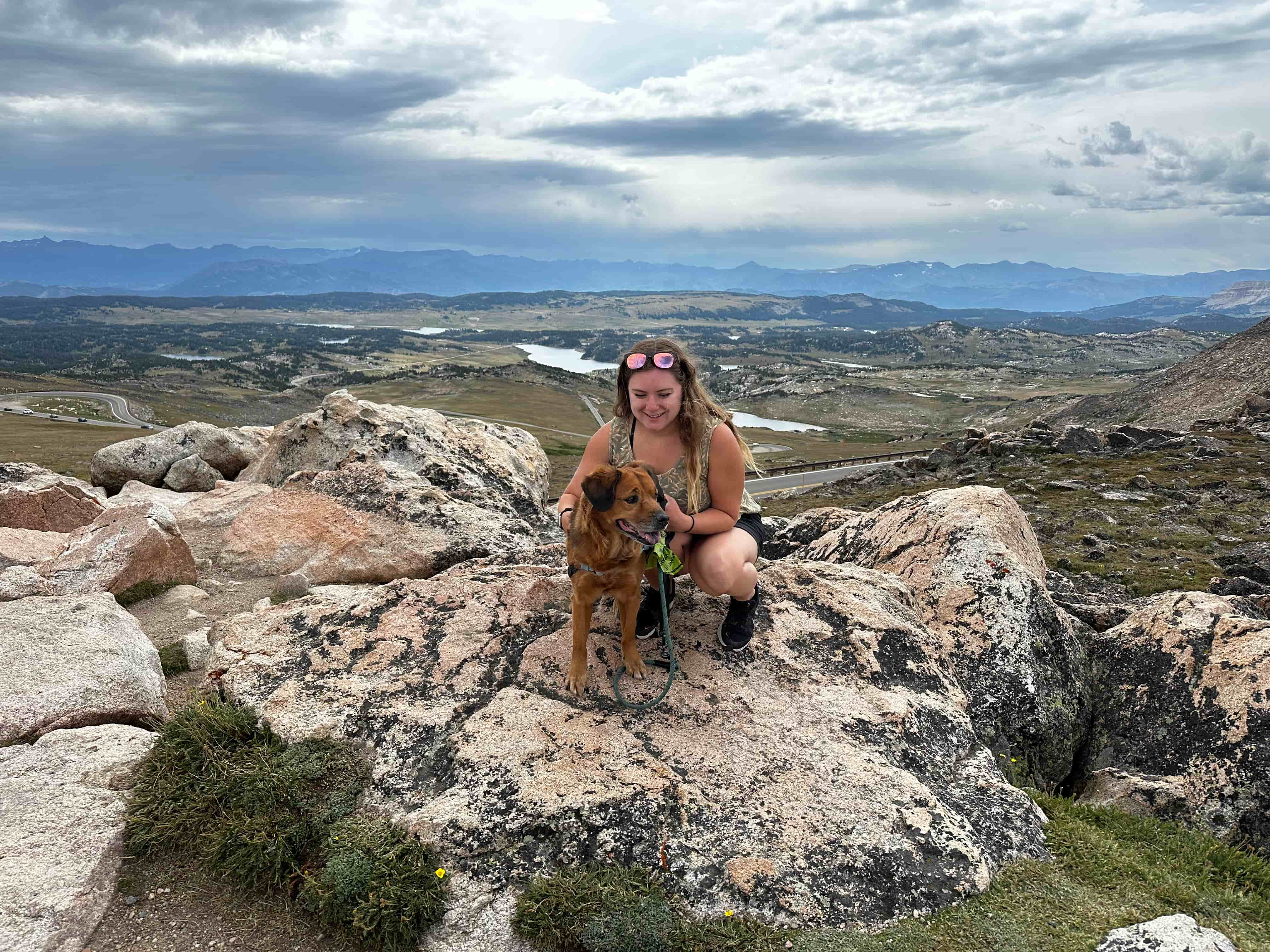
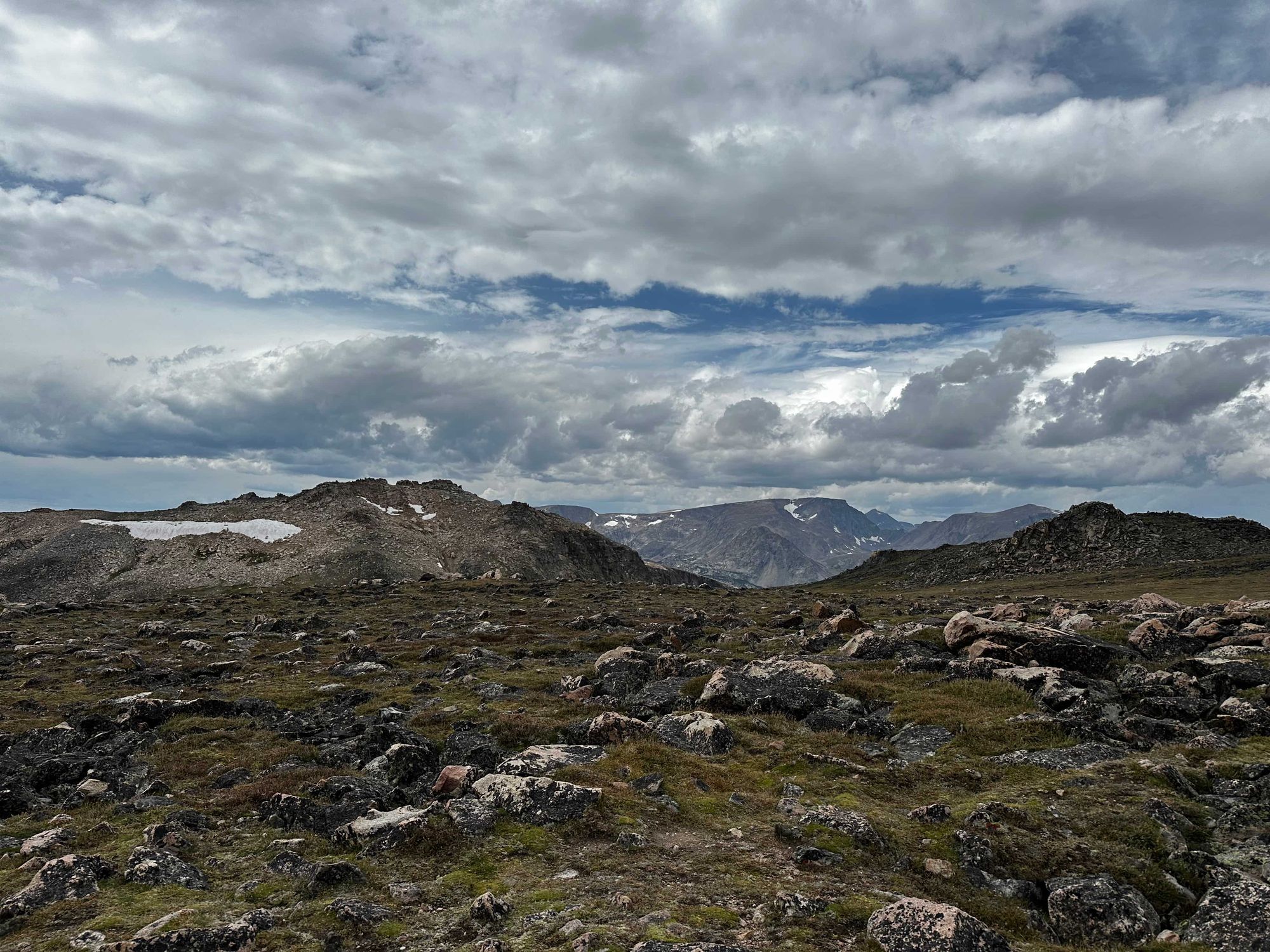
The highest point on the highway – no trees, very windy and rocky, and snow!
At one overlook, there were chipmunks EVERYWHERE, who had obviously gotten very used to people feeding them. The views were amazing, but the chipmunks were the true star of that overlook.
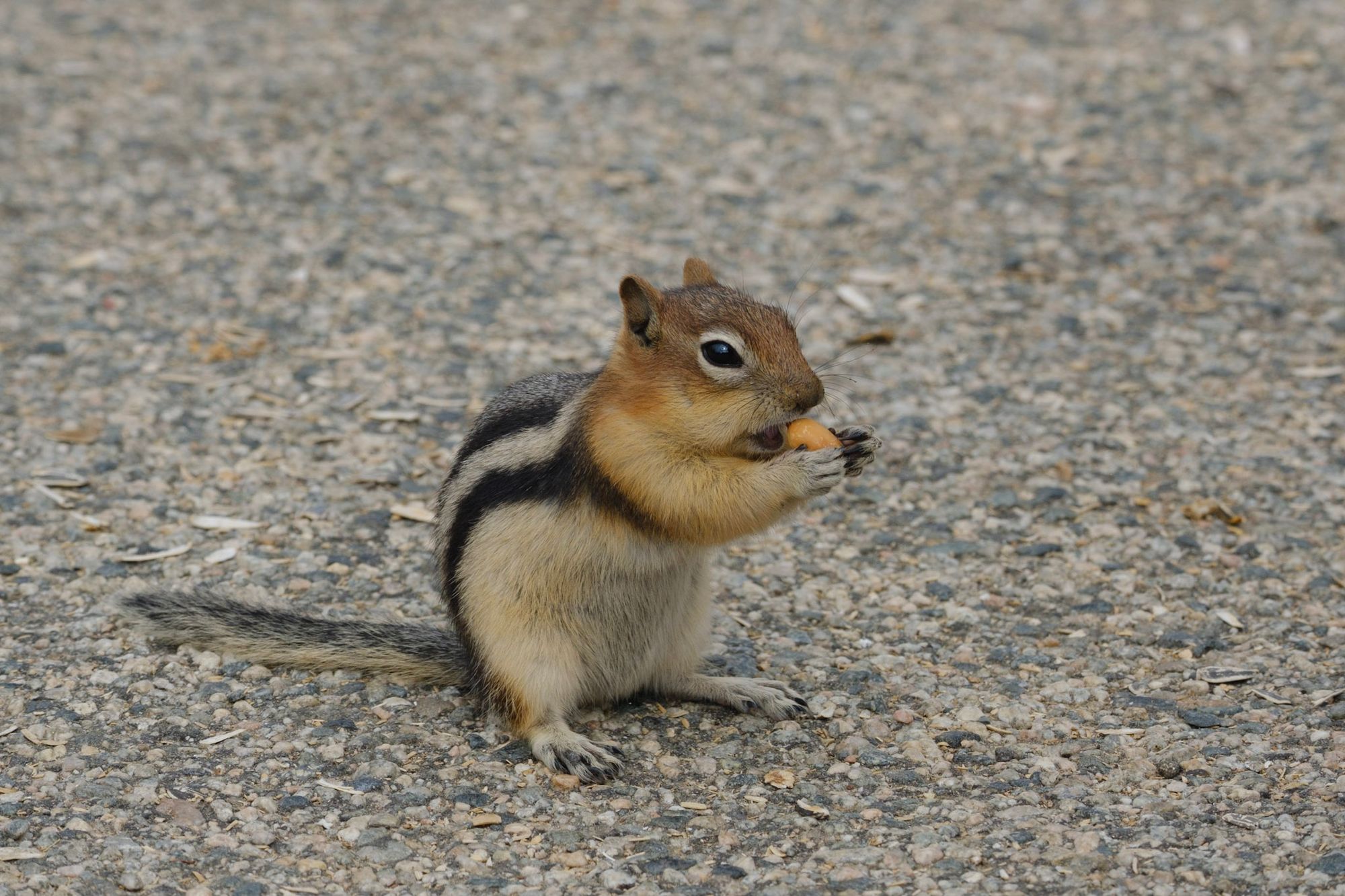
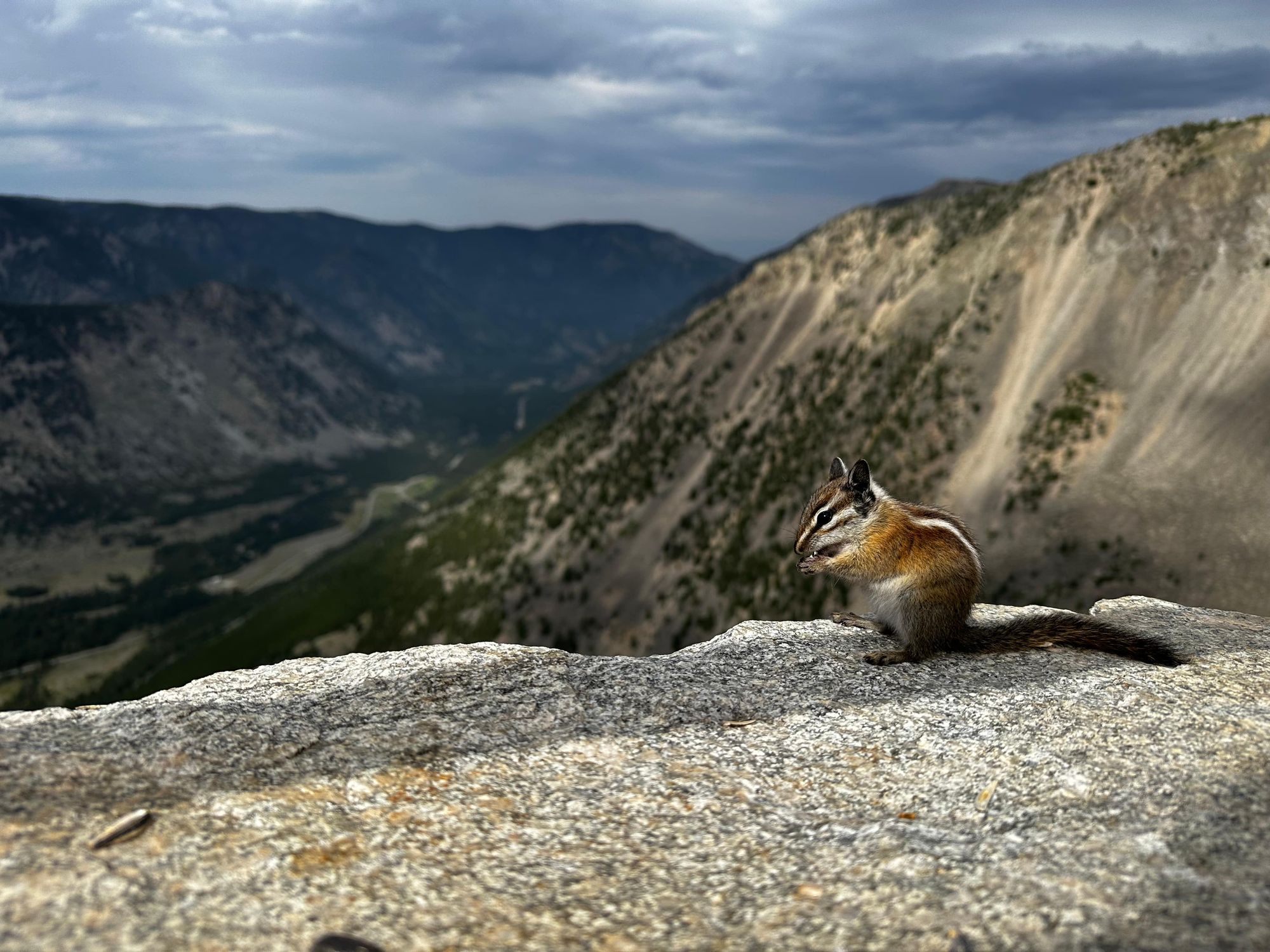
But the best part of the Beartooth Highway was seeing bears UP CLOSE! We were driving by a meadow and saw a few cars pulled over – which usually means wildlife. So we slowed down and saw him: a bear in the middle of the field, just walking around and searching for food. Someone told us they guessed he was a 3-5 year old grizzly – he wasn't huge (and he was very cute) but still powerful-looking.
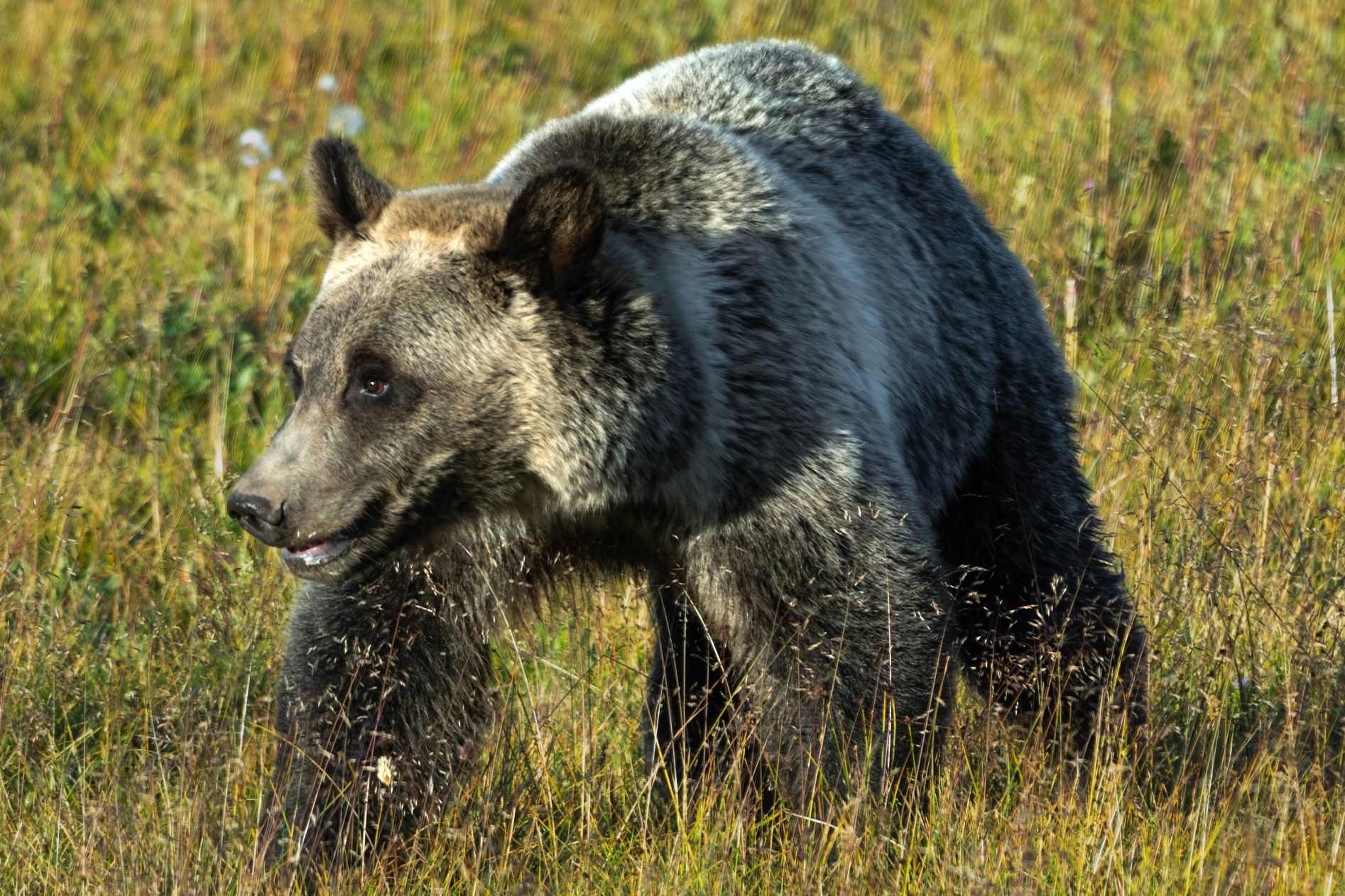
We pulled the truck over and stayed watching him and taking photos for a long time. The photos below are from Joey's telephoto, but he was getting really close anyway – at one point he came right up by the edge of the road, with us on the other side. We weren't too worried since we were by the truck, but at that point we were prepared to jump in and drive away if needed. But Cody (what we named the bear lol) kept moving, and it was all good. It was so crazy seeing a grizzly that close – he was probably twenty or thirty feet away at the closest.
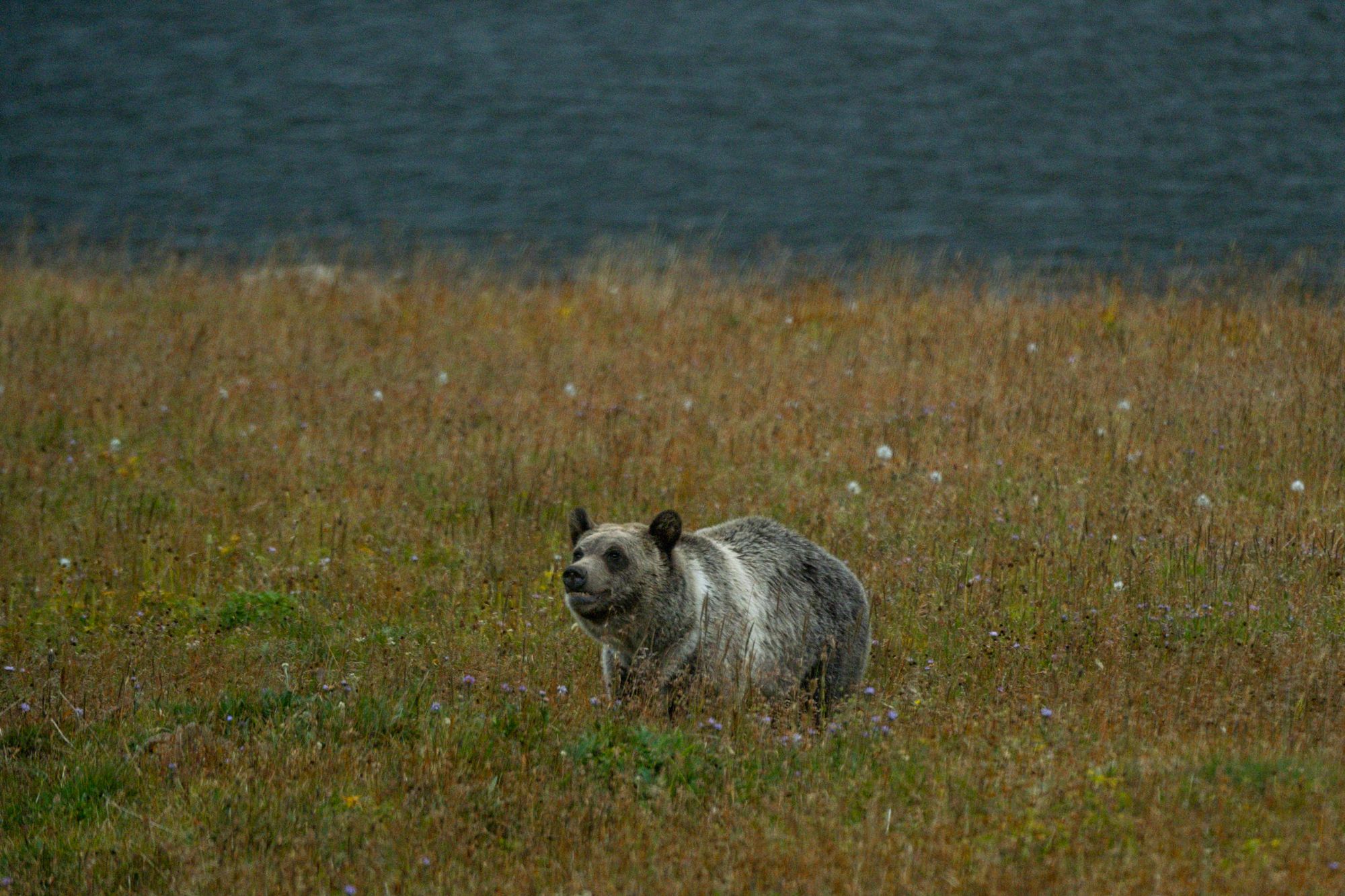
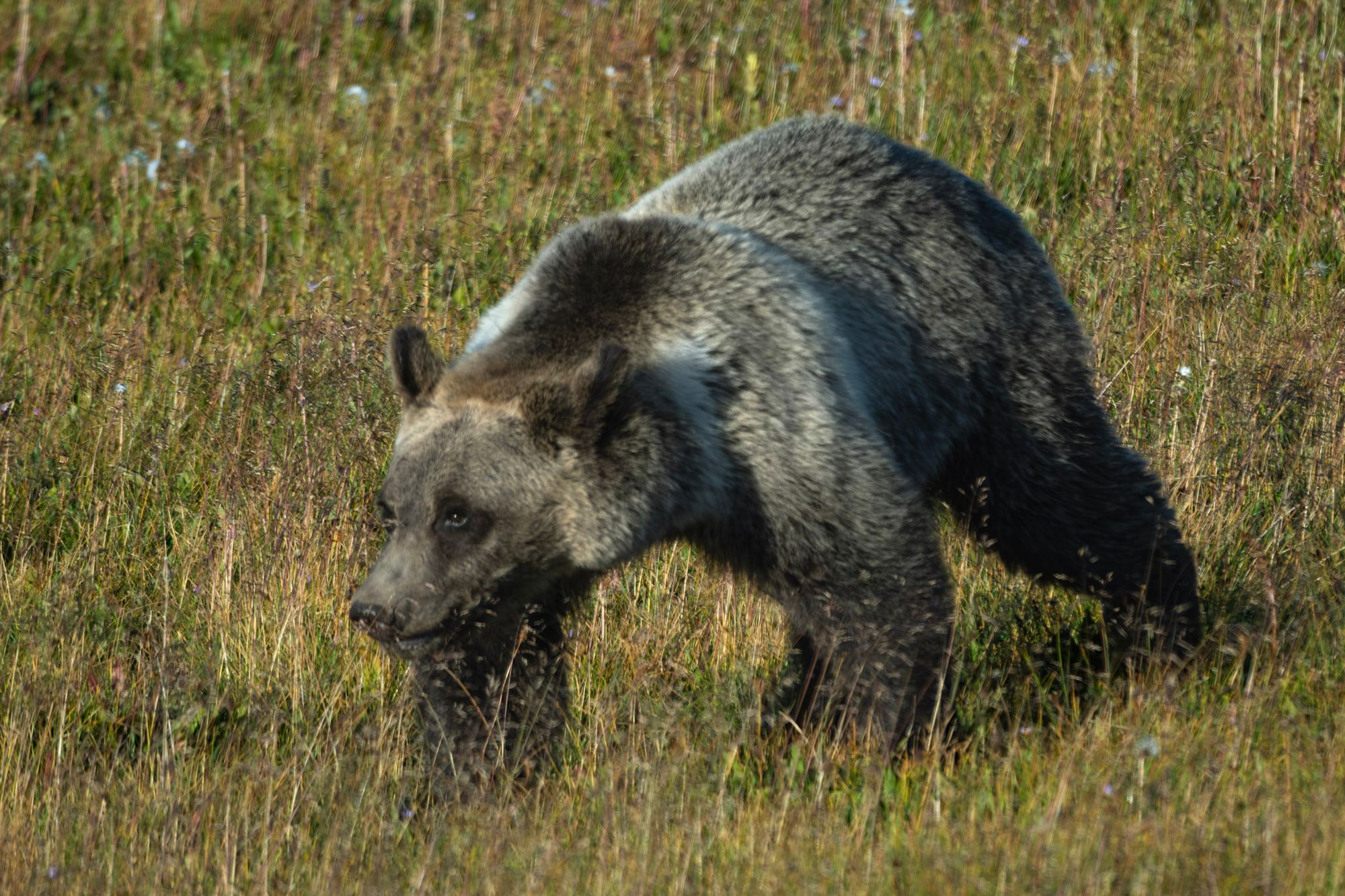
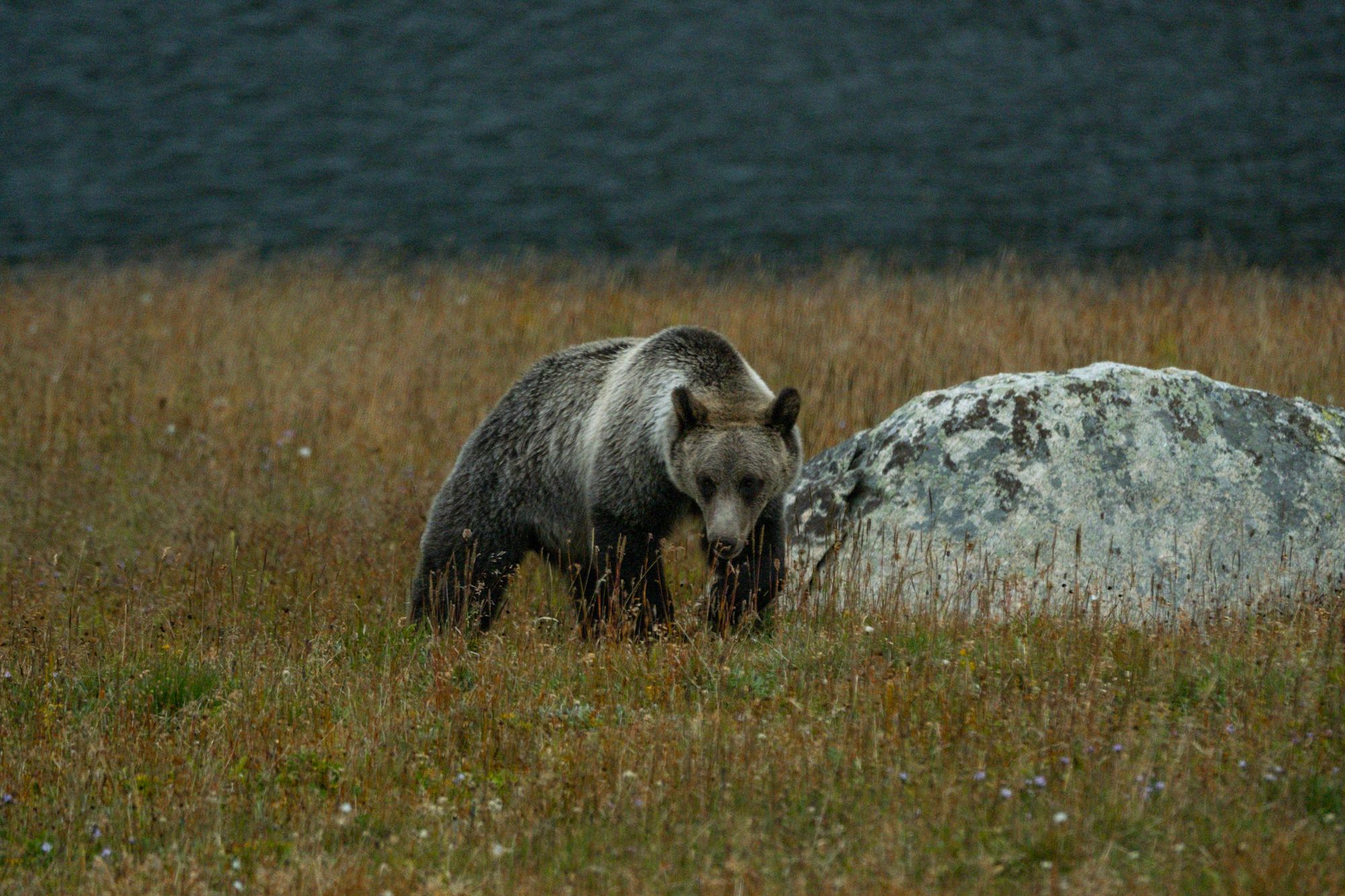
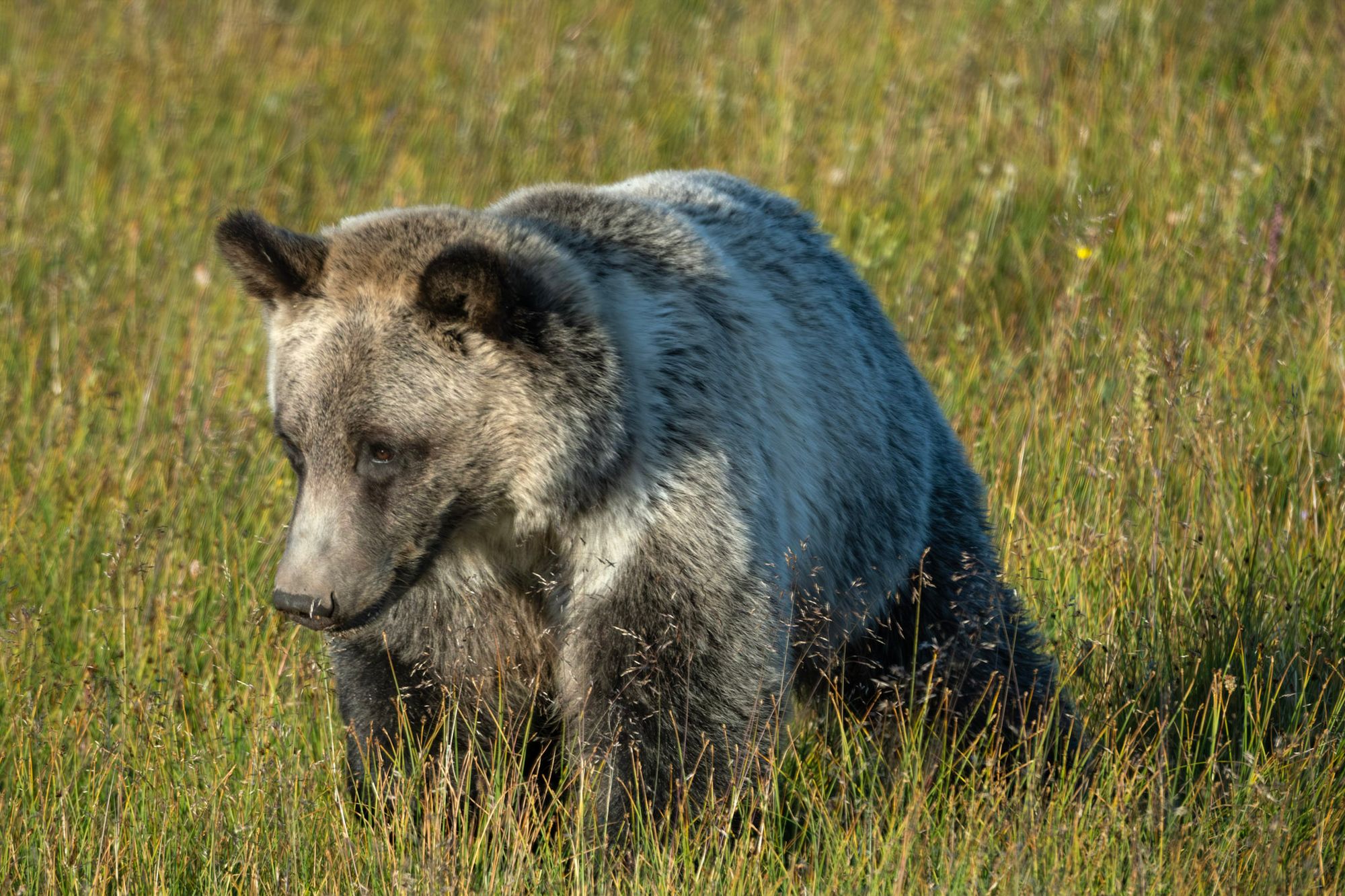
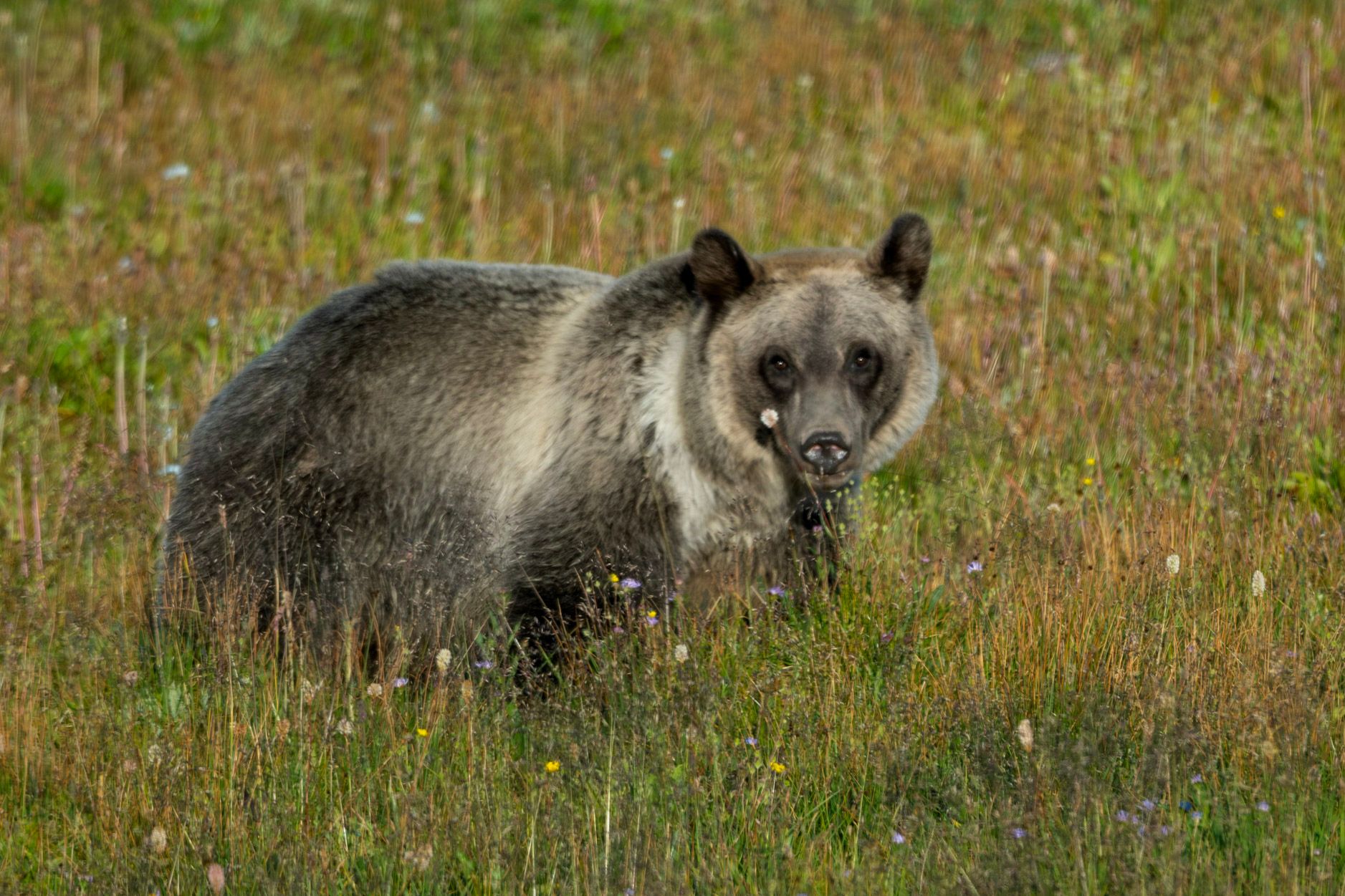
The next day when we came back, we saw Cody again near the same place. And on another part of the road, we turned a corner and saw a black bear crossing the road right in front of us! The Lamar Valley gets all the hype, but the Beartooth Highway was by far our best wildlife watching area. It was SO cool.
And that's a wrap on our week in Yellowstone! I feel like I've ended every blog this way, but we definitely plan on going back. There is still SO much of the park we didn't see, and it's just such a unique place. Despite the crowds, in some places you can truly feel like you're in deep wilderness, and it's nice to be reminded that there are places in the U.S. like that.

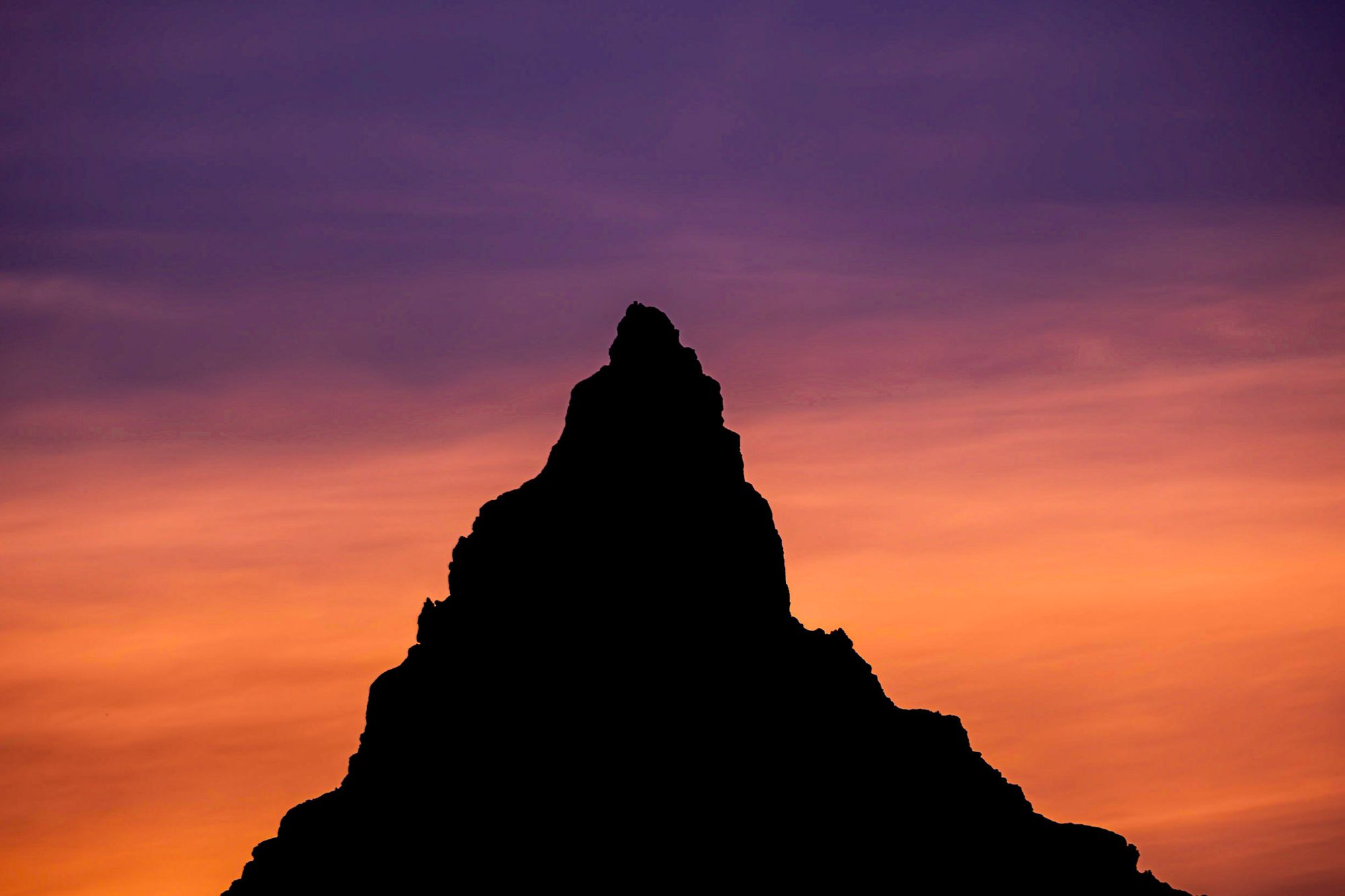
Member discussion